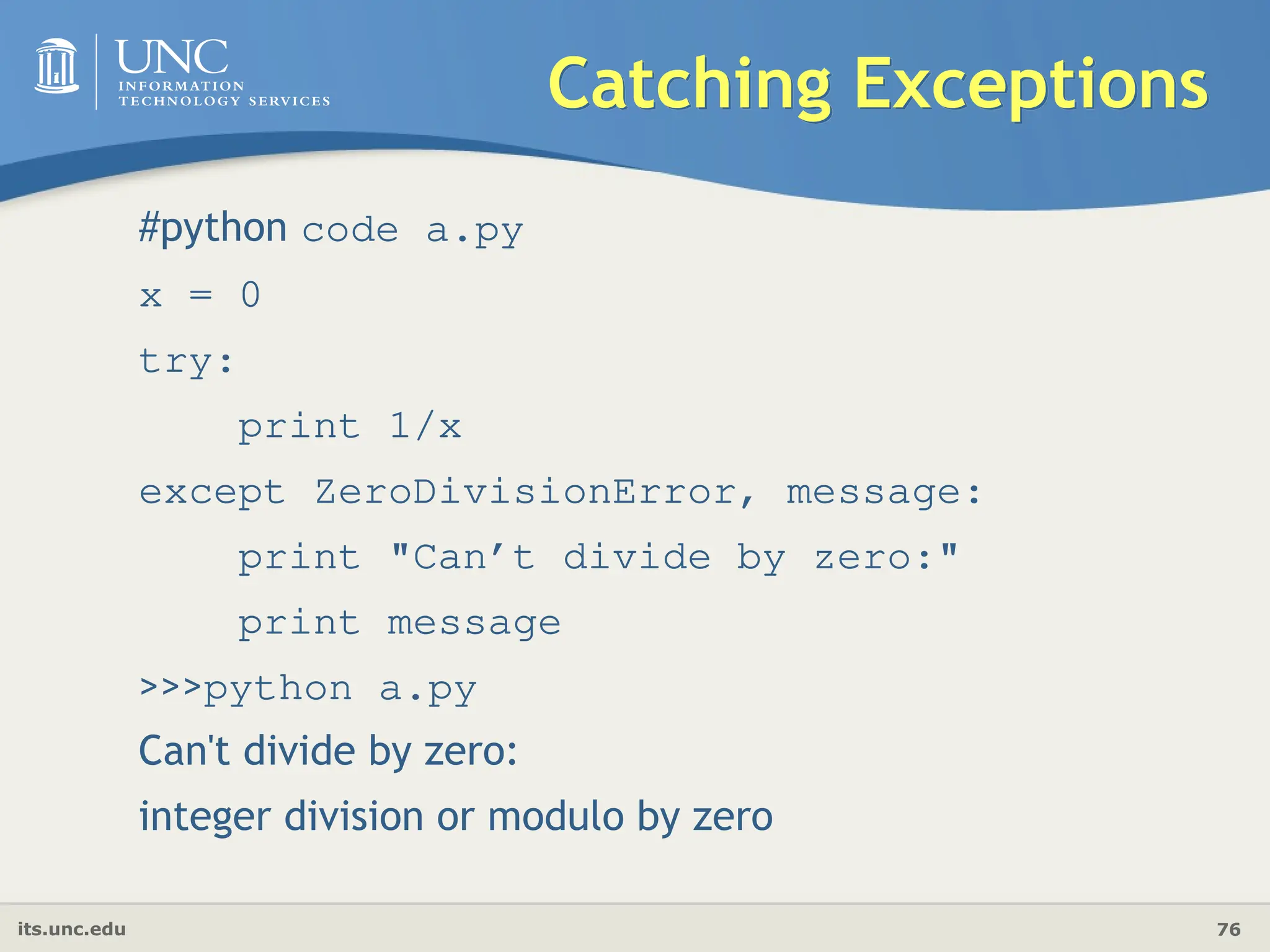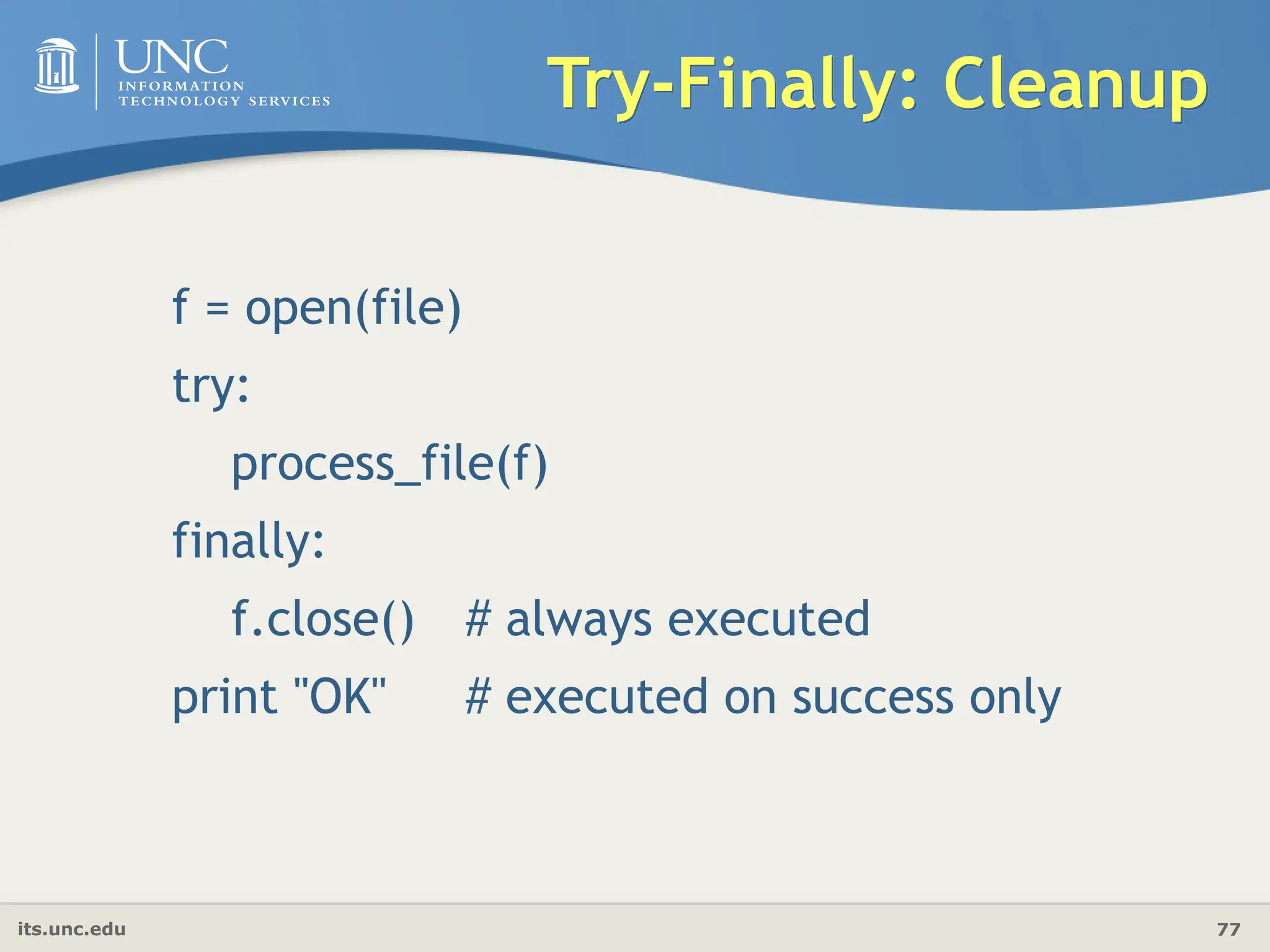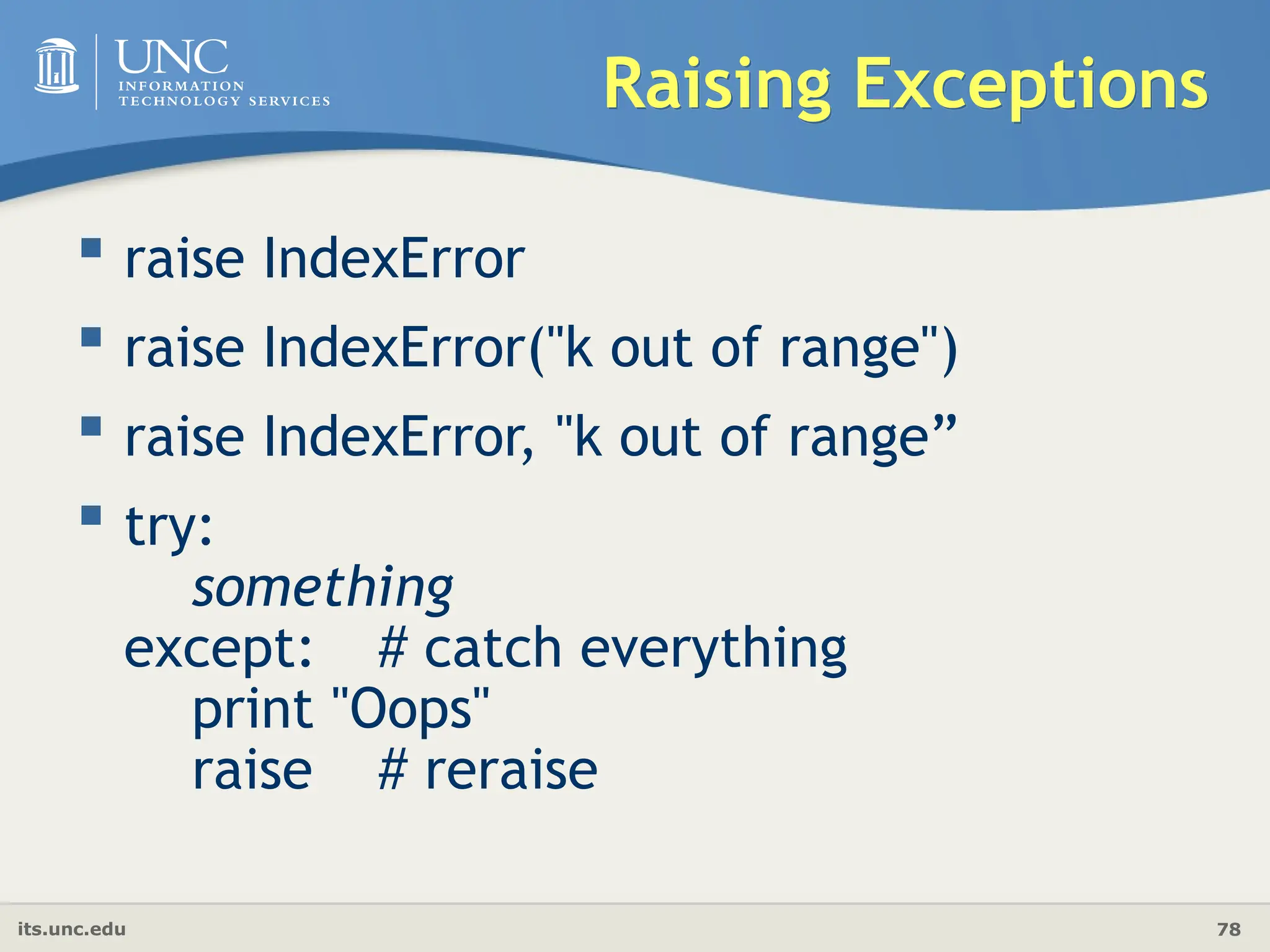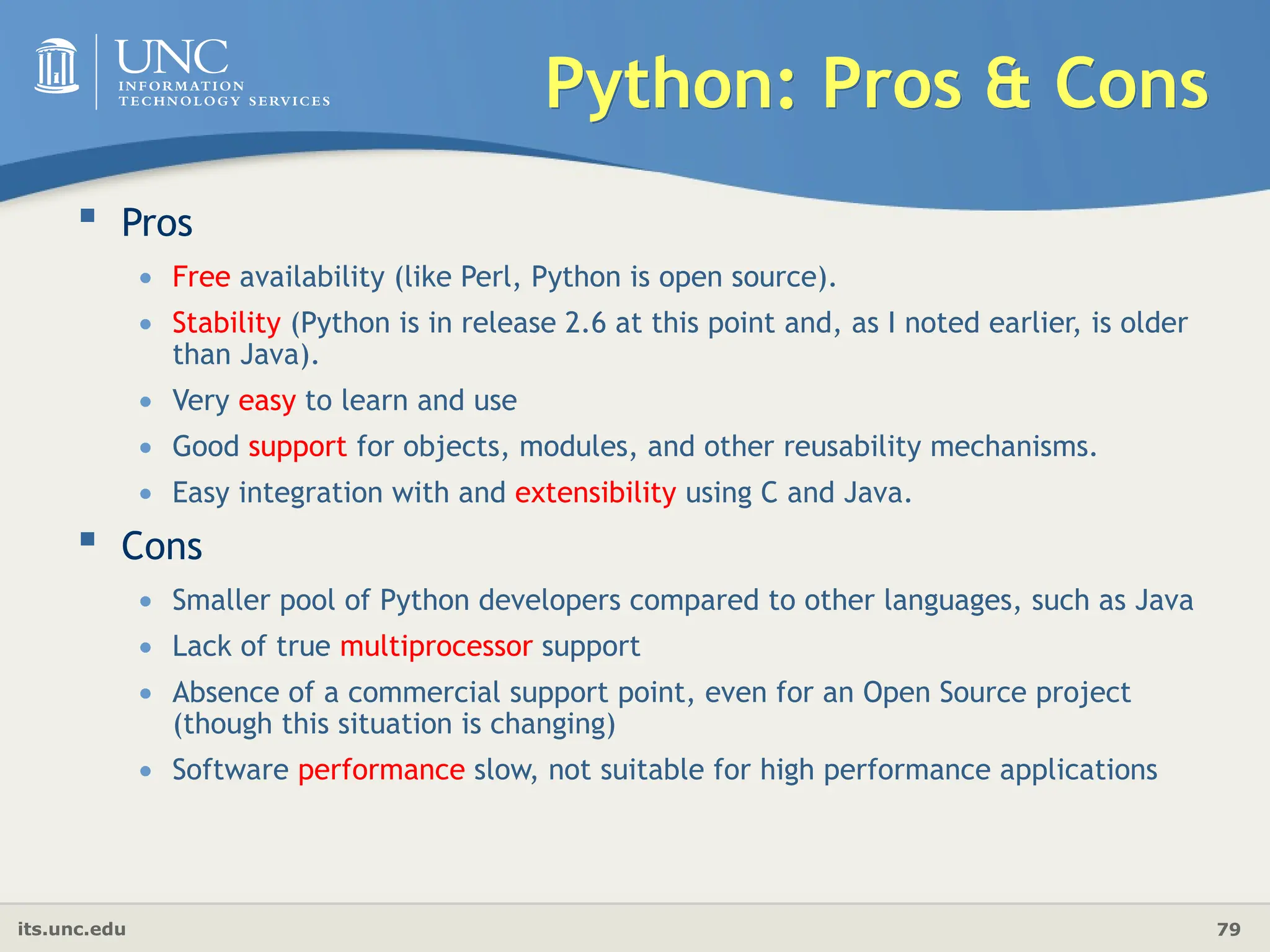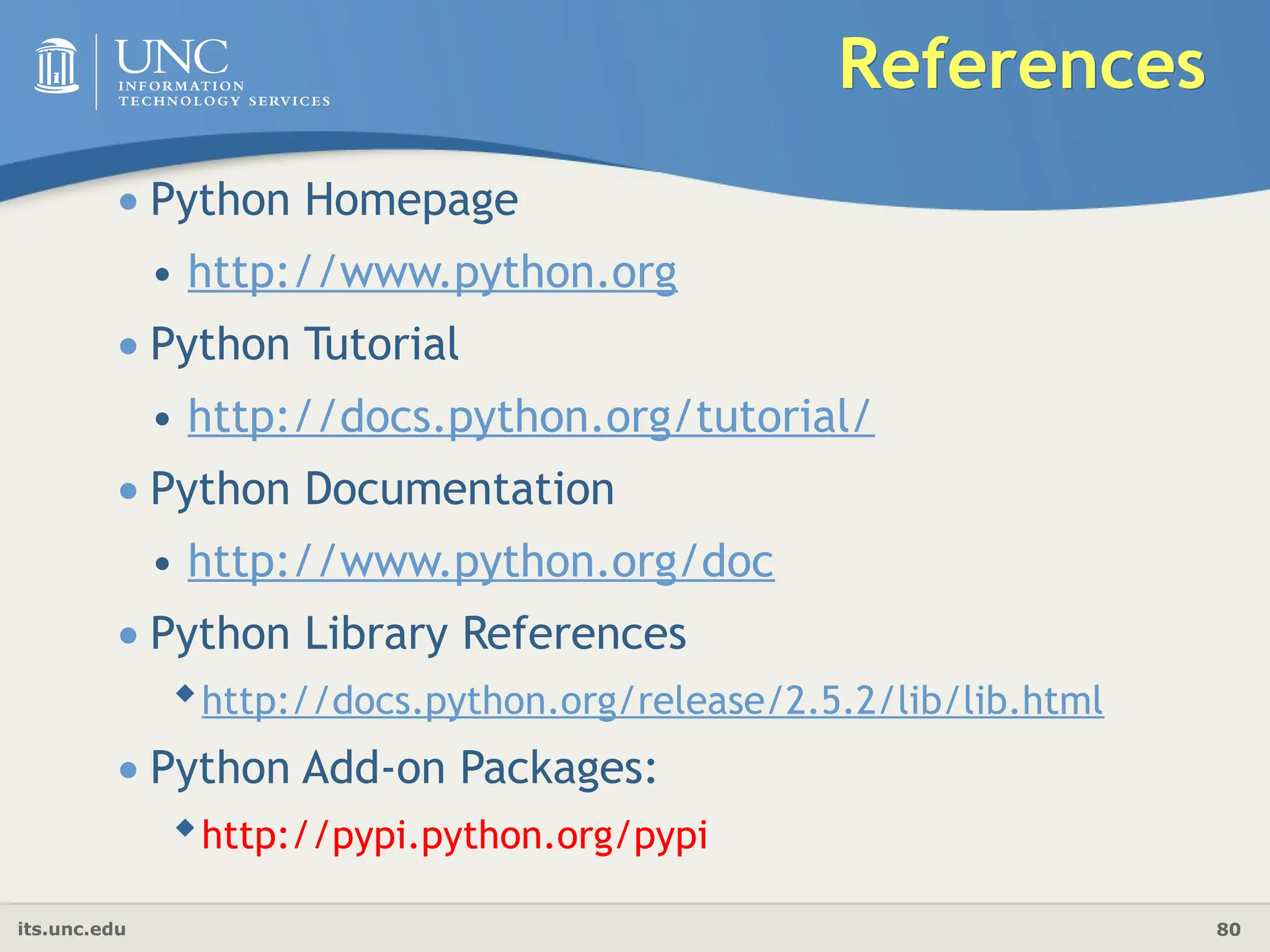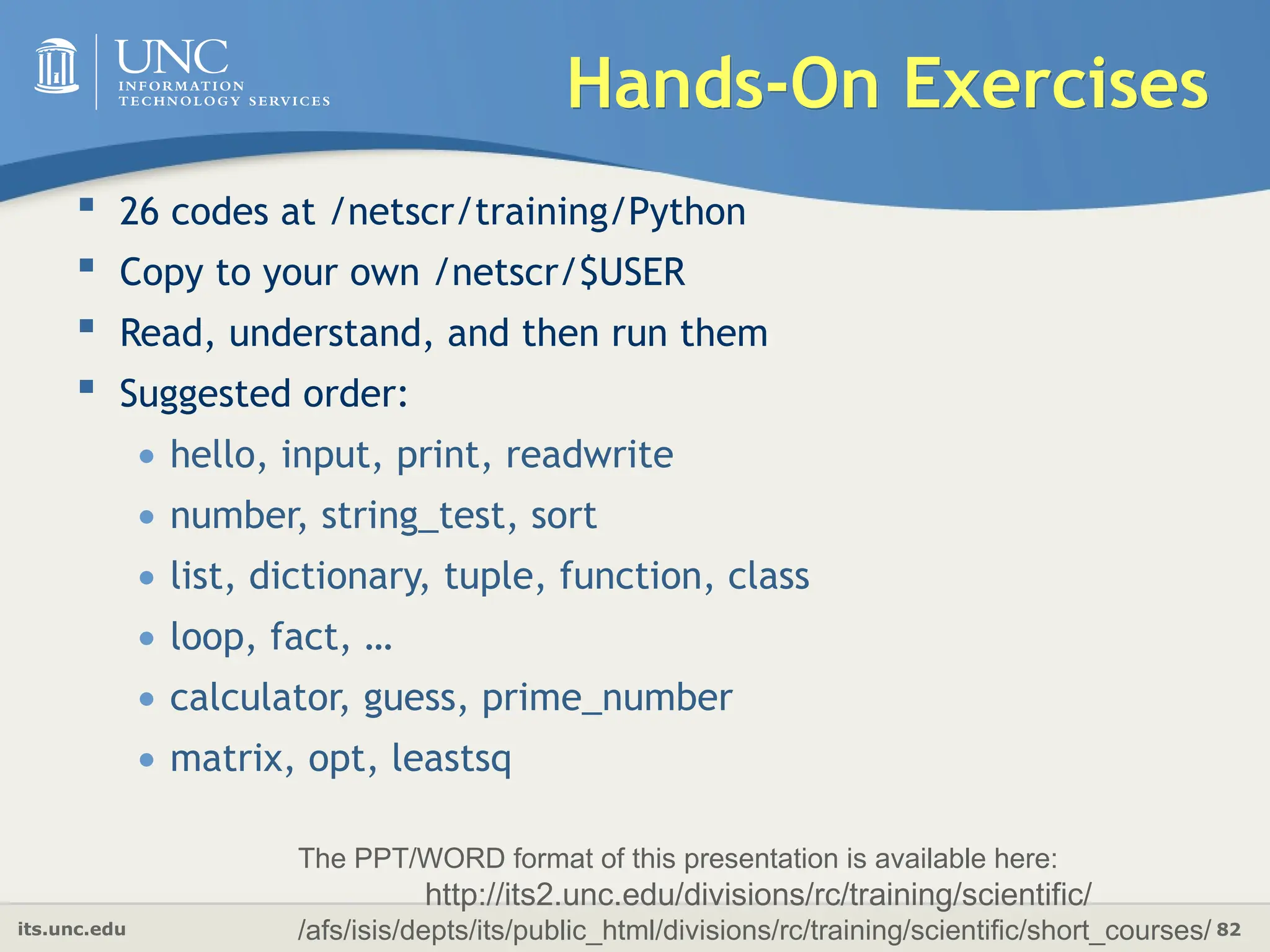This document is an introductory presentation about Python programming, covering its basic structure, syntax, and practical applications. It aims to equip learners with the skills to run Python scripts, understand data types, and perform basic programming tasks. Additionally, it includes hands-on exercises and comparisons with other programming languages.
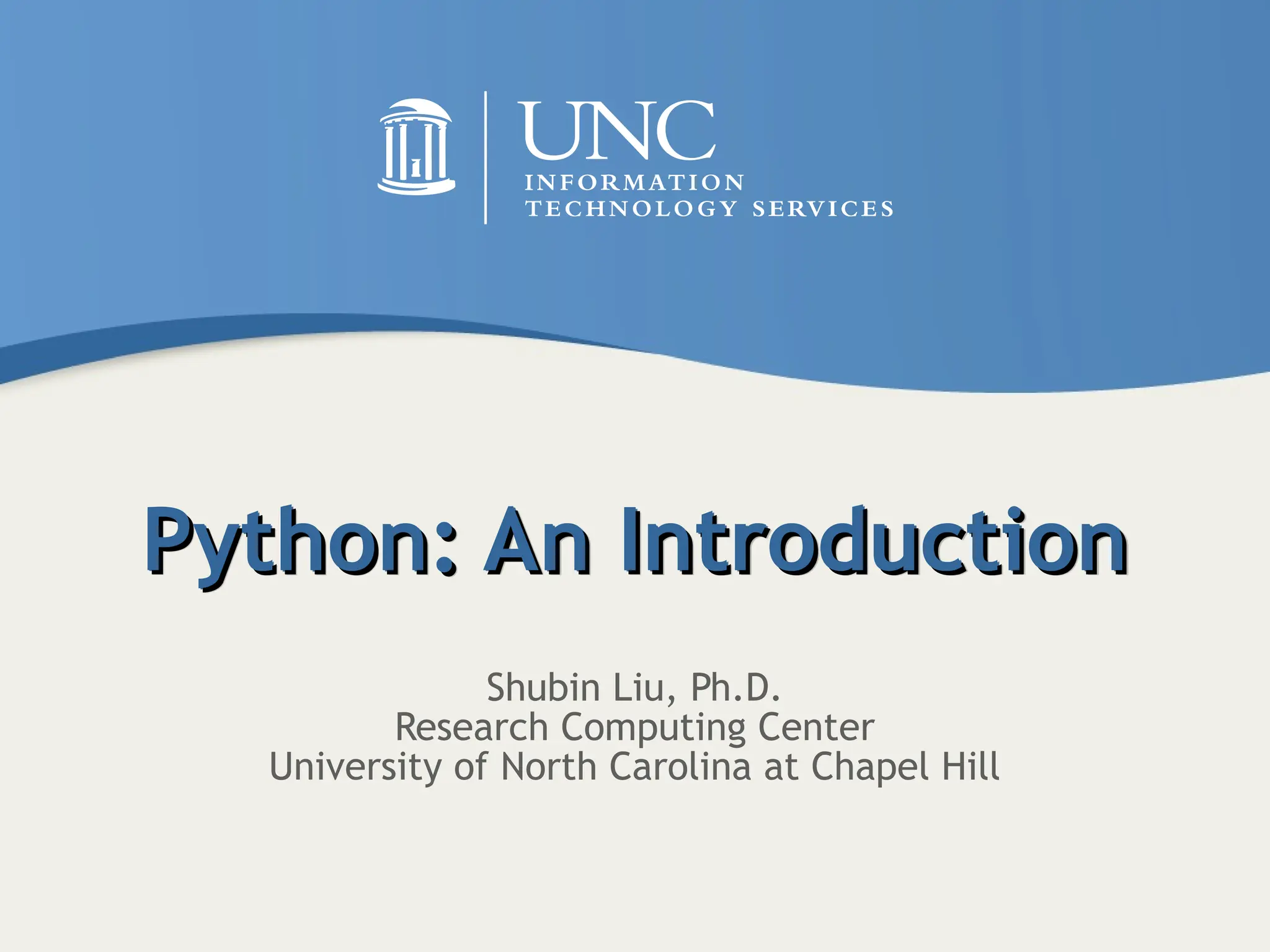
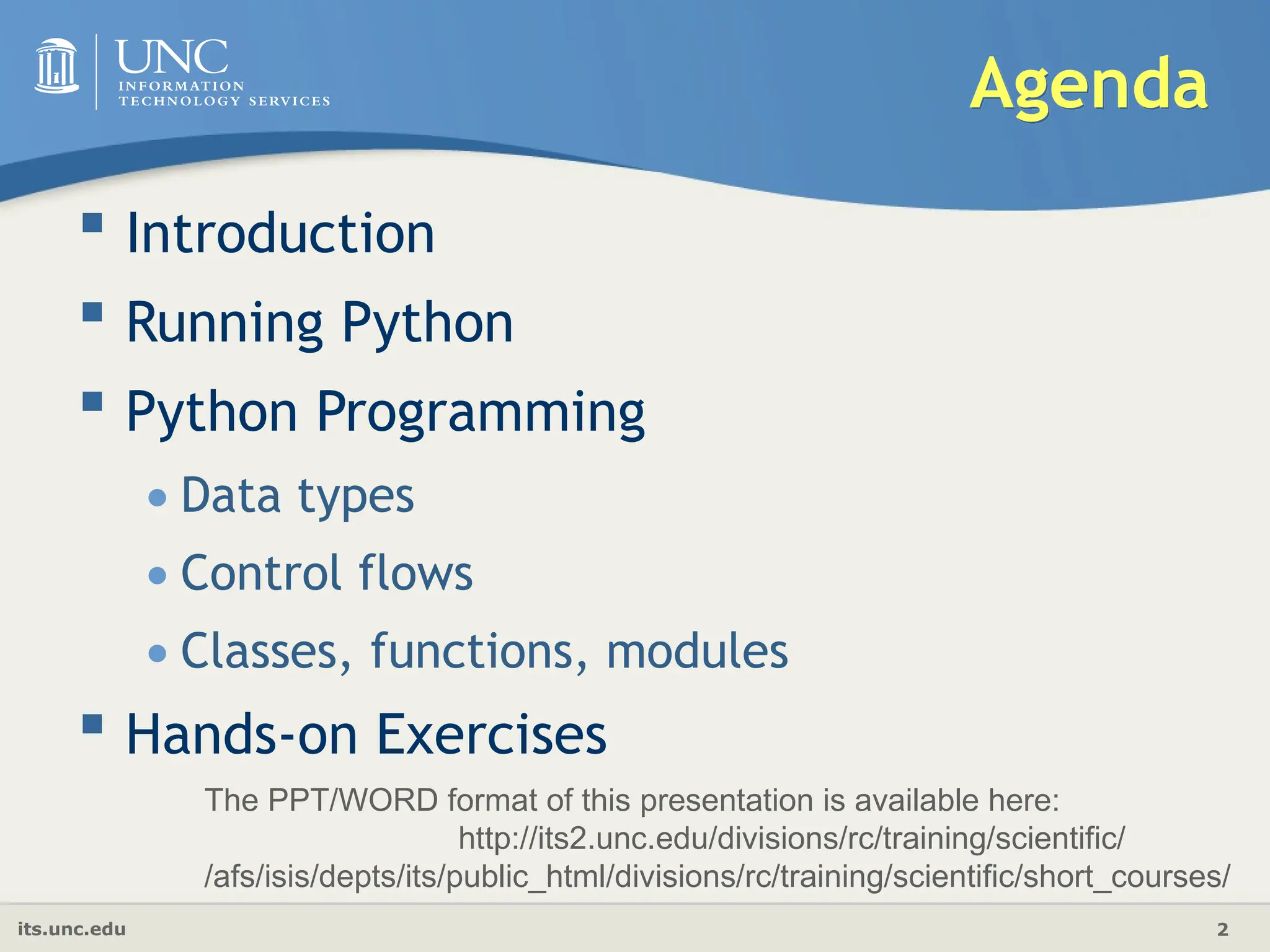
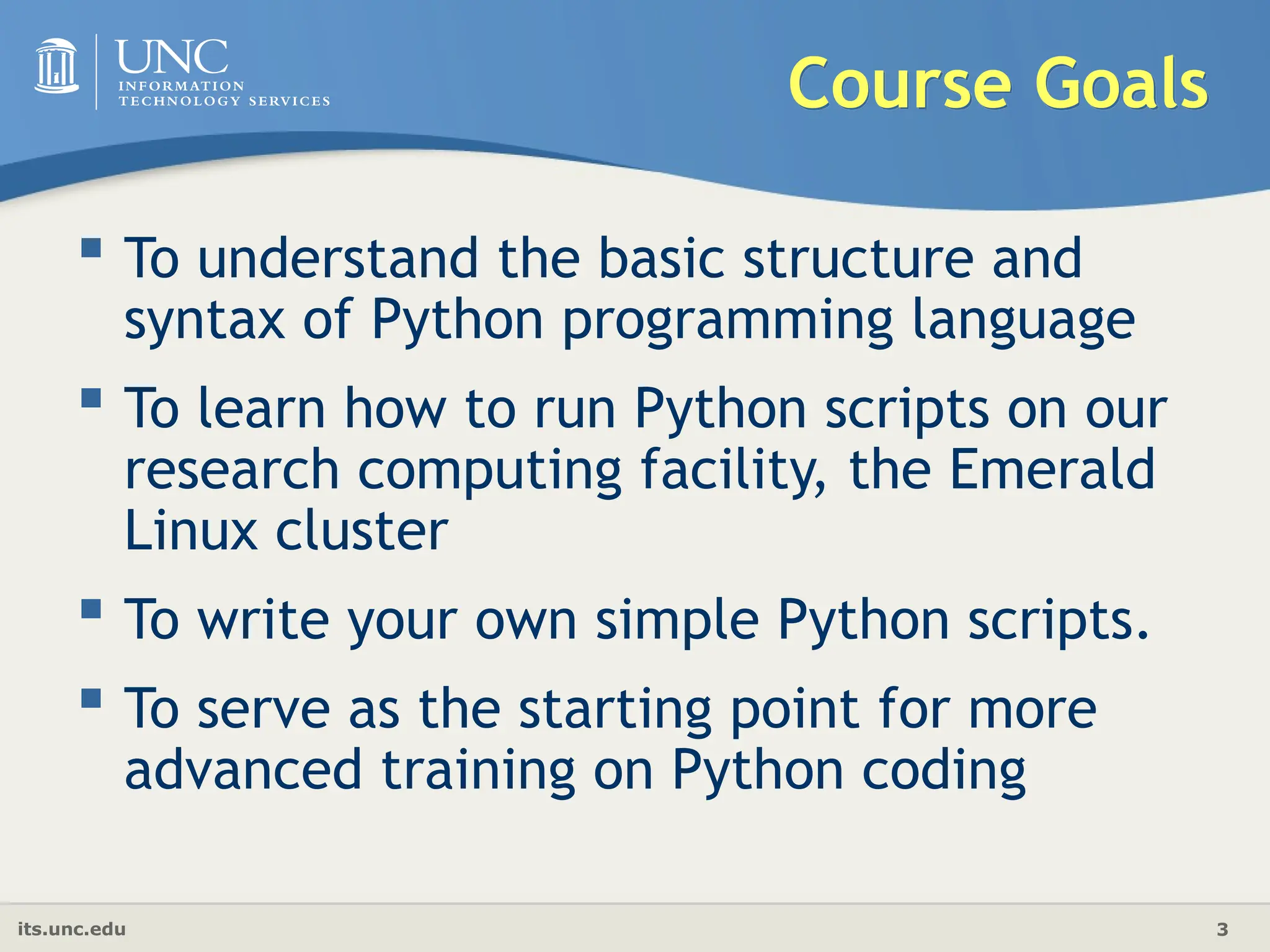
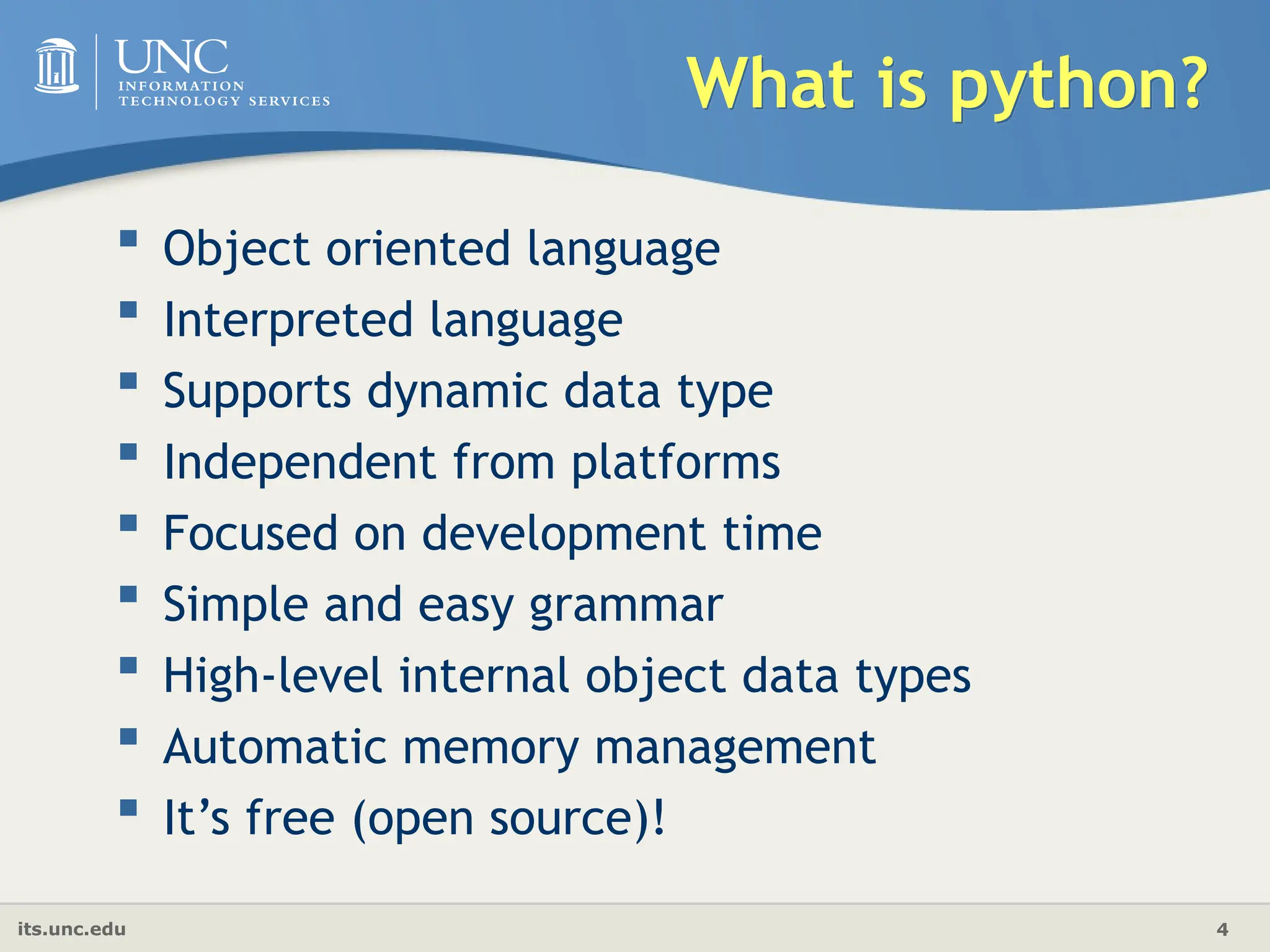
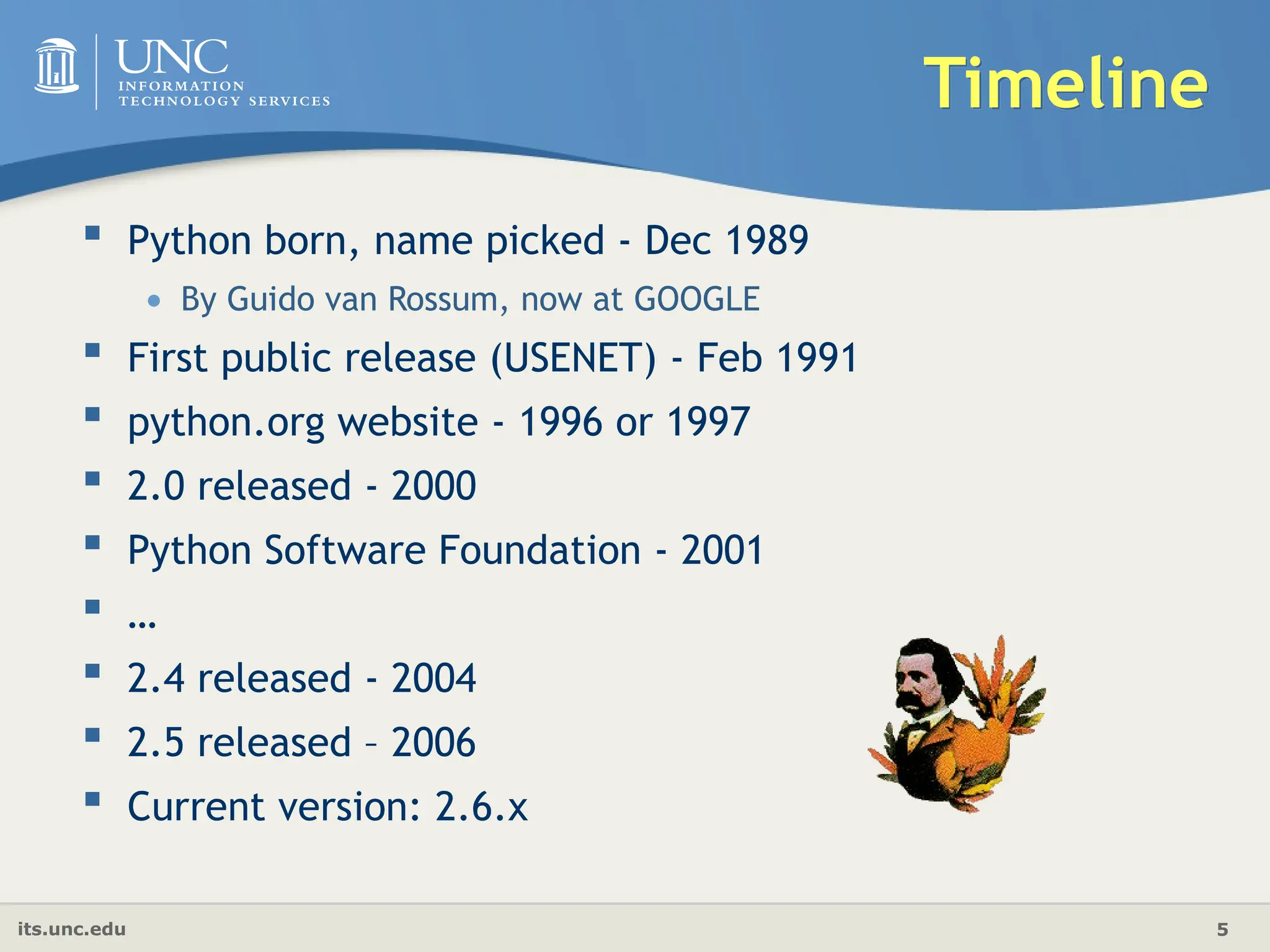
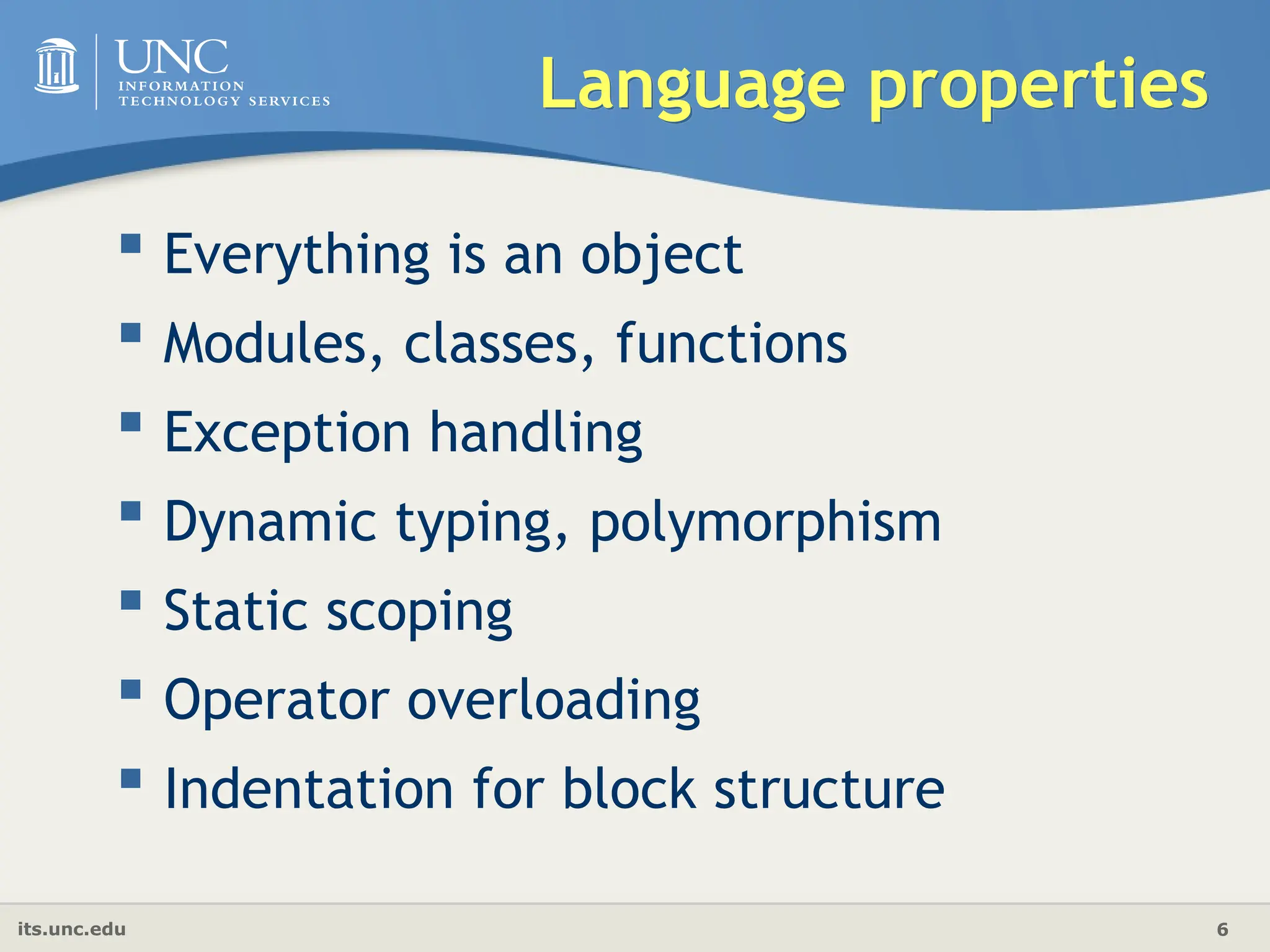
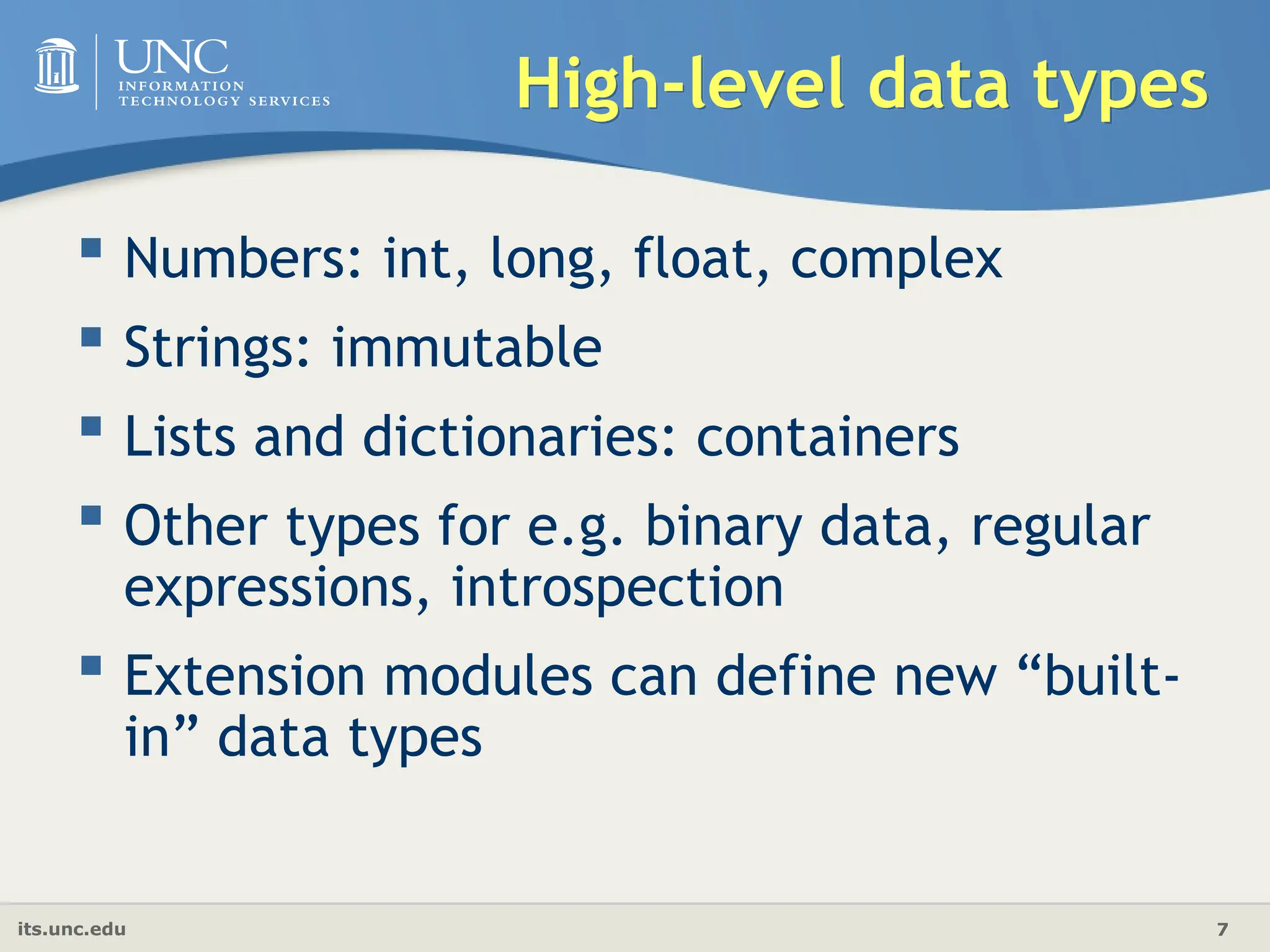
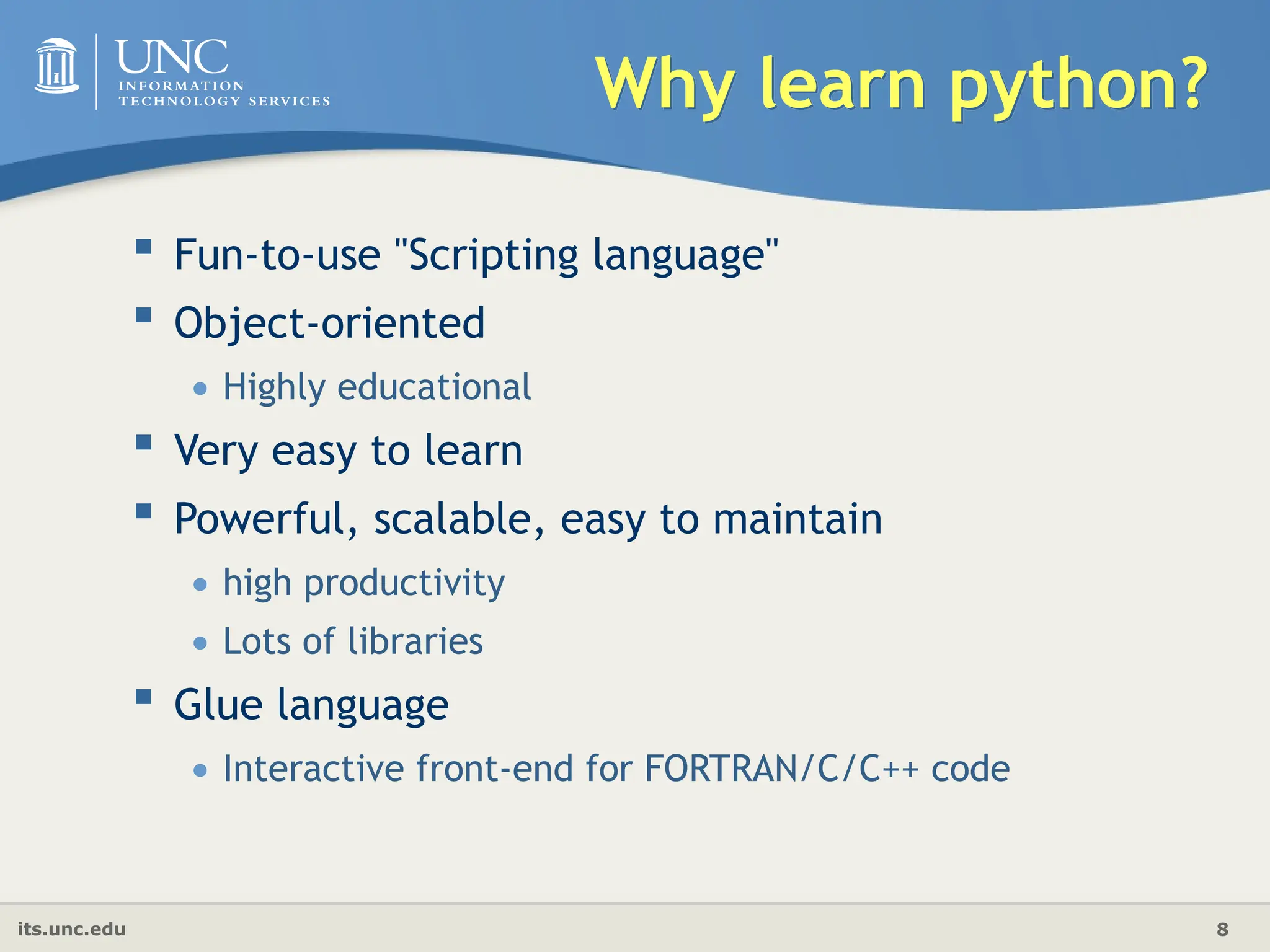
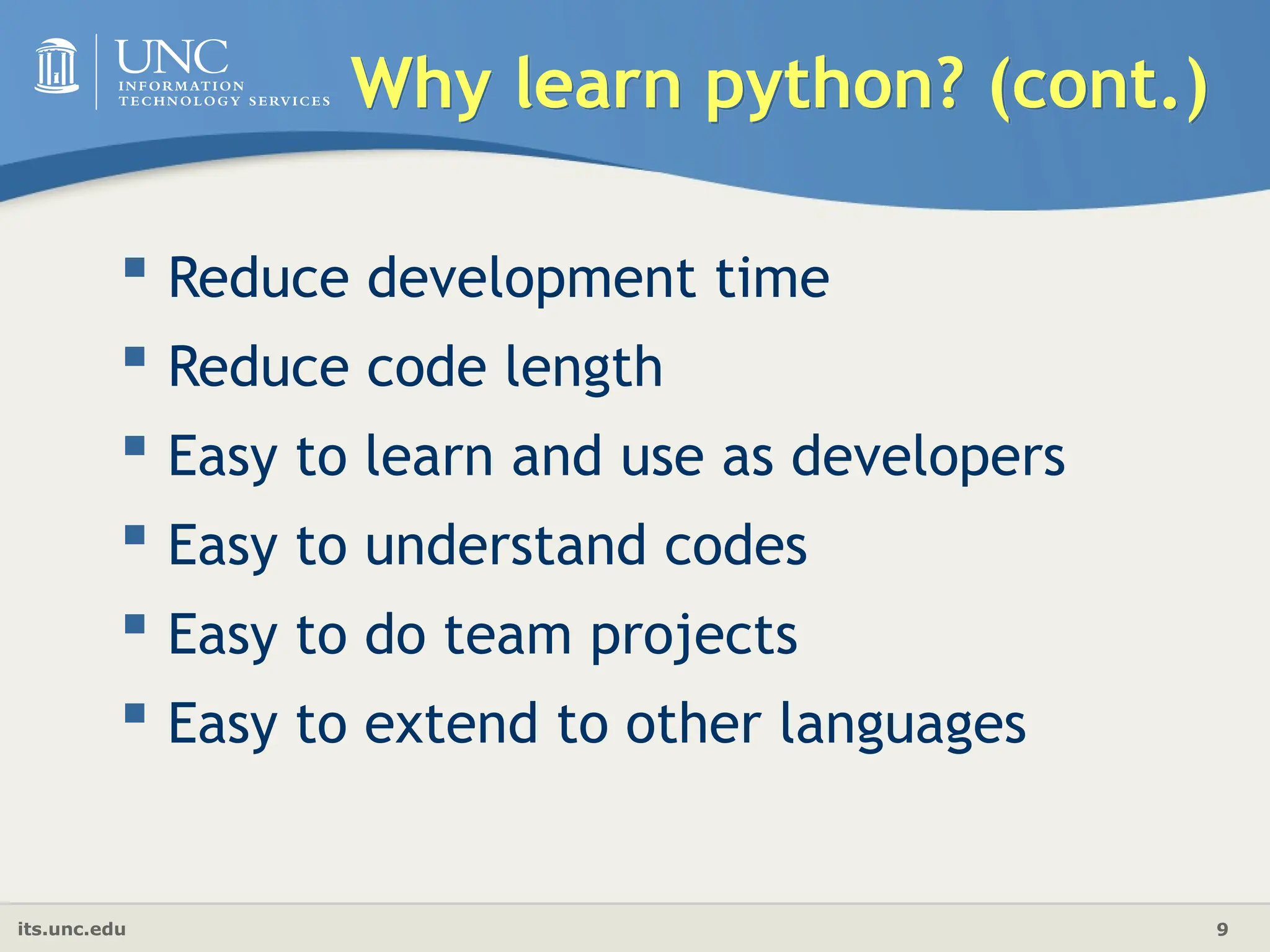
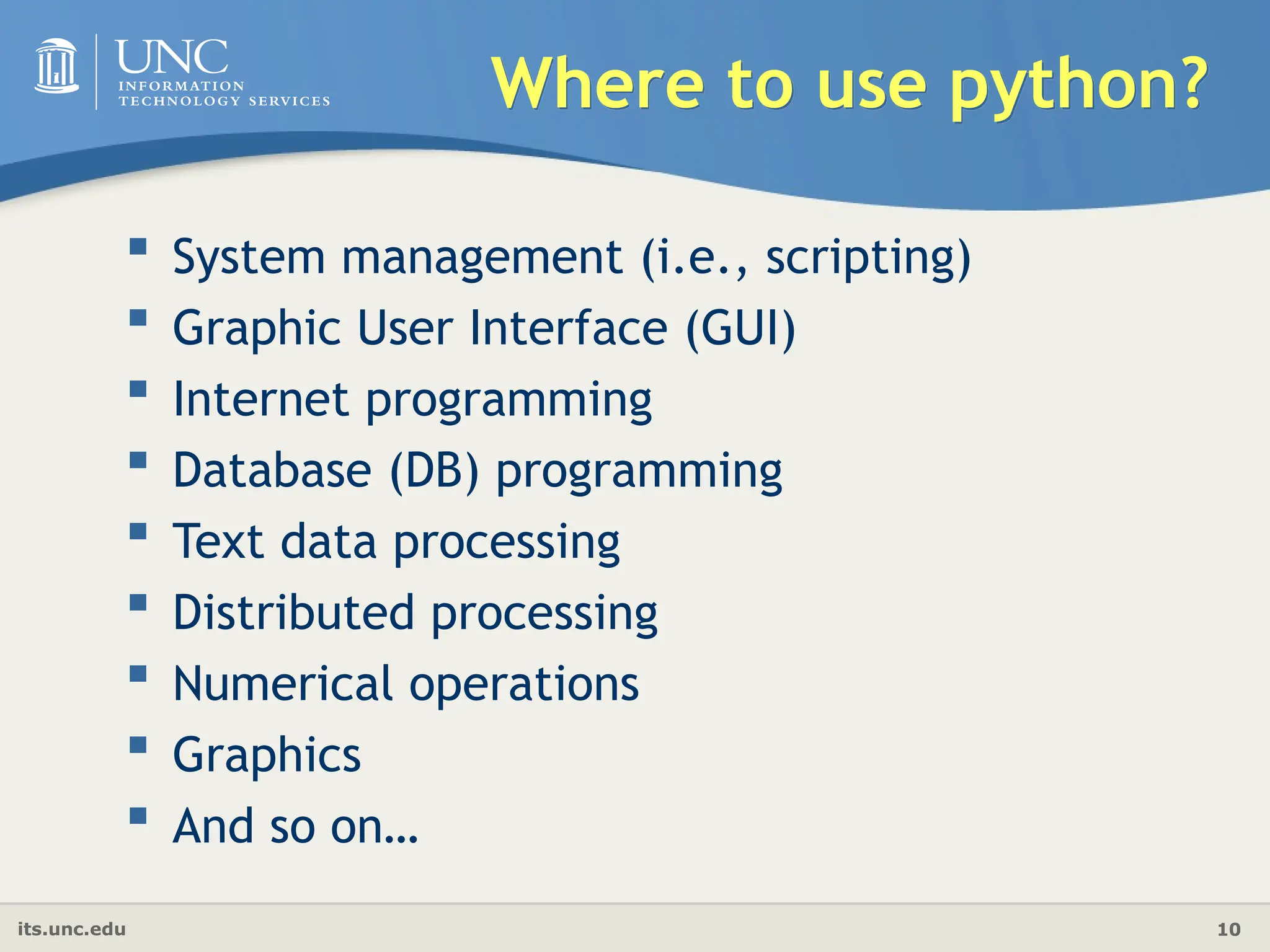
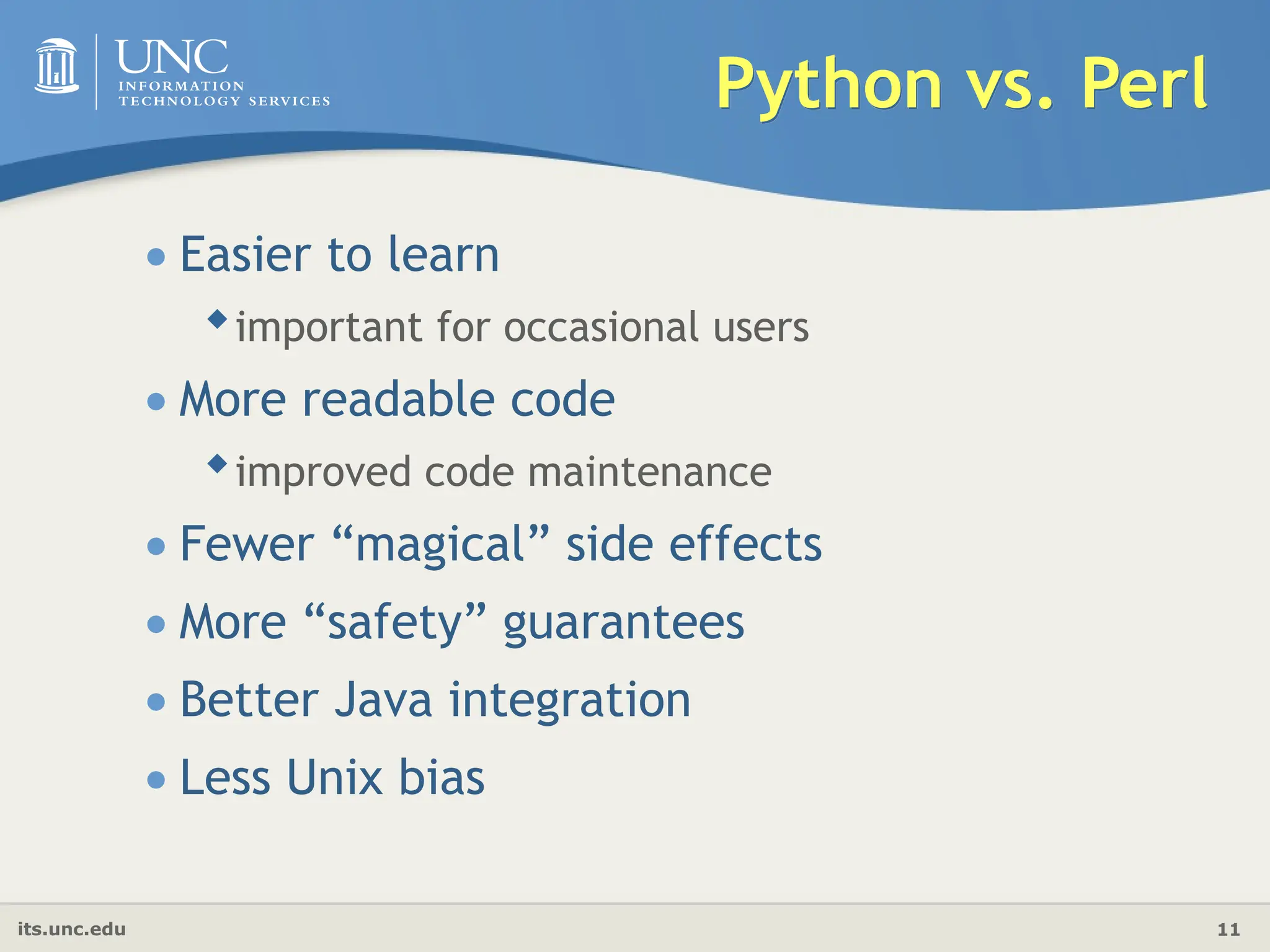
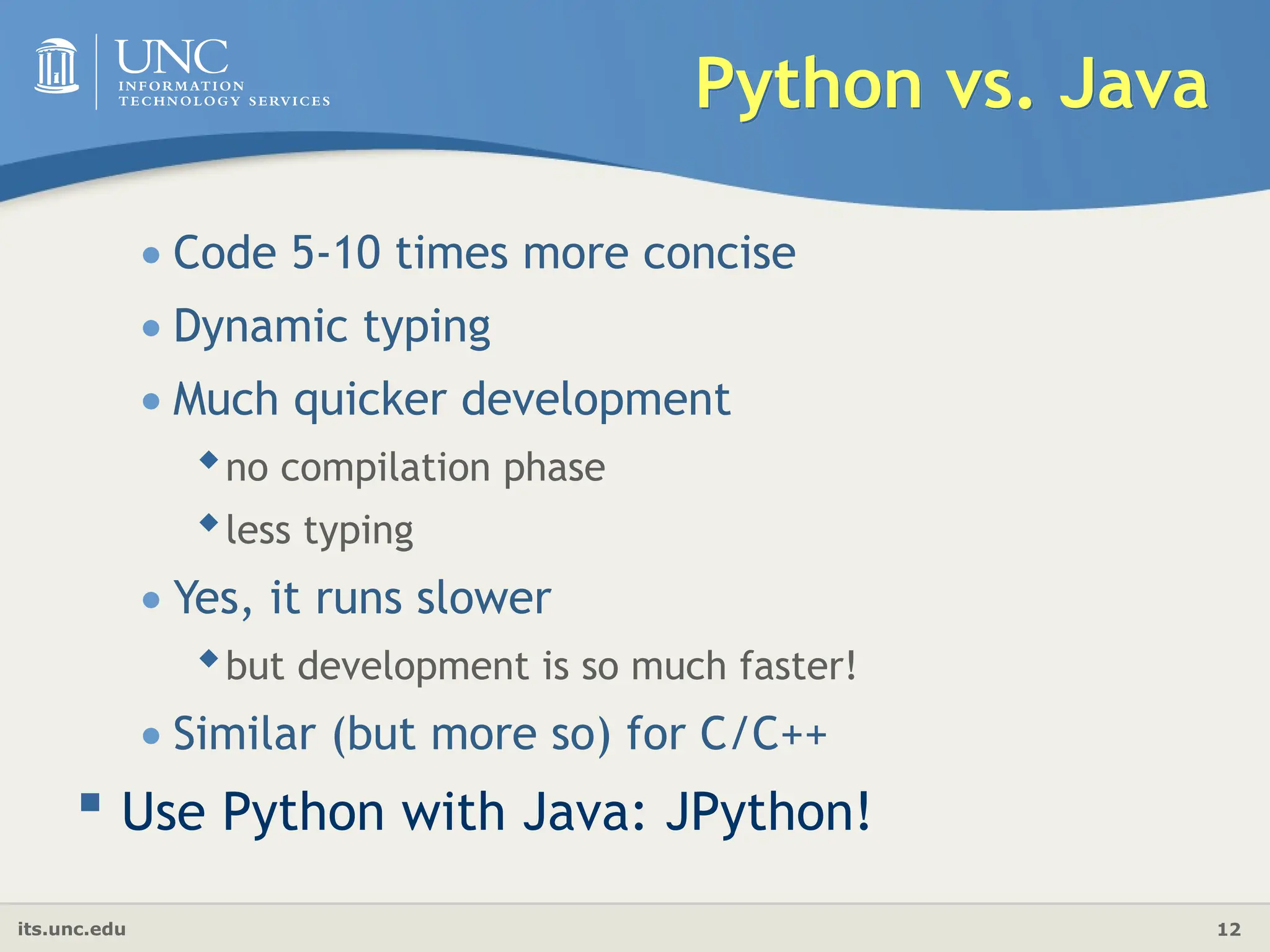
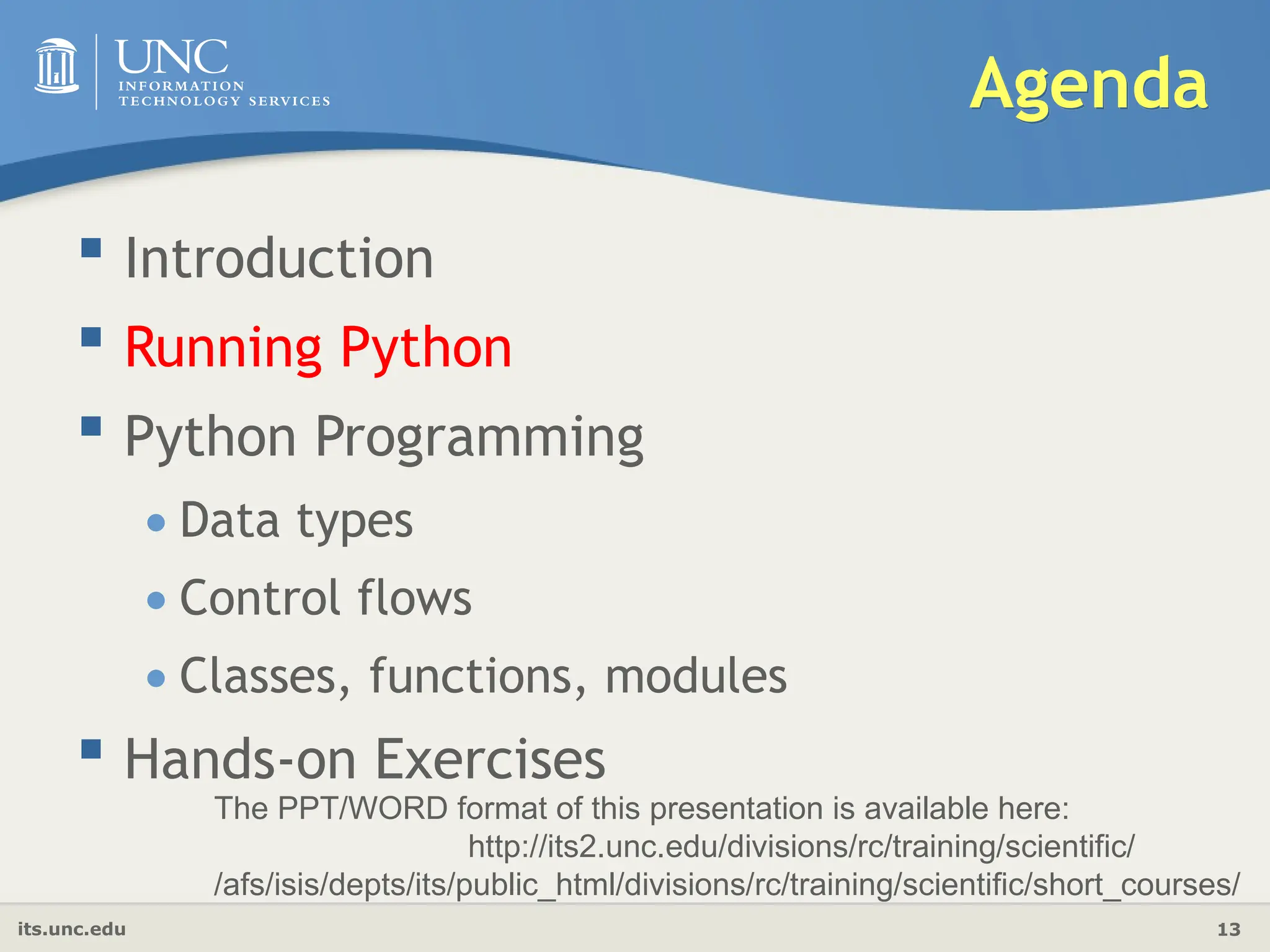
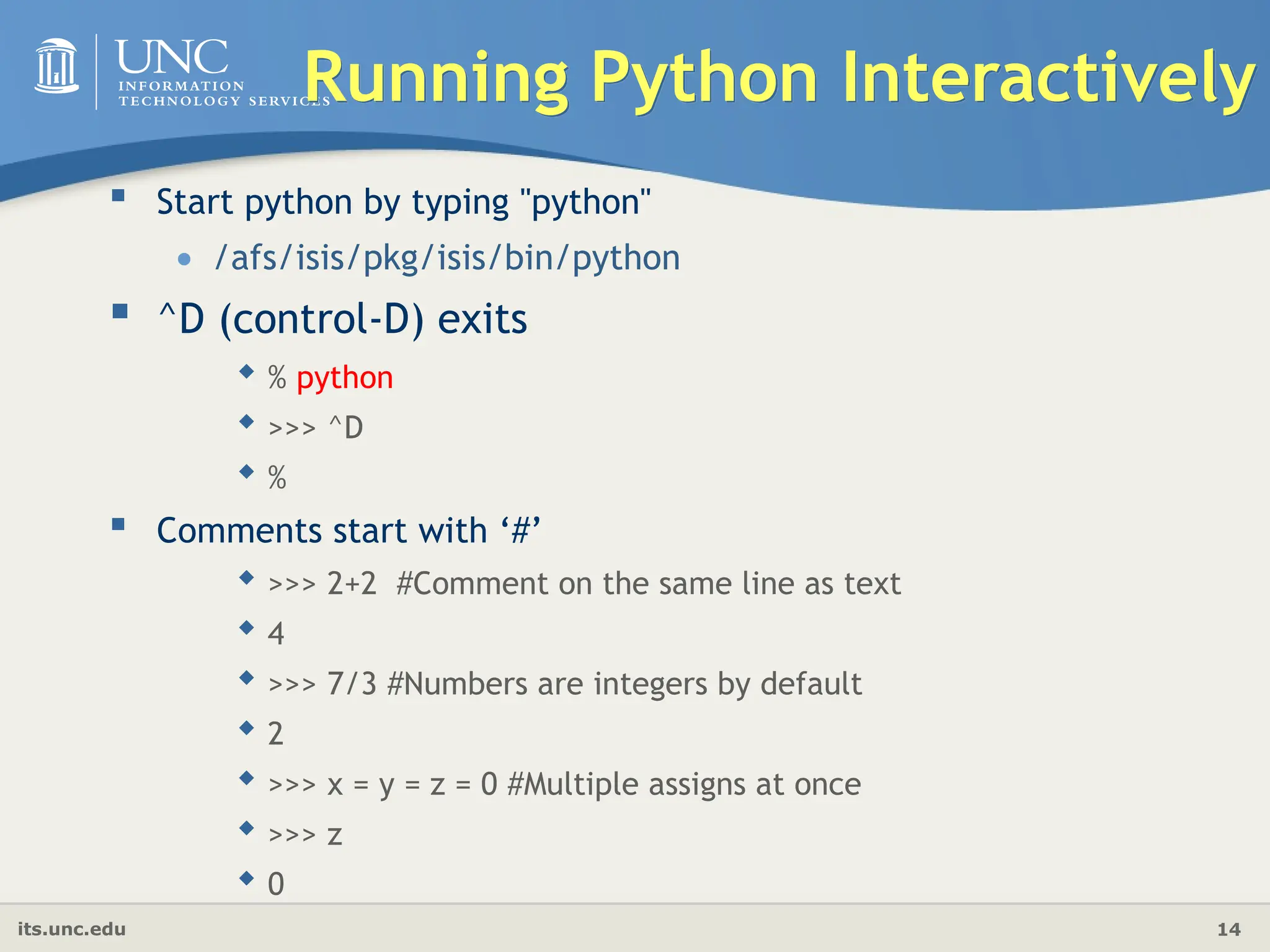
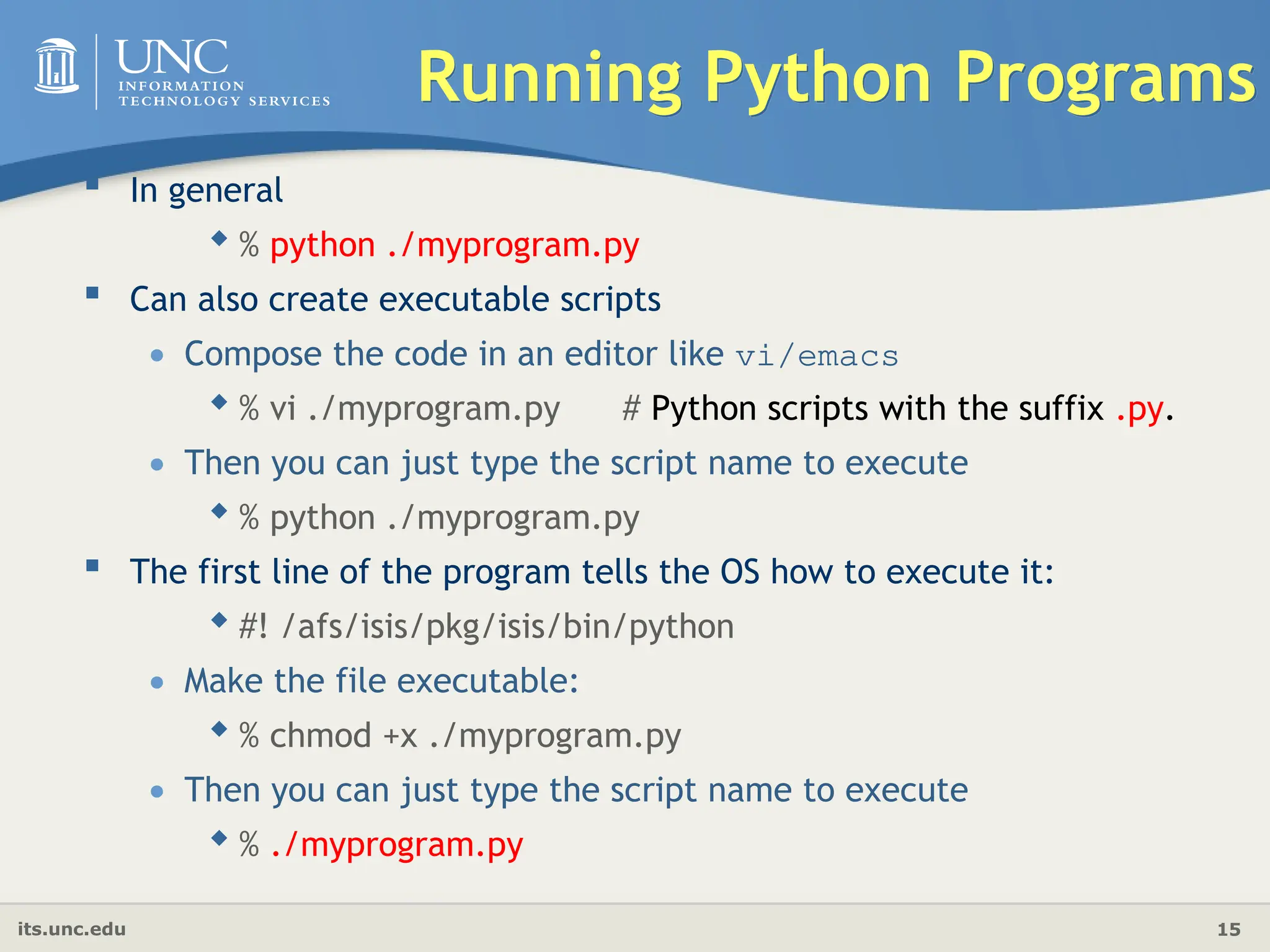
![its.unc.edu 16 Running Python Programs Interactively Suppose the file script.py contains the following lines: print 'Hello world' x = [0,1,2] Let's run this script in each of the ways described on the last slide: python -i script.py Hello world >>> x [0,1,2] $ python >>> execfile('script.py') >>> x [0,1,2]](https://image.slidesharecdn.com/pythonintro-250114132024-05f30ce6/75/iNTRODUCATION-TO-PYTHON-IN-PROGRAMMING-LANGUAGE-16-2048.jpg)
![its.unc.edu 17 Running Python Programs Interactively Suppose the file script.py contains the following lines: print 'Hello world' x = [0,1,2] Let's run this script in each of the ways described on the last slide: python >>> import script # DO NOT add the .py suffix. Script is a module here >>> x Traceback (most recent call last): File "<stdin>", line 1, in ? NameError: name 'x' is not defined >>> script.x # to make use of x, we need to let Python know which #module it came from, i.e. give Python its context [0,1,2]](https://image.slidesharecdn.com/pythonintro-250114132024-05f30ce6/75/iNTRODUCATION-TO-PYTHON-IN-PROGRAMMING-LANGUAGE-17-2048.jpg)
![its.unc.edu 18 Running Python Programs Interactively # Pretend that script.py contains multiple stored quantities. To promote x(and only x) to the top level context, type the following: $ python >>> from script import x Hello world >>> x [0,1,2] >>> # To promote all quantities in script.py to the top level context, type from script import * into the interpreter. Of course, if that's what you want, you might as well type python -i script.py into the terminal. >>> from script import *](https://image.slidesharecdn.com/pythonintro-250114132024-05f30ce6/75/iNTRODUCATION-TO-PYTHON-IN-PROGRAMMING-LANGUAGE-18-2048.jpg)
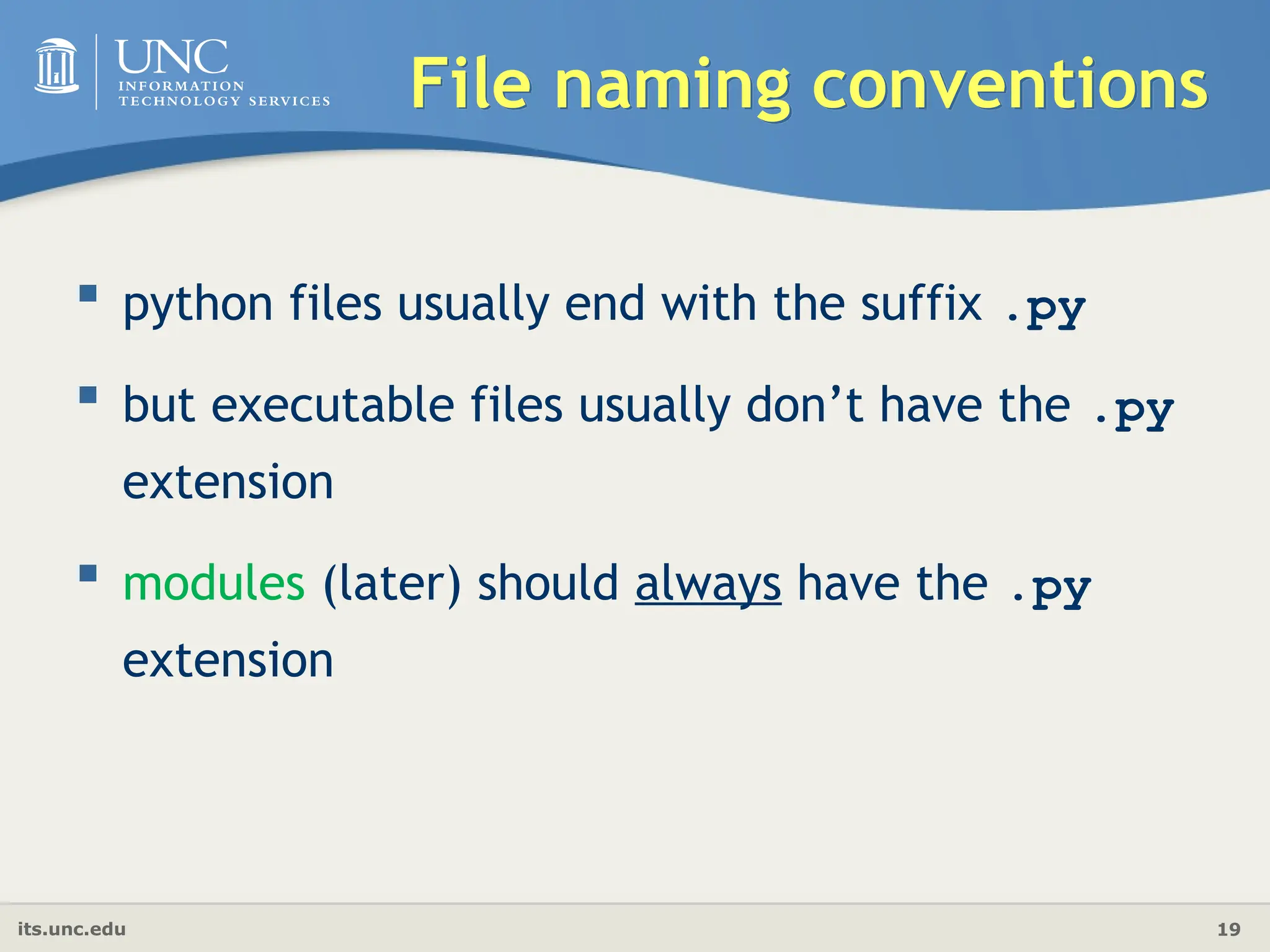
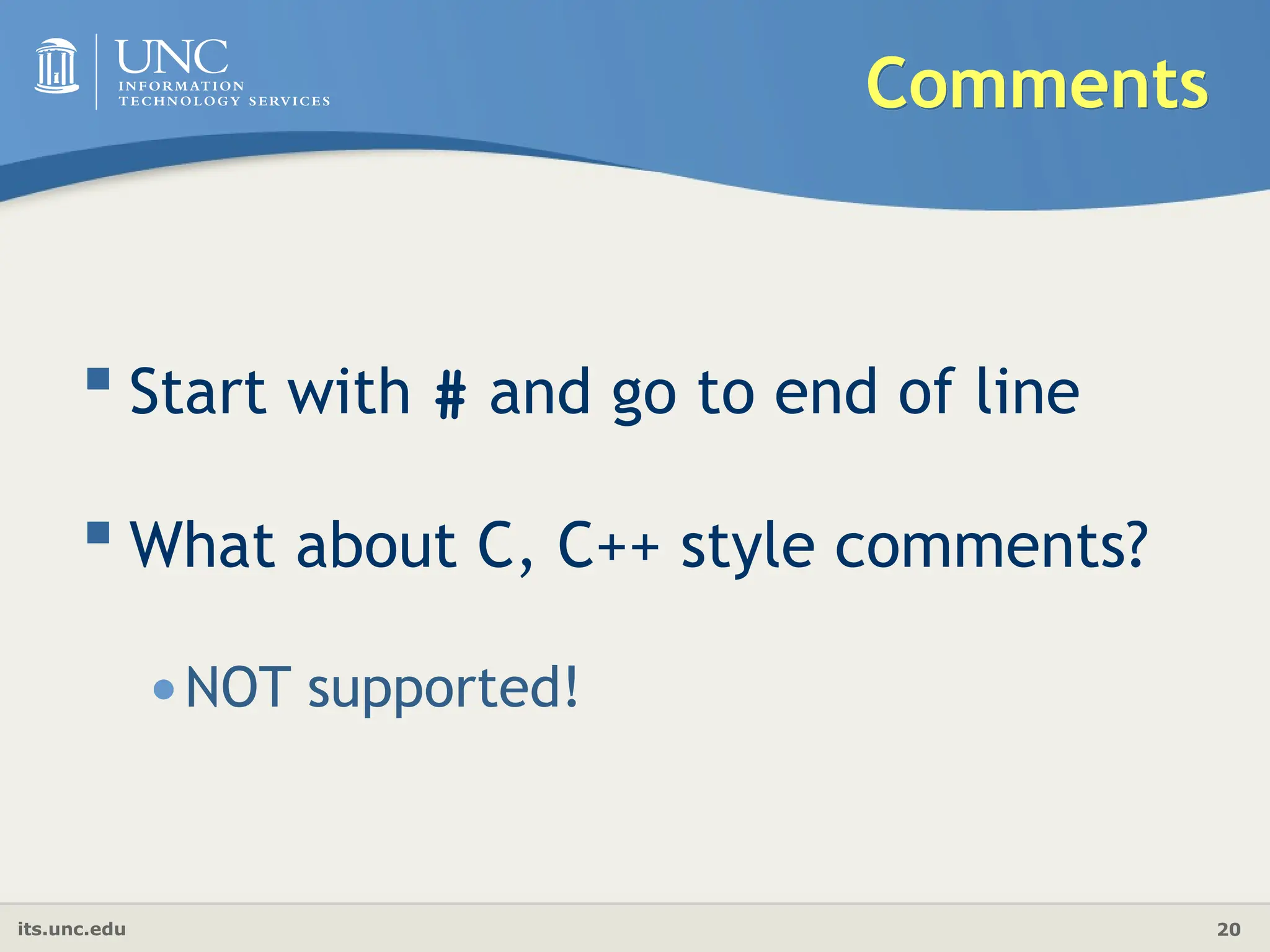
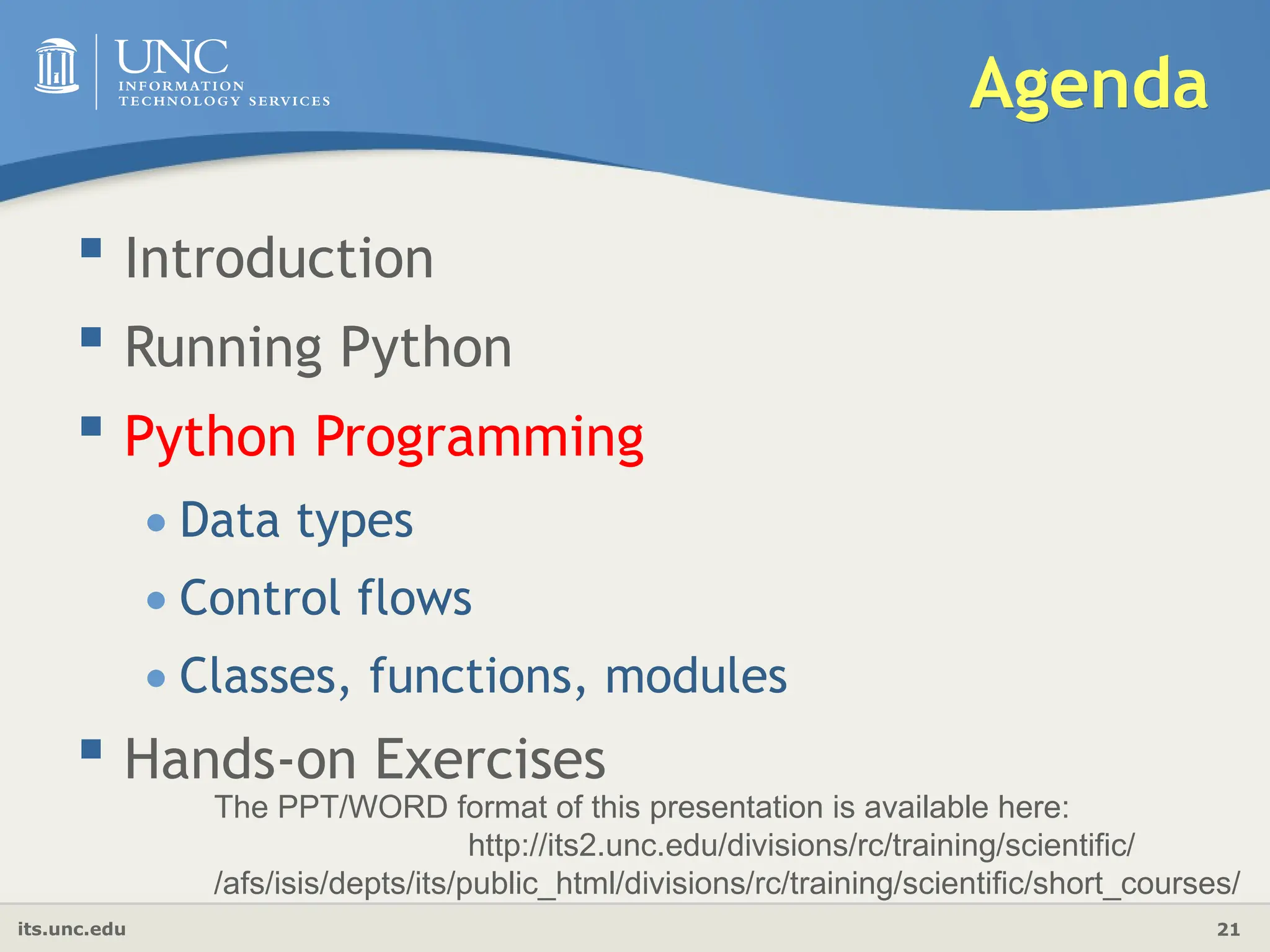
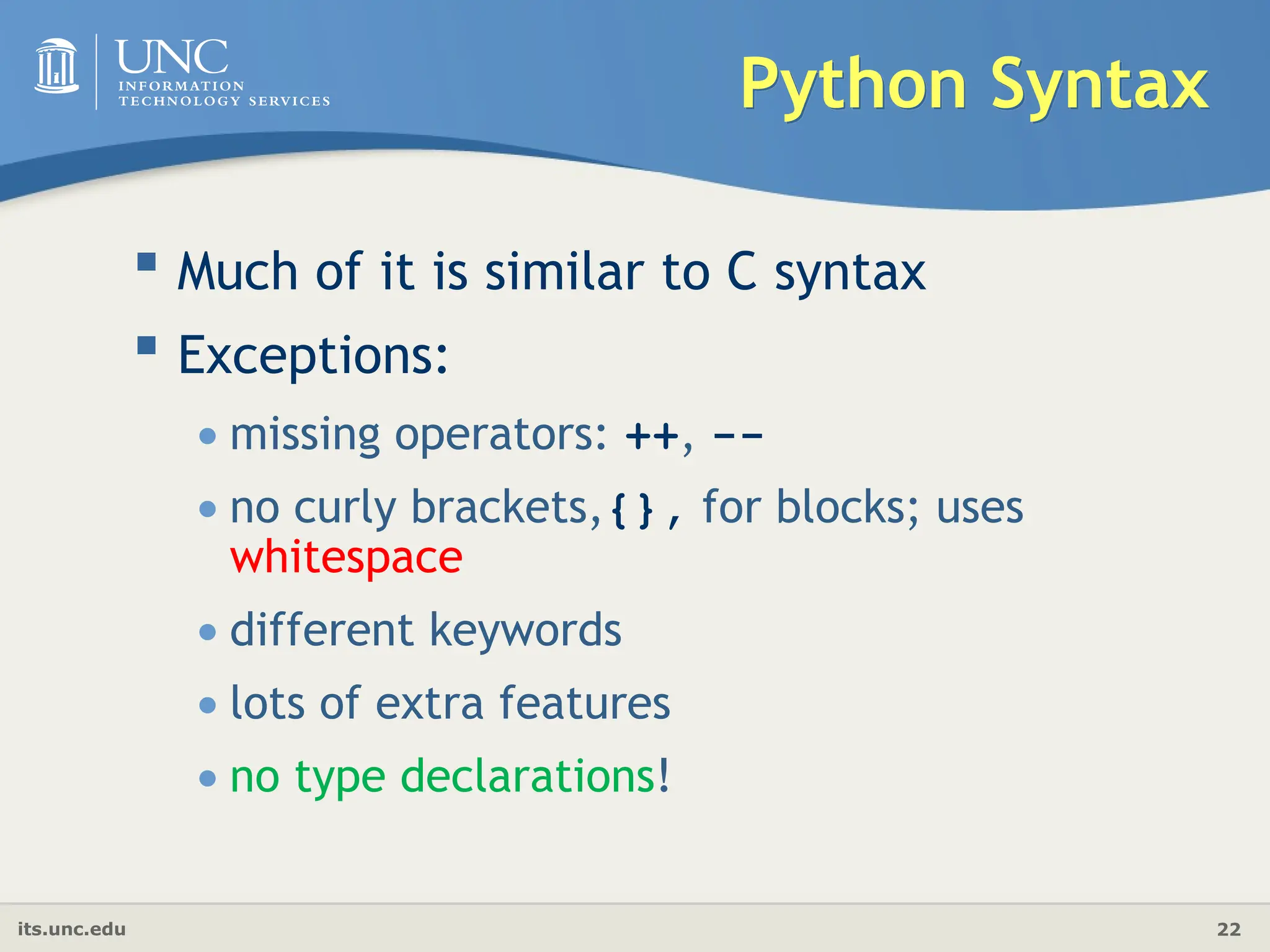
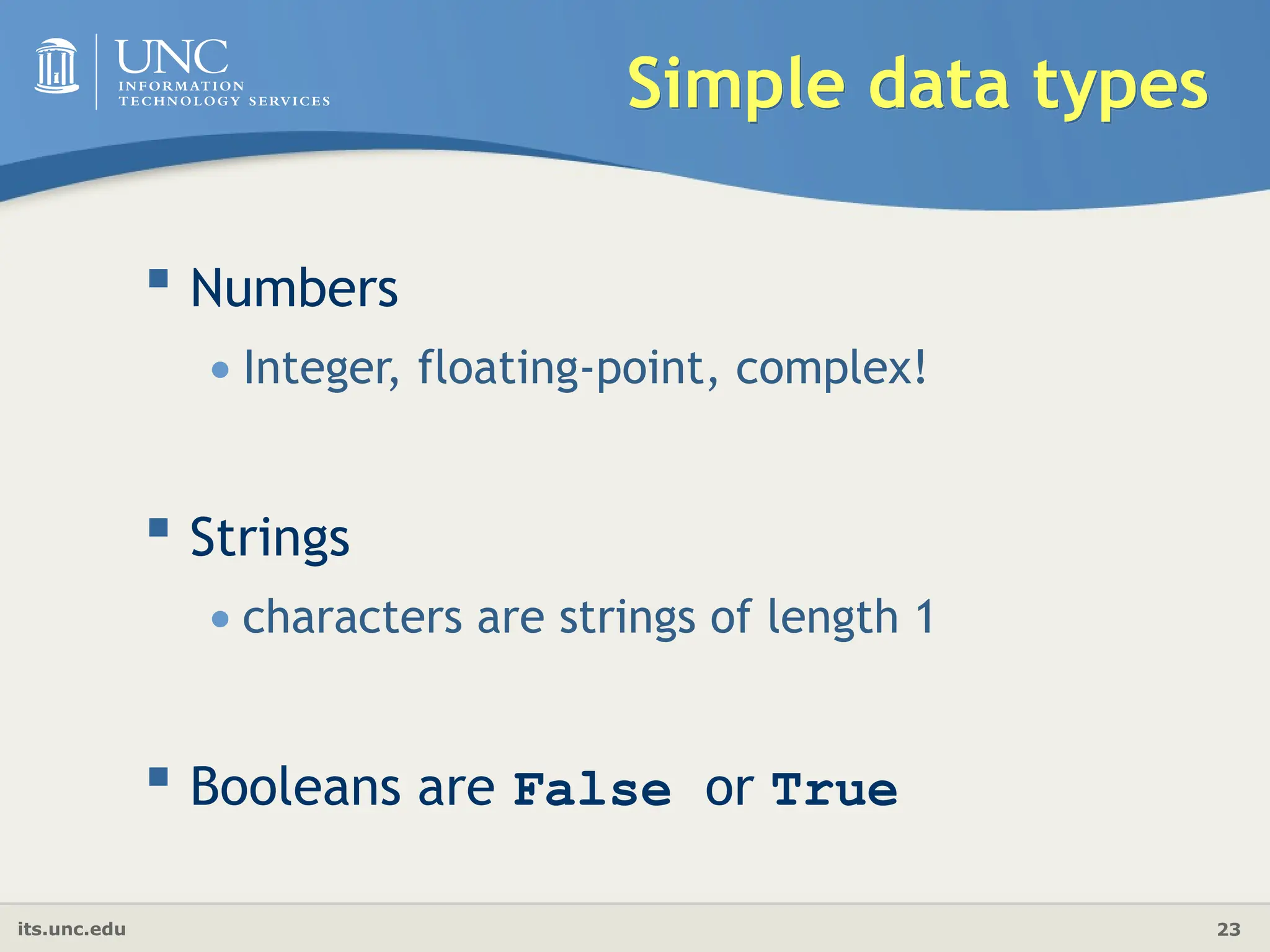
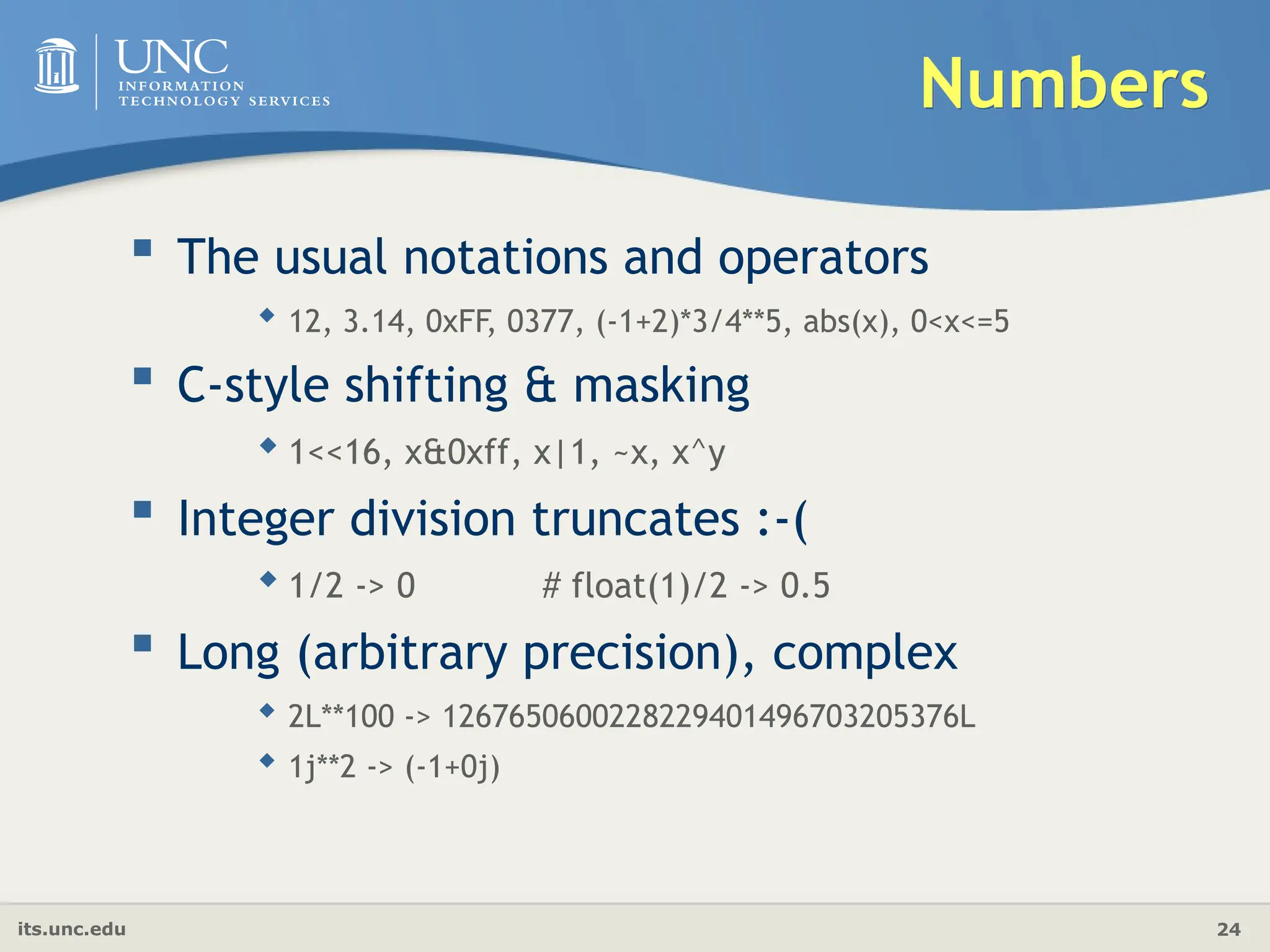
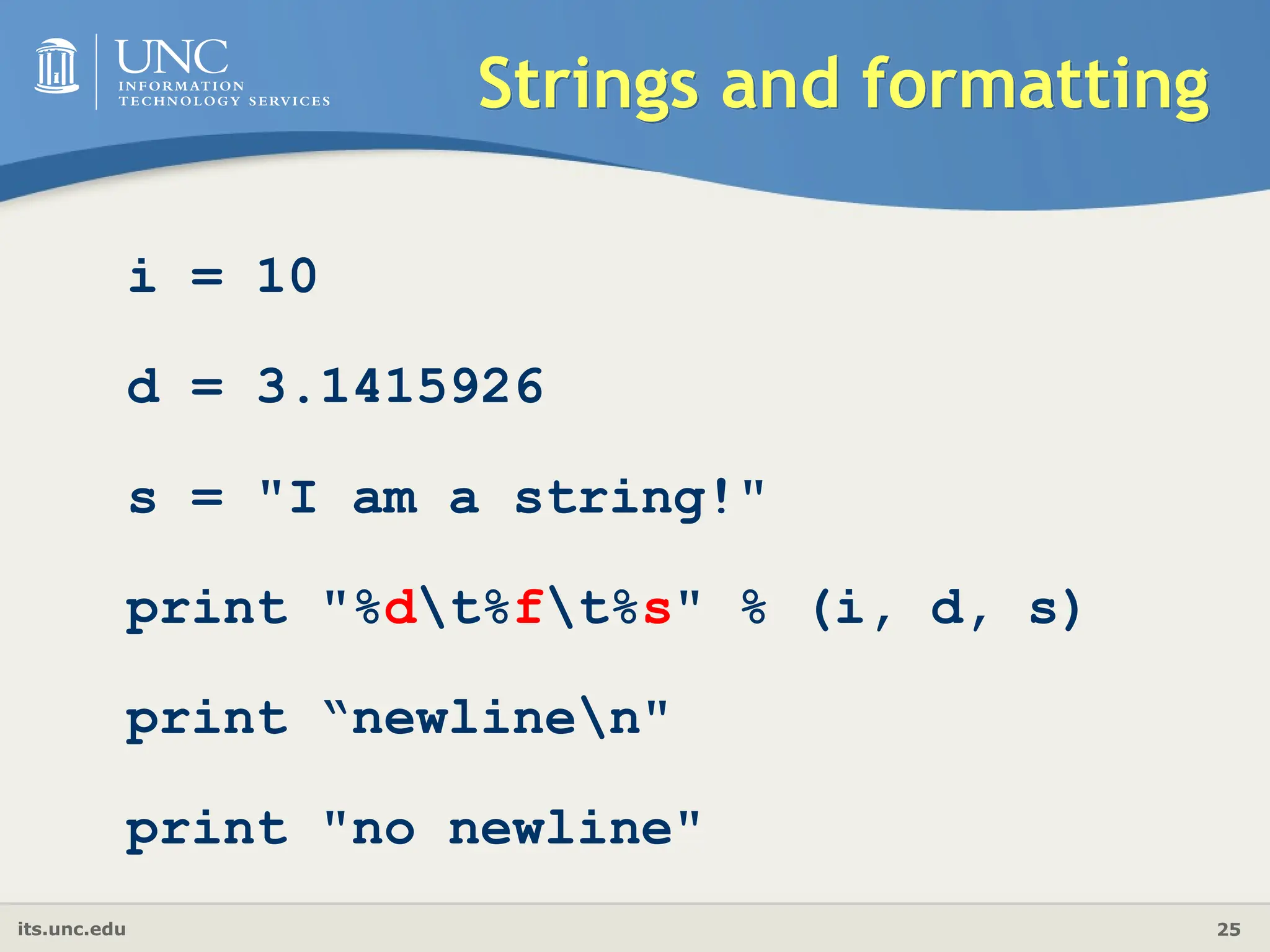
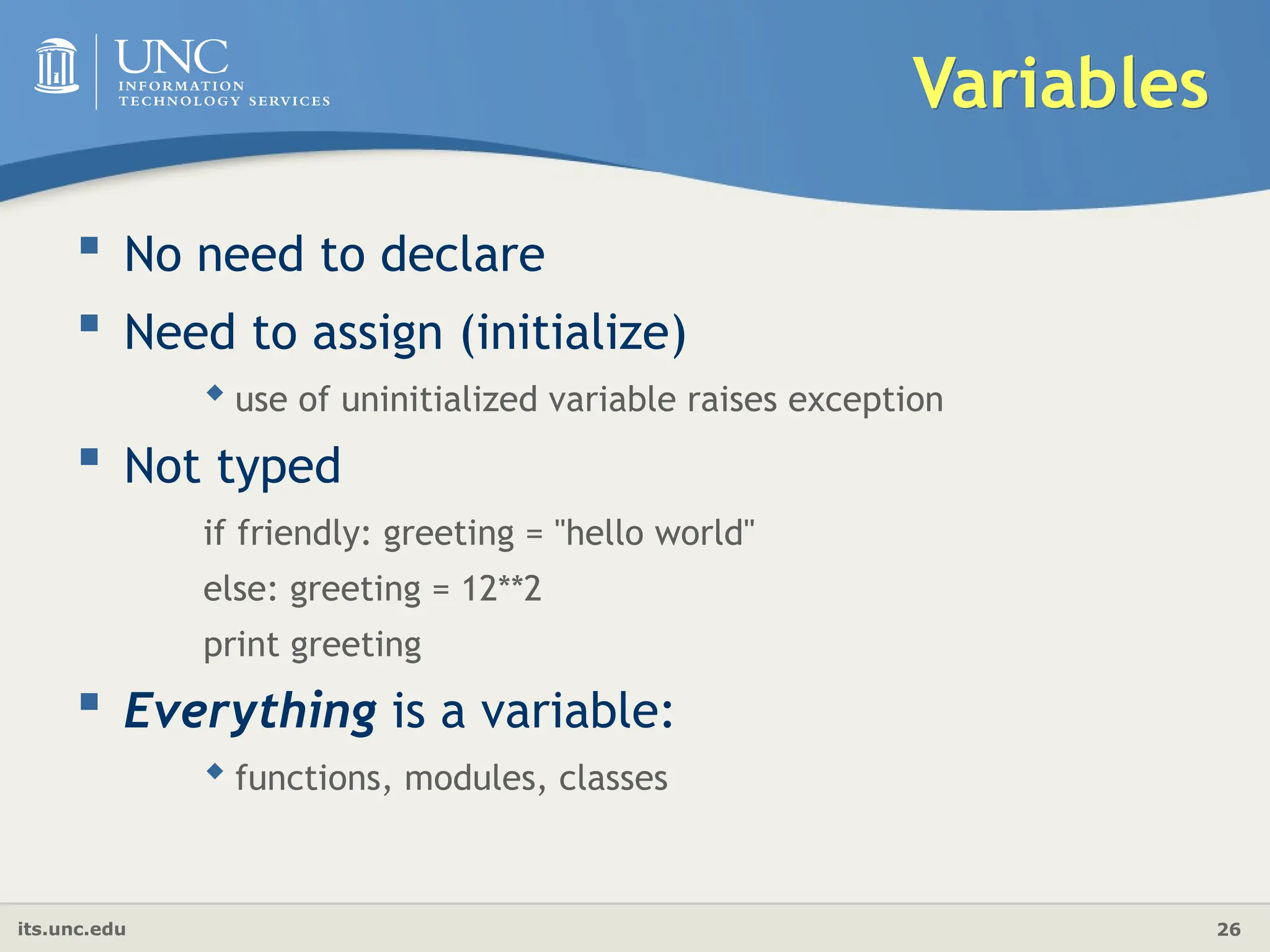
![its.unc.edu 27 Reference semantics Assignment manipulates references x = y does not make a copy of y x = y makes x reference the object y references Very useful; but beware! Example: >>> a = [1, 2, 3]; b = a >>> a.append(4); print b [1, 2, 3, 4]](https://image.slidesharecdn.com/pythonintro-250114132024-05f30ce6/75/iNTRODUCATION-TO-PYTHON-IN-PROGRAMMING-LANGUAGE-27-2048.jpg)
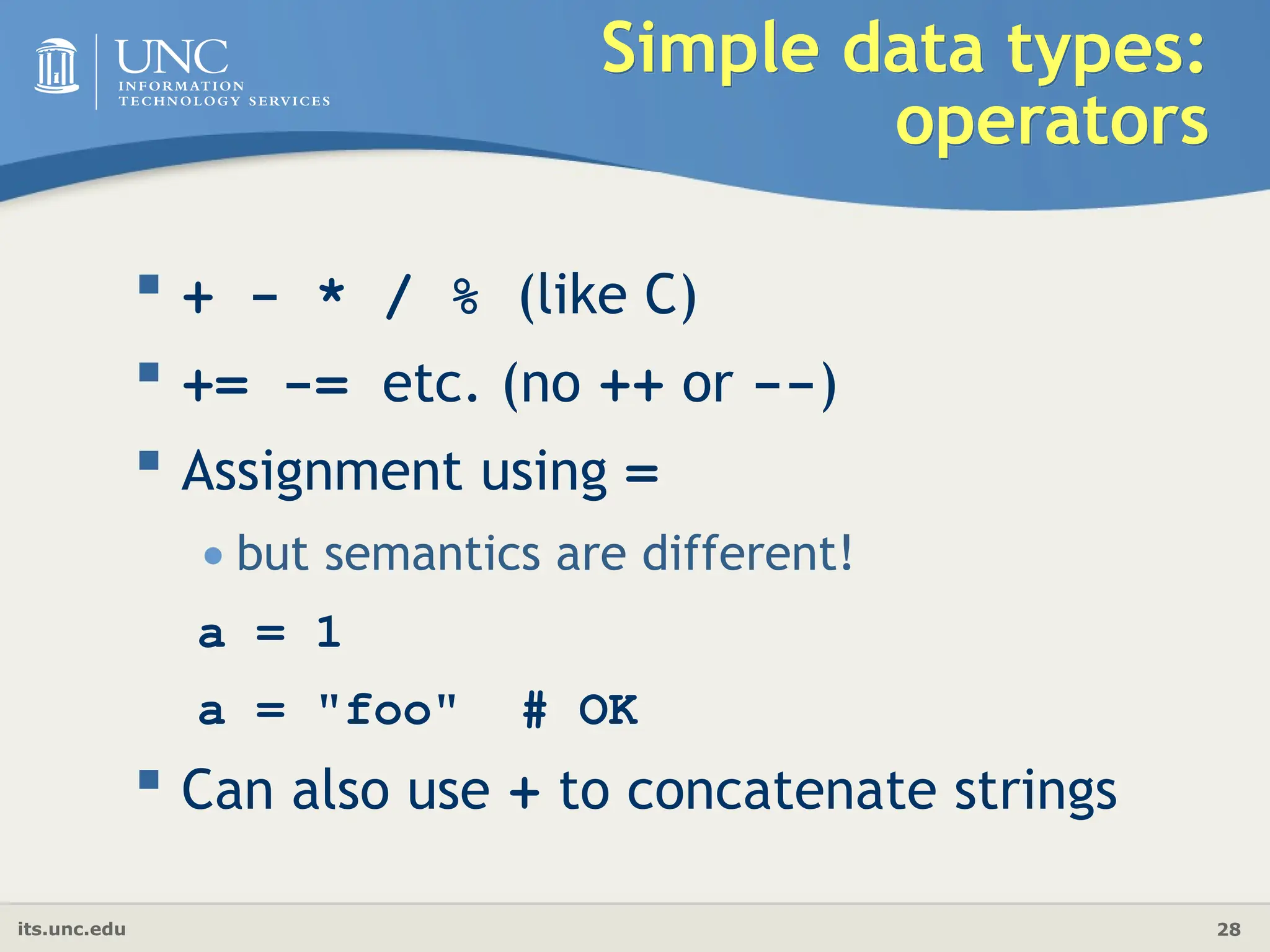
![its.unc.edu 29 Strings "hello"+"world" "helloworld" # concatenation "hello"*3 "hellohellohello" # repetition "hello"[0] "h" # indexing "hello"[-1] "o" # (from end) "hello"[1:4] "ell" # slicing len("hello") 5 # size "hello" < "jello" 1 # comparison "e" in "hello" 1 # search New line: "escapes: n " Line continuation: triple quotes ’’’ Quotes: ‘single quotes’, "raw strings"](https://image.slidesharecdn.com/pythonintro-250114132024-05f30ce6/75/iNTRODUCATION-TO-PYTHON-IN-PROGRAMMING-LANGUAGE-29-2048.jpg)
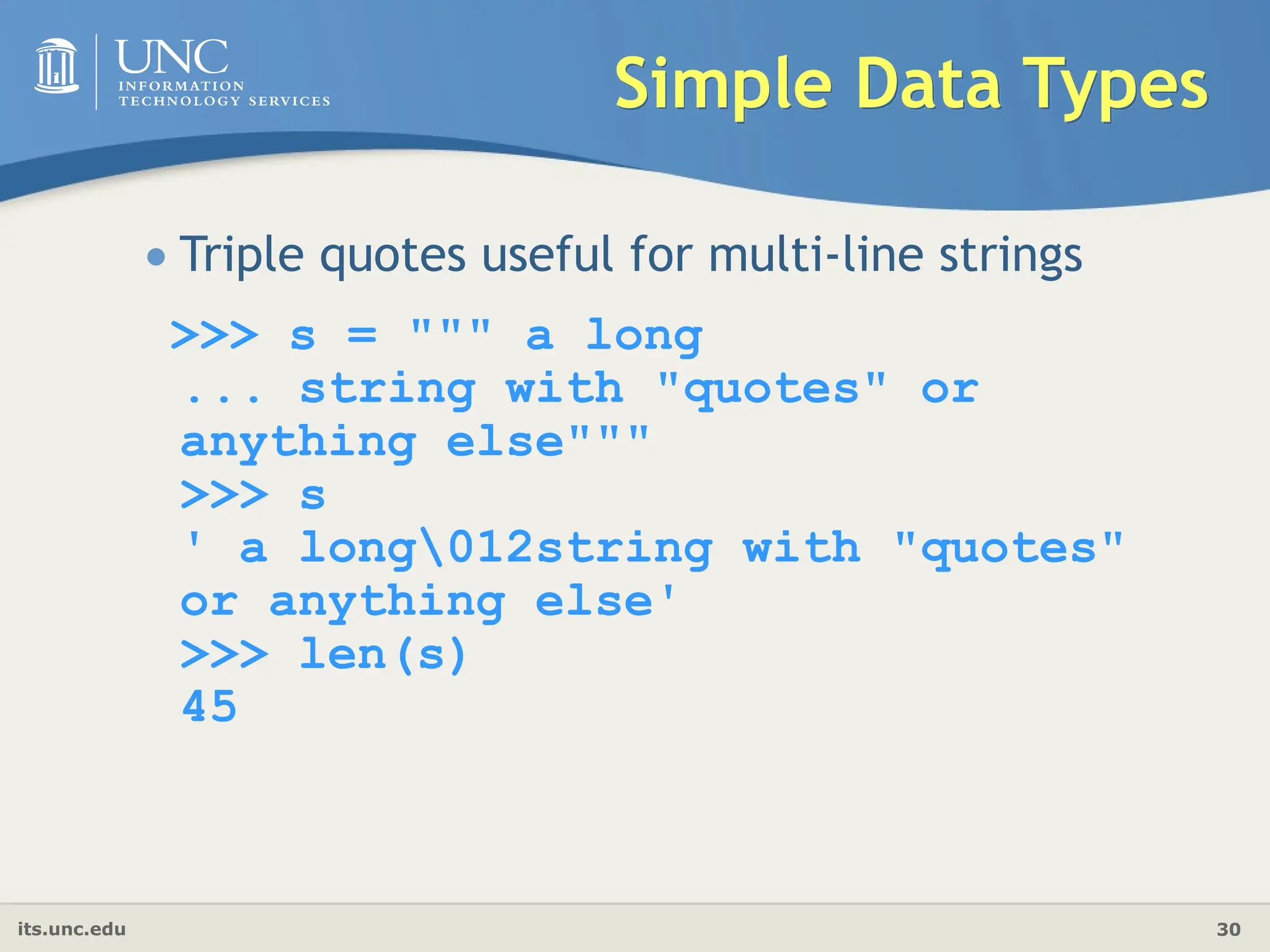
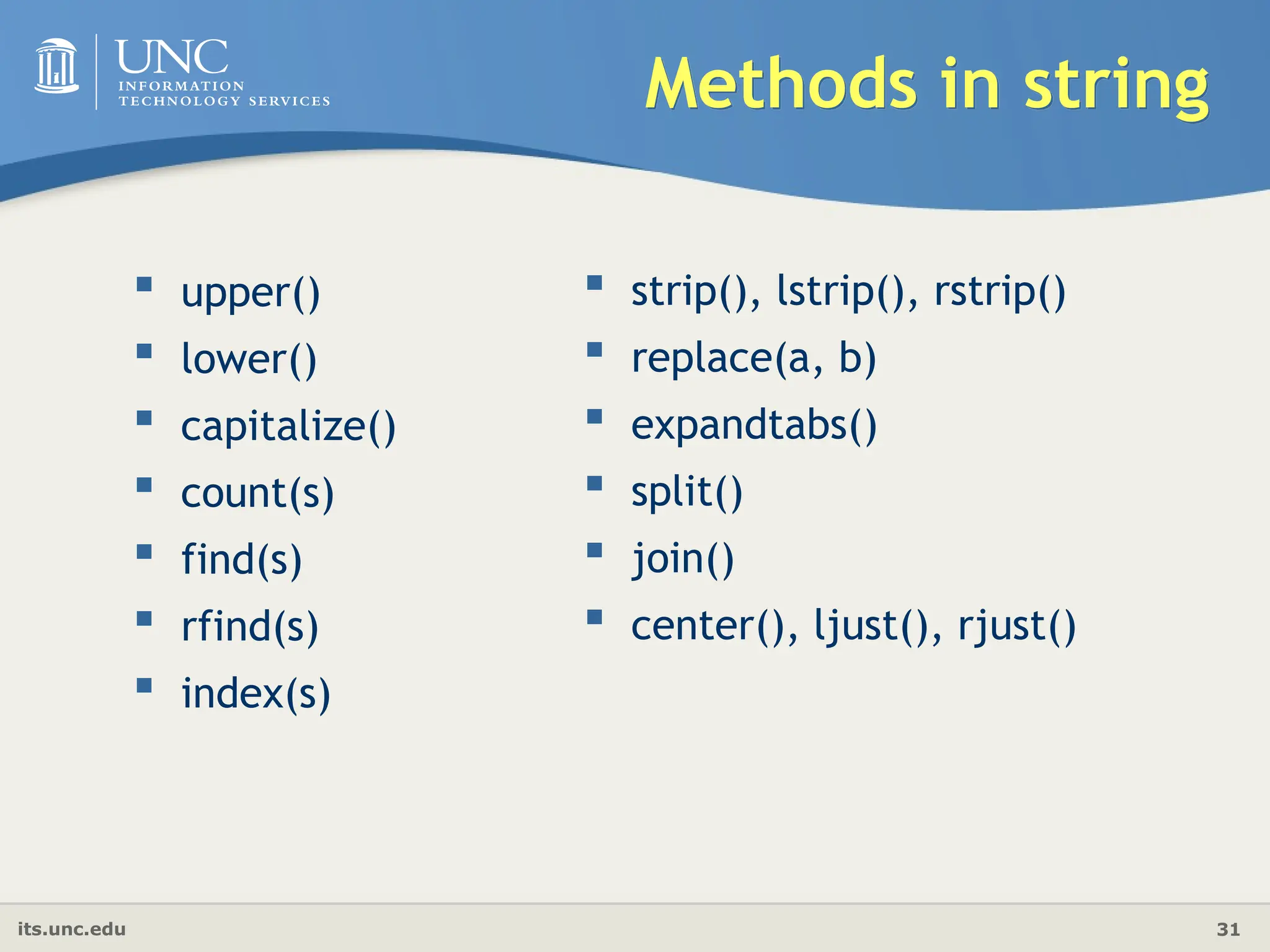
![its.unc.edu 32 Compound Data Type: List List: • A container that holds a number of other objects, in a given order • Defined in square brackets a = [1, 2, 3, 4, 5] print a[1] # number 2 some_list = [] some_list.append("foo") some_list.append(12) print len(some_list) # 2](https://image.slidesharecdn.com/pythonintro-250114132024-05f30ce6/75/iNTRODUCATION-TO-PYTHON-IN-PROGRAMMING-LANGUAGE-32-2048.jpg)
![its.unc.edu 33 List a = [99, "bottles of beer", ["on", "the", "wall"]] Flexible arrays, not Lisp-like linked lists Same operators as for strings a+b, a*3, a[0], a[-1], a[1:], len(a) Item and slice assignment a[0] = 98 a[1:2] = ["bottles", "of", "beer"] -> [98, "bottles", "of", "beer", ["on", "the", "wall"]] del a[-1] # -> [98, "bottles", "of", "beer"]](https://image.slidesharecdn.com/pythonintro-250114132024-05f30ce6/75/iNTRODUCATION-TO-PYTHON-IN-PROGRAMMING-LANGUAGE-33-2048.jpg)
![its.unc.edu 34 More list operations >>> a = range(5) # [0,1,2,3,4] >>> a.append(5) # [0,1,2,3,4,5] >>> a.pop() # [0,1,2,3,4] 5 >>> a.insert(0, 5.5) # [5.5,0,1,2,3,4] >>> a.pop(0) # [0,1,2,3,4] 5.5 >>> a.reverse() # [4,3,2,1,0] >>> a.sort() # [0,1,2,3,4]](https://image.slidesharecdn.com/pythonintro-250114132024-05f30ce6/75/iNTRODUCATION-TO-PYTHON-IN-PROGRAMMING-LANGUAGE-34-2048.jpg)
![its.unc.edu 35 Operations in List Indexing e.g., L[i] Slicing e.g., L[1:5] Concatenation e.g., L + L Repetition e.g., L * 5 Membership test e.g., ‘a’ in L Length e.g., len(L) append insert index count sort reverse remove pop extend](https://image.slidesharecdn.com/pythonintro-250114132024-05f30ce6/75/iNTRODUCATION-TO-PYTHON-IN-PROGRAMMING-LANGUAGE-35-2048.jpg)
![its.unc.edu 36 Nested List List in a list E.g., •>>> s = [1,2,3] •>>> t = [‘begin’, s, ‘end’] •>>> t •[‘begin’, [1, 2, 3], ‘end’] •>>> t[1][1] •2](https://image.slidesharecdn.com/pythonintro-250114132024-05f30ce6/75/iNTRODUCATION-TO-PYTHON-IN-PROGRAMMING-LANGUAGE-36-2048.jpg)
![its.unc.edu 37 Dictionaries Dictionaries: curly brackets • What is dictionary? Refer value through key; “associative arrays” • Like an array indexed by a string • An unordered set of key: value pairs • Values of any type; keys of almost any type {"name":"Guido", "age":43, ("hello","world"):1, 42:"yes", "flag": ["red","white","blue"]} d = { "foo" : 1, "bar" : 2 } print d["bar"] # 2 some_dict = {} some_dict["foo"] = "yow!" print some_dict.keys() # ["foo"]](https://image.slidesharecdn.com/pythonintro-250114132024-05f30ce6/75/iNTRODUCATION-TO-PYTHON-IN-PROGRAMMING-LANGUAGE-37-2048.jpg)
![its.unc.edu 38 Methods in Dictionary keys() values() items() has_key(key) clear() copy() get(key[,x]) setdefault(key[,x]) update(D) popitem()](https://image.slidesharecdn.com/pythonintro-250114132024-05f30ce6/75/iNTRODUCATION-TO-PYTHON-IN-PROGRAMMING-LANGUAGE-38-2048.jpg)
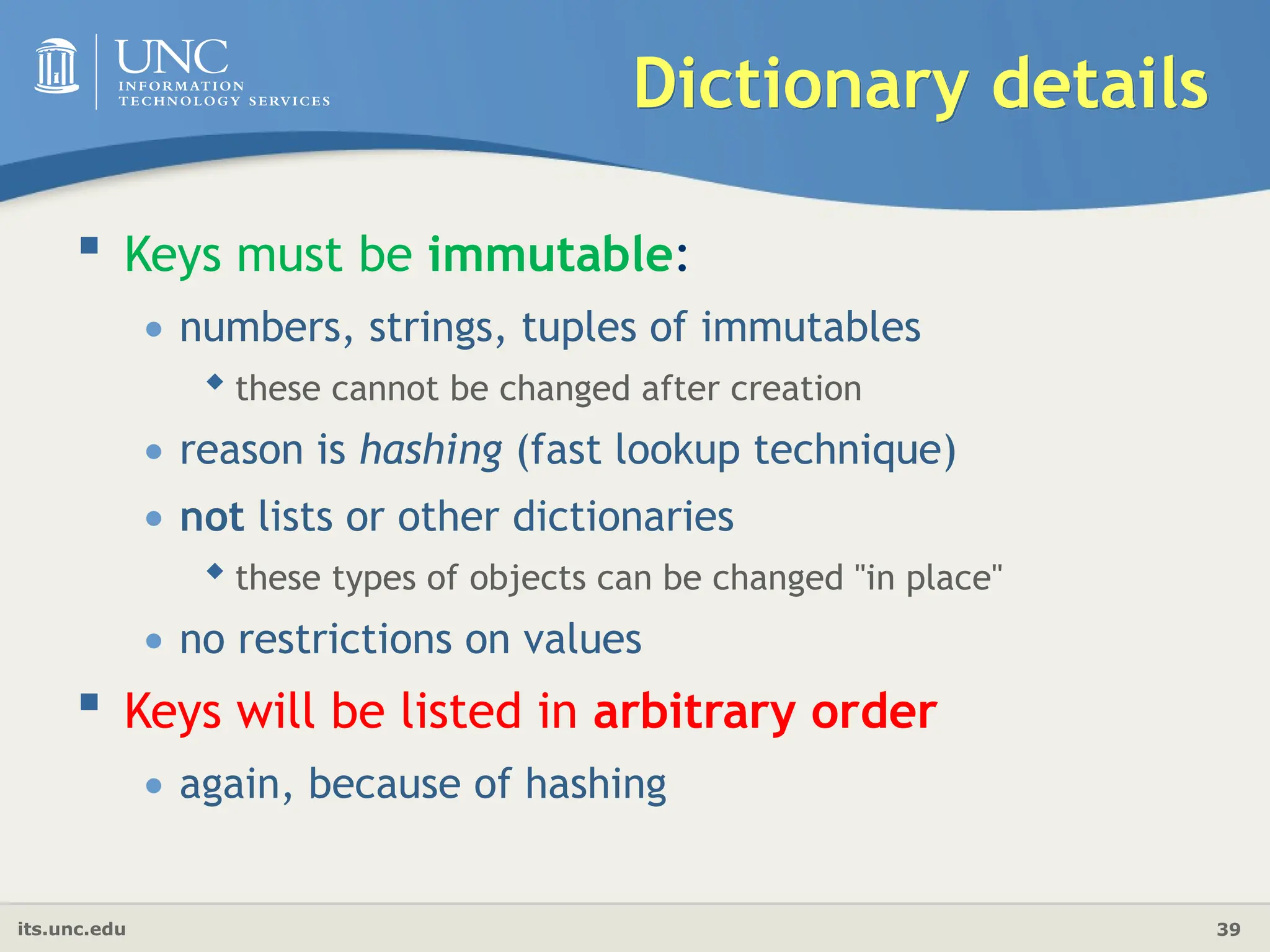
![its.unc.edu 40 Tuples What is a tuple? • A tuple is an ordered collection which cannot be modified once it has been created. • In other words, it's a special array, a read-only array. How to make a tuple? In round brackets • E.g., >>> t = () >>> t = (1, 2, 3) >>> t = (1, ) >>> t = 1, >>> a = (1, 2, 3, 4, 5) >>> print a[1] # 2](https://image.slidesharecdn.com/pythonintro-250114132024-05f30ce6/75/iNTRODUCATION-TO-PYTHON-IN-PROGRAMMING-LANGUAGE-40-2048.jpg)
![its.unc.edu 41 Operations in Tuple Indexing e.g., T[i] Slicing e.g., T[1:5] Concatenation e.g., T + T Repetition e.g., T * 5 Membership test e.g., ‘a’ in T Length e.g., len(T)](https://image.slidesharecdn.com/pythonintro-250114132024-05f30ce6/75/iNTRODUCATION-TO-PYTHON-IN-PROGRAMMING-LANGUAGE-41-2048.jpg)
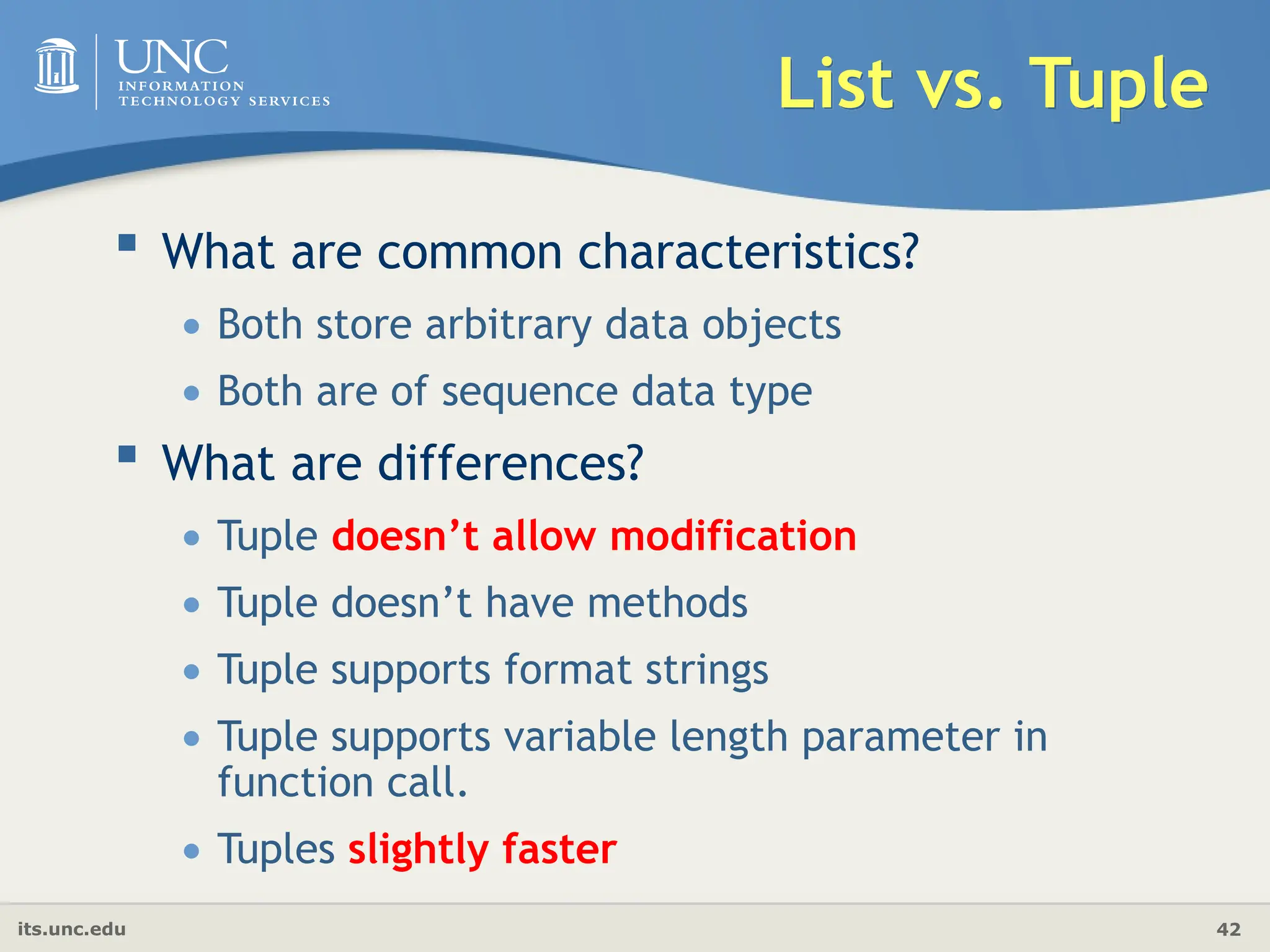
![its.unc.edu 43 Data Type Wrap Up Integers: 2323, 3234L Floating Point: 32.3, 3.1E2 Complex: 3 + 2j, 1j Lists: l = [ 1,2,3] Tuples: t = (1,2,3) Dictionaries: d = {‘hello’ : ‘there’, 2 : 15}](https://image.slidesharecdn.com/pythonintro-250114132024-05f30ce6/75/iNTRODUCATION-TO-PYTHON-IN-PROGRAMMING-LANGUAGE-43-2048.jpg)
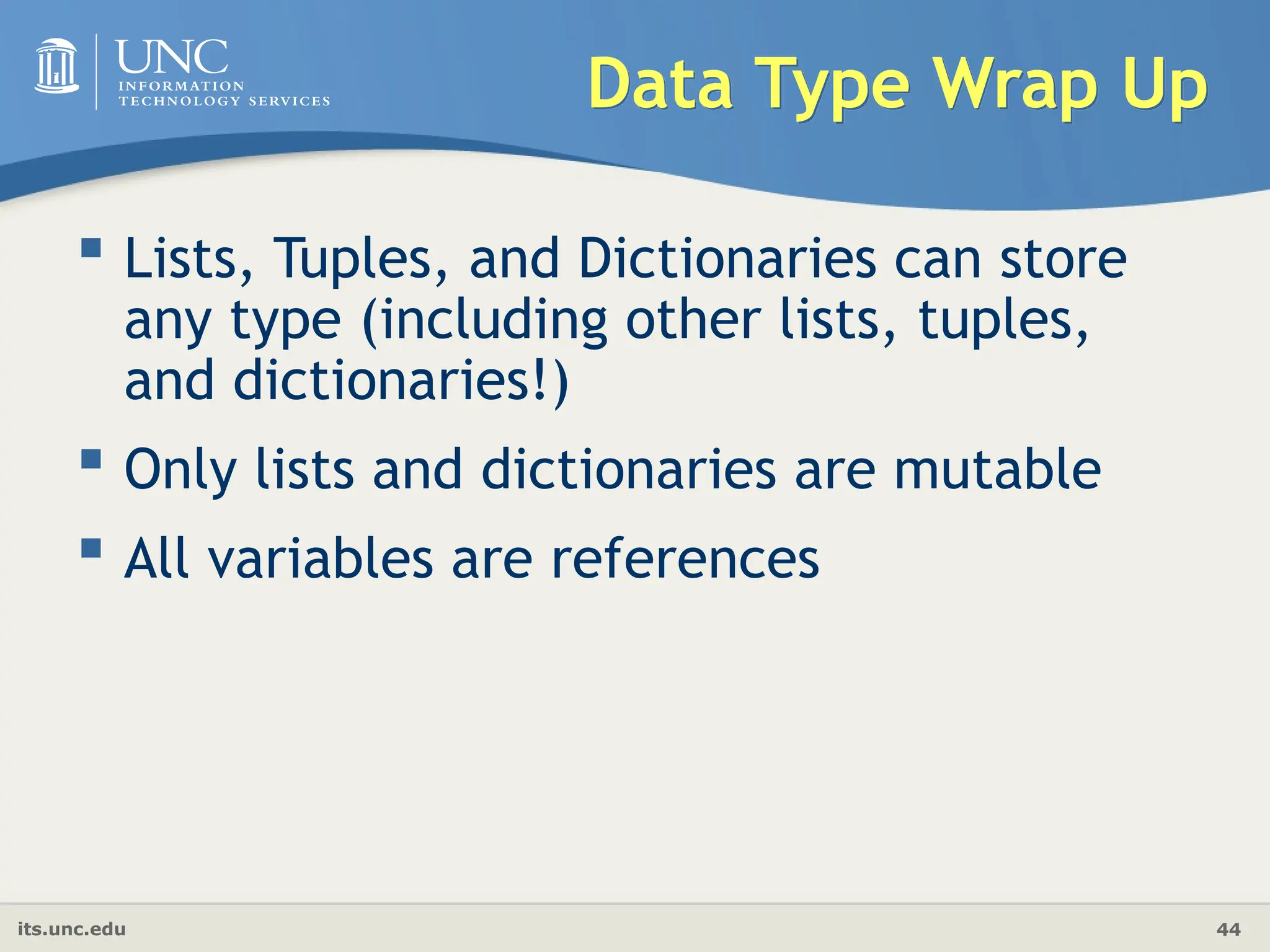
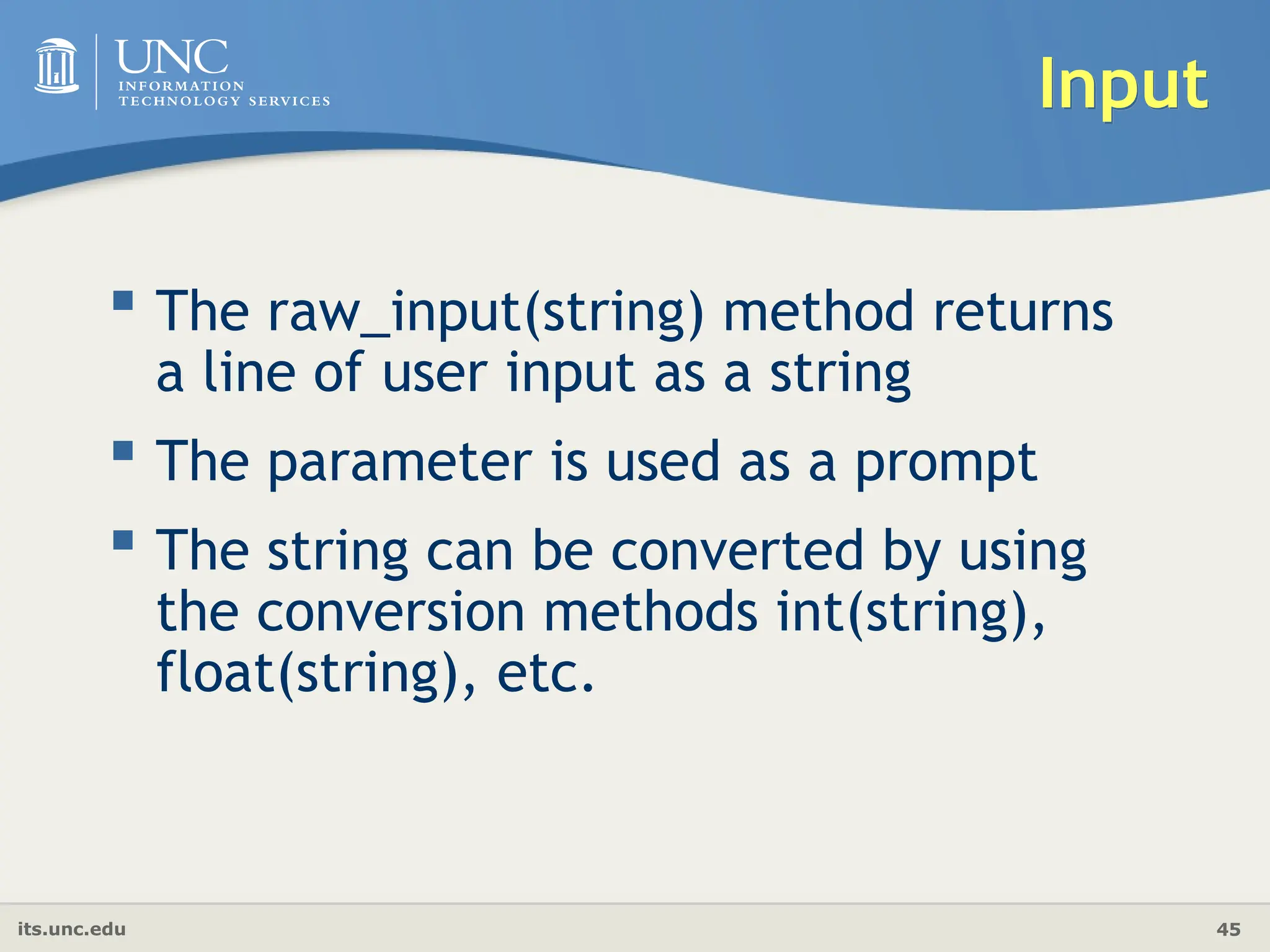
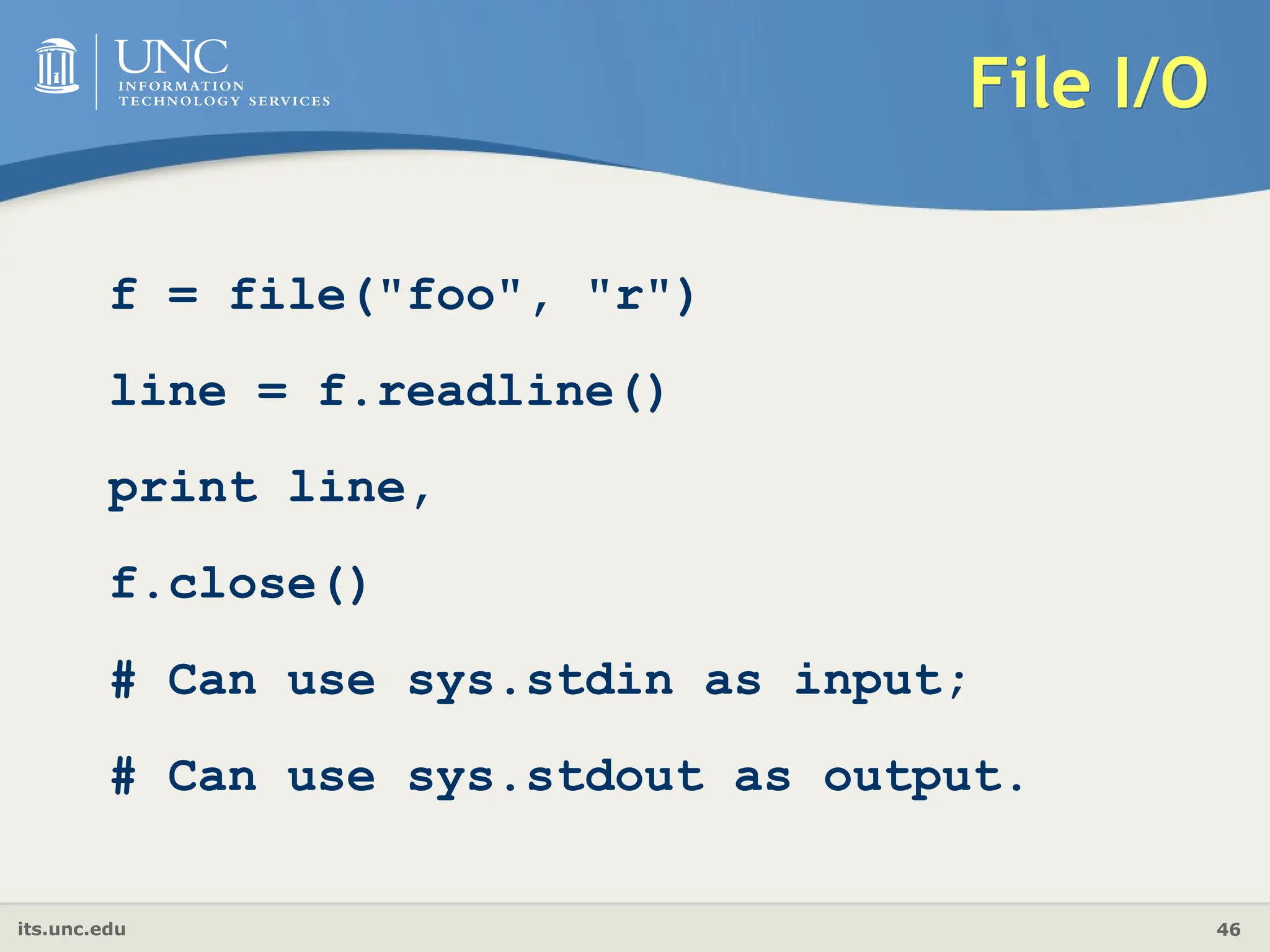
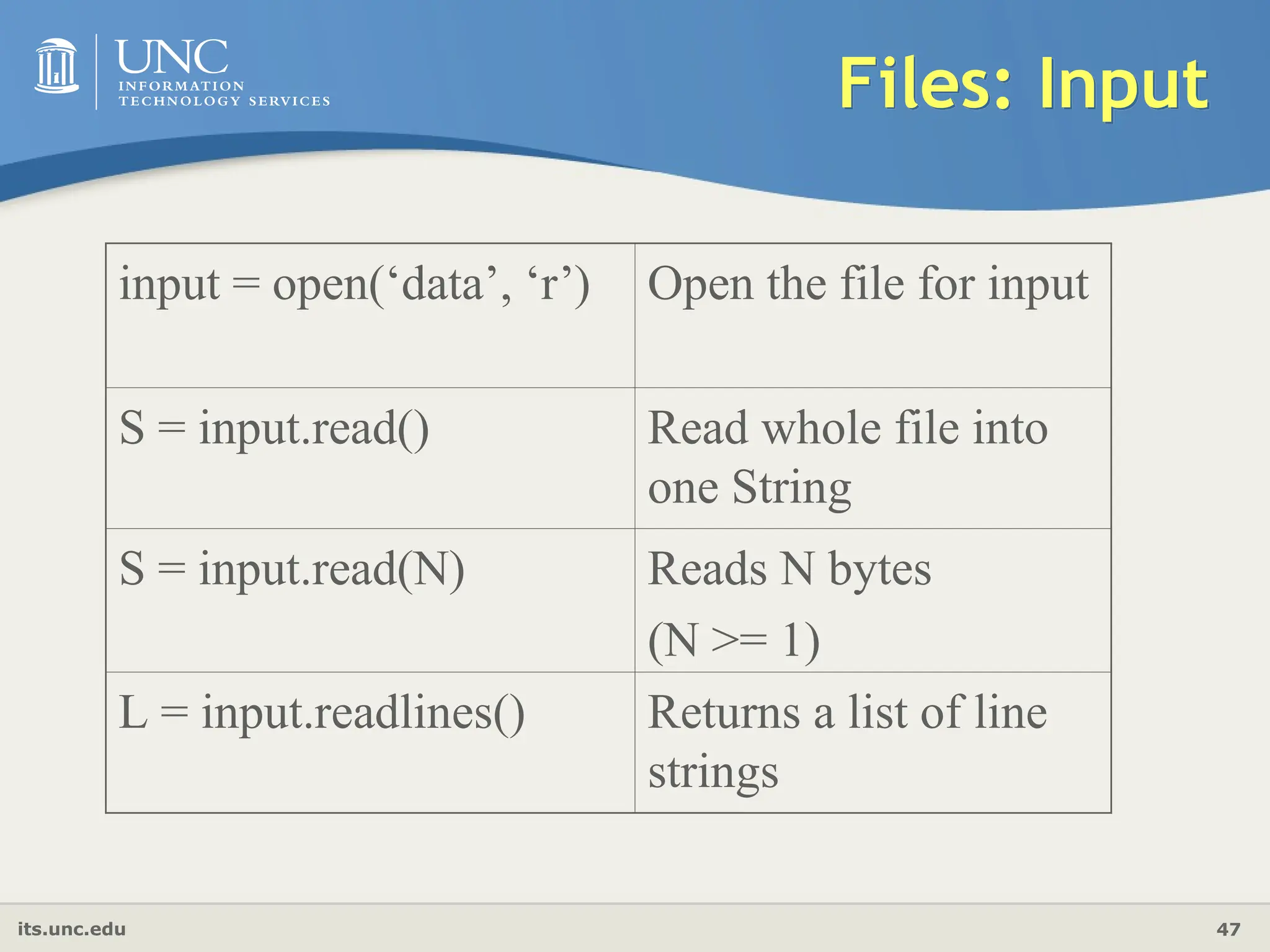
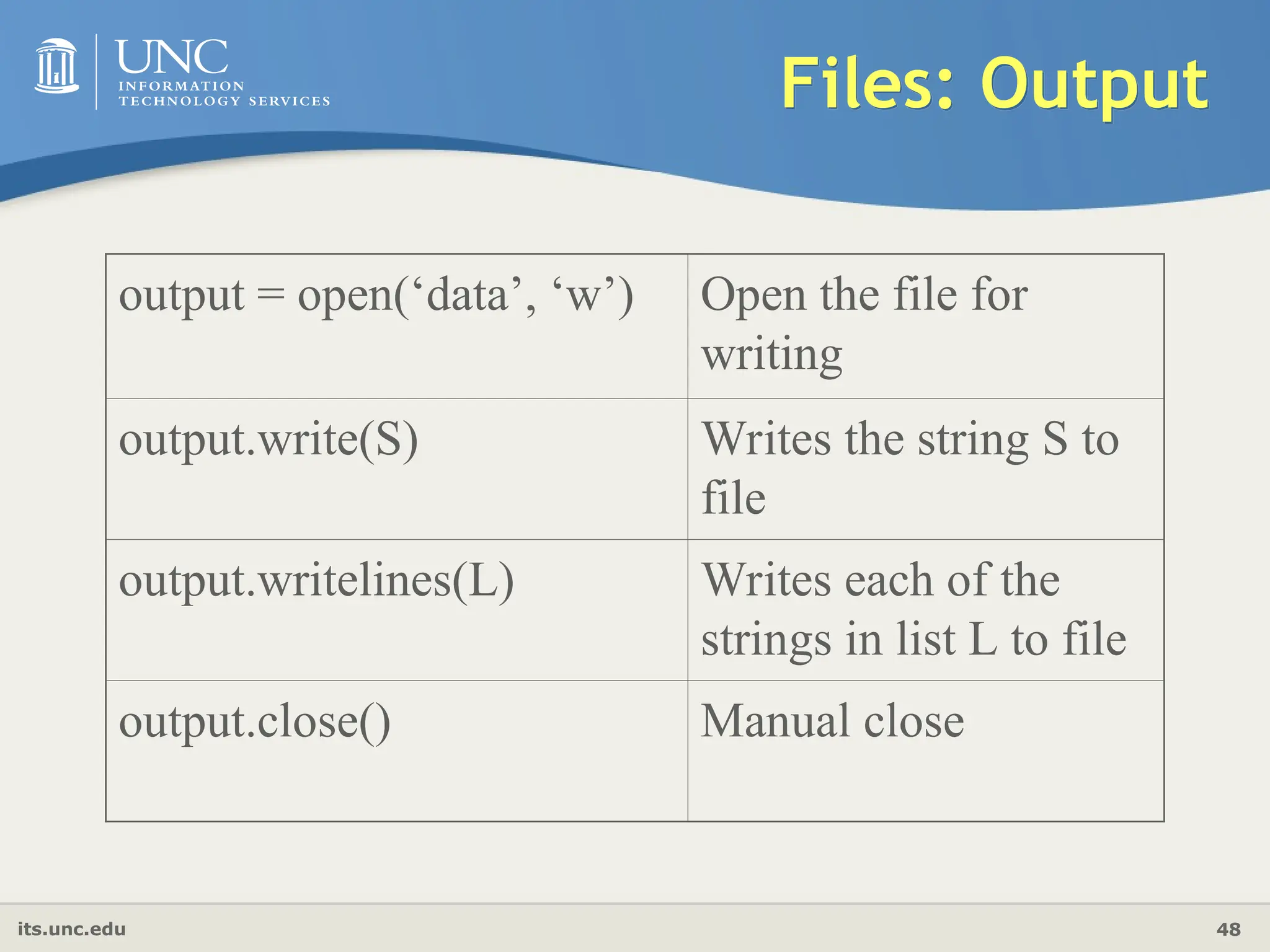
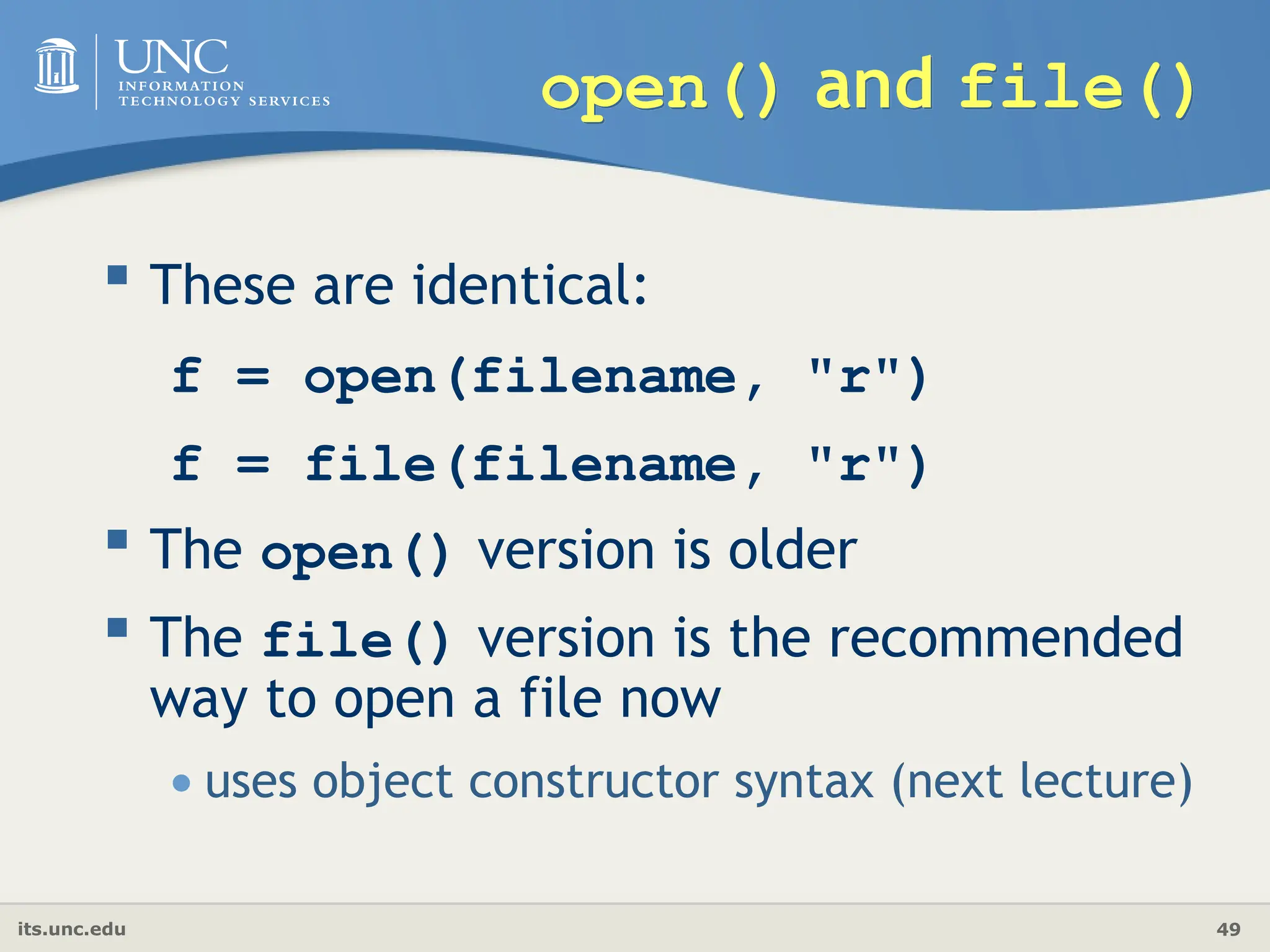
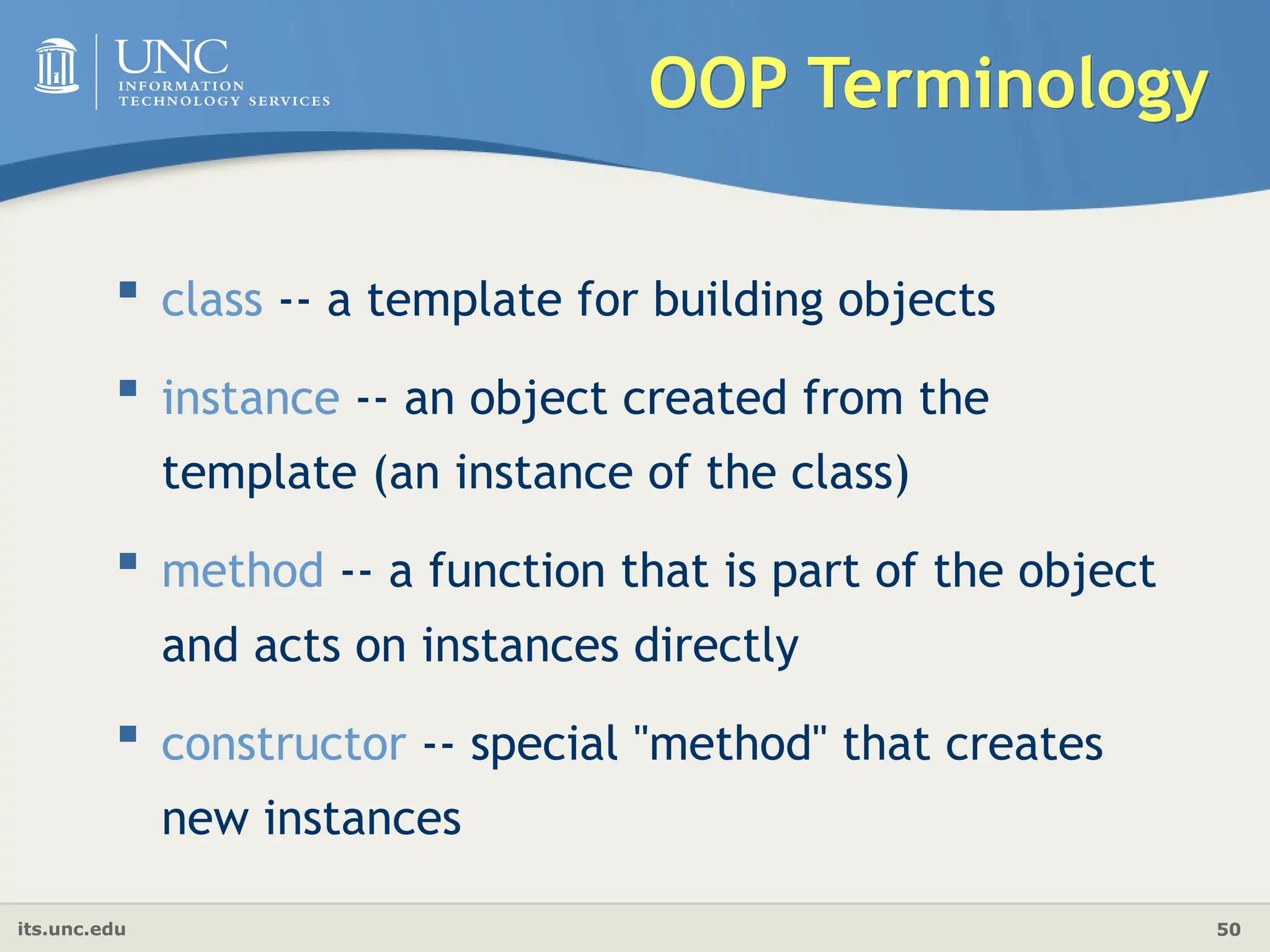
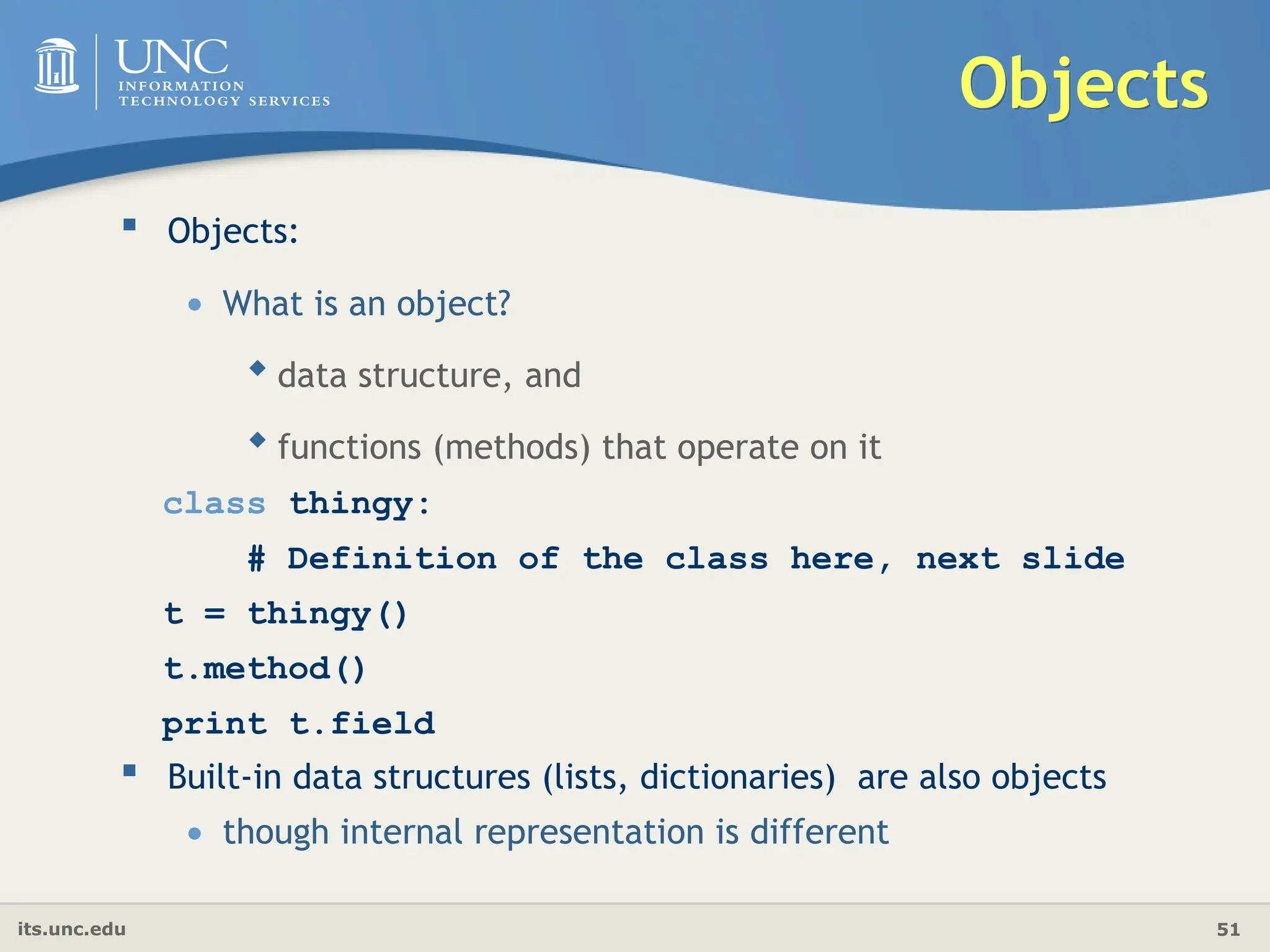
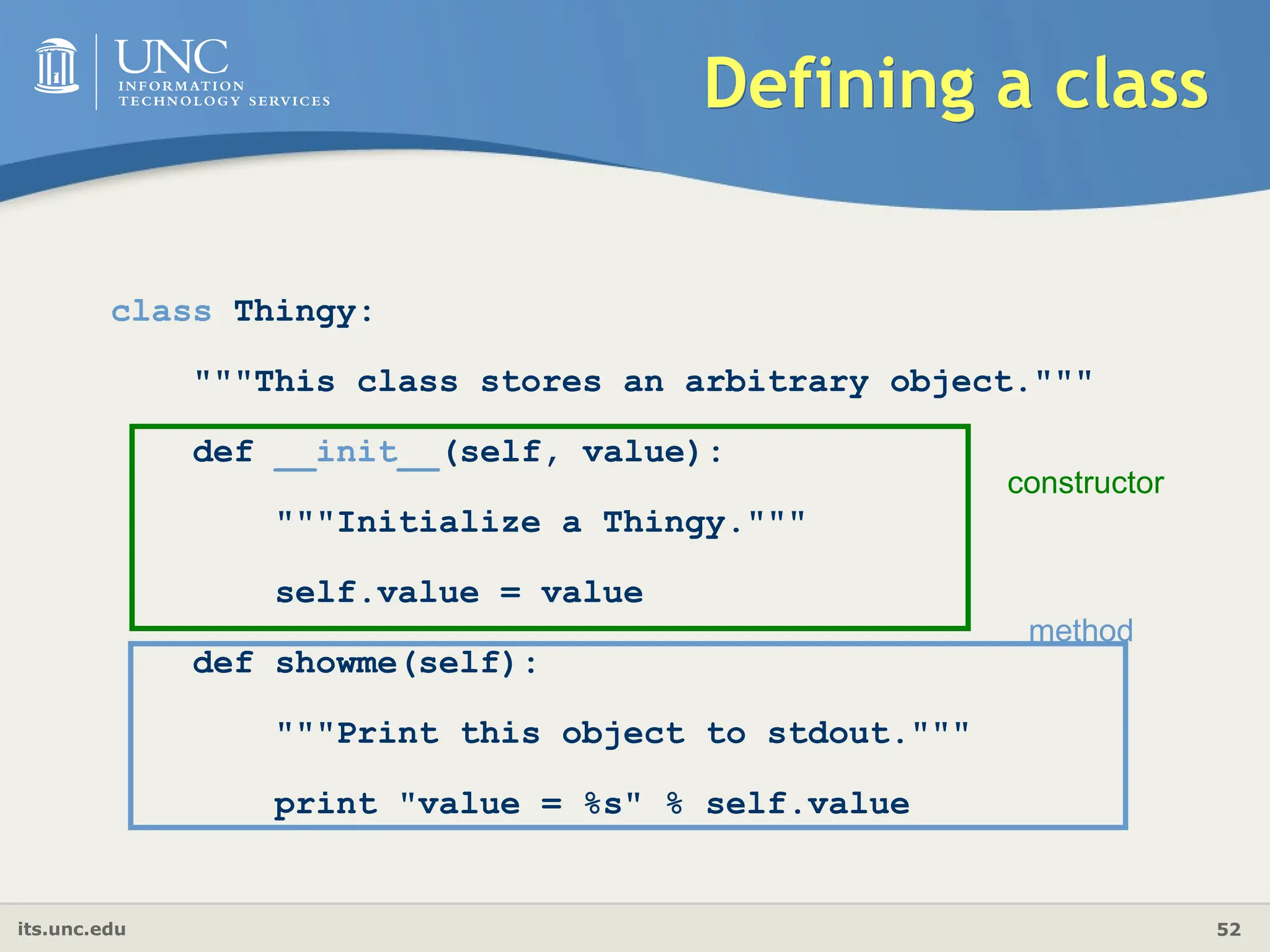
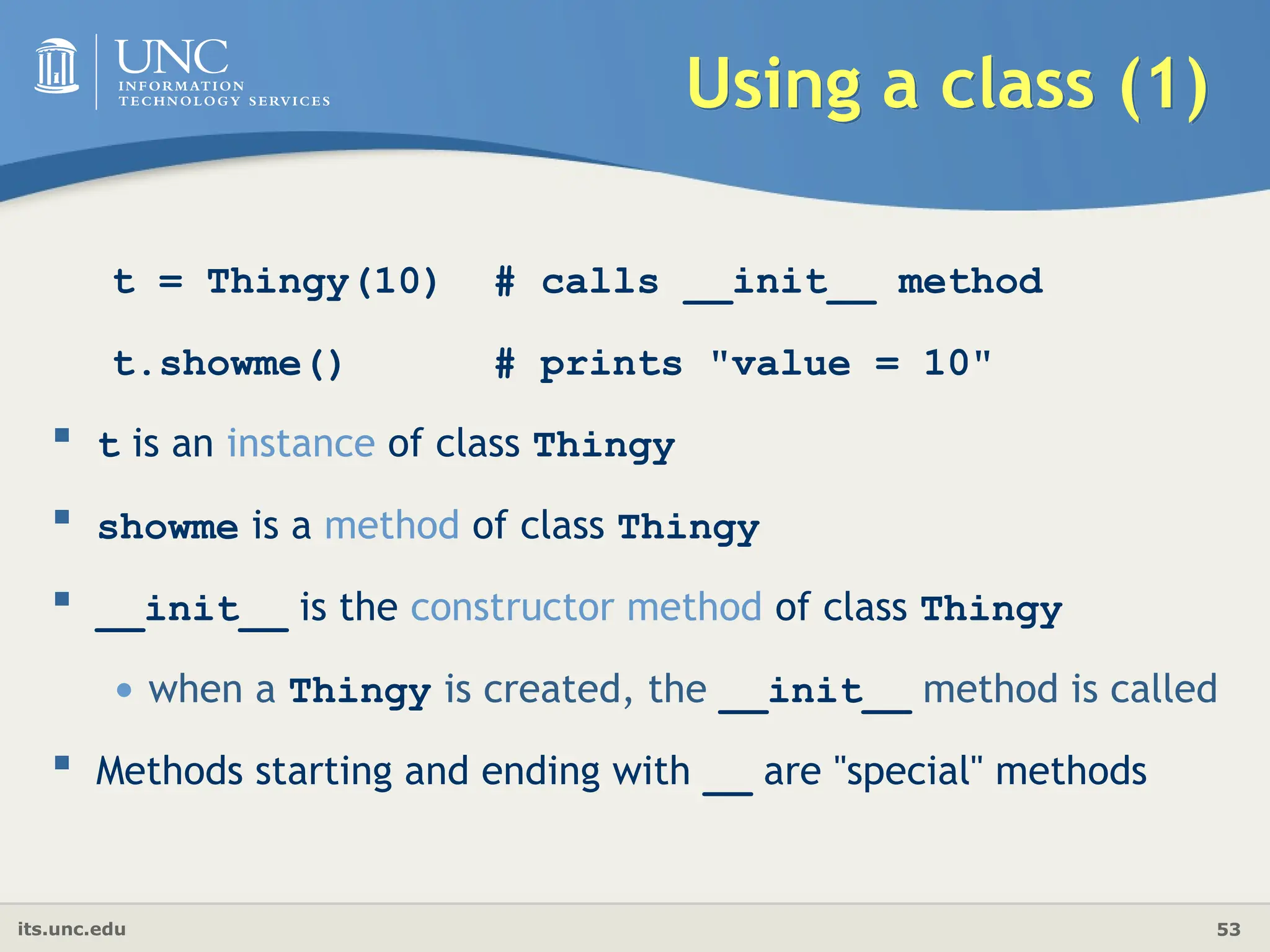
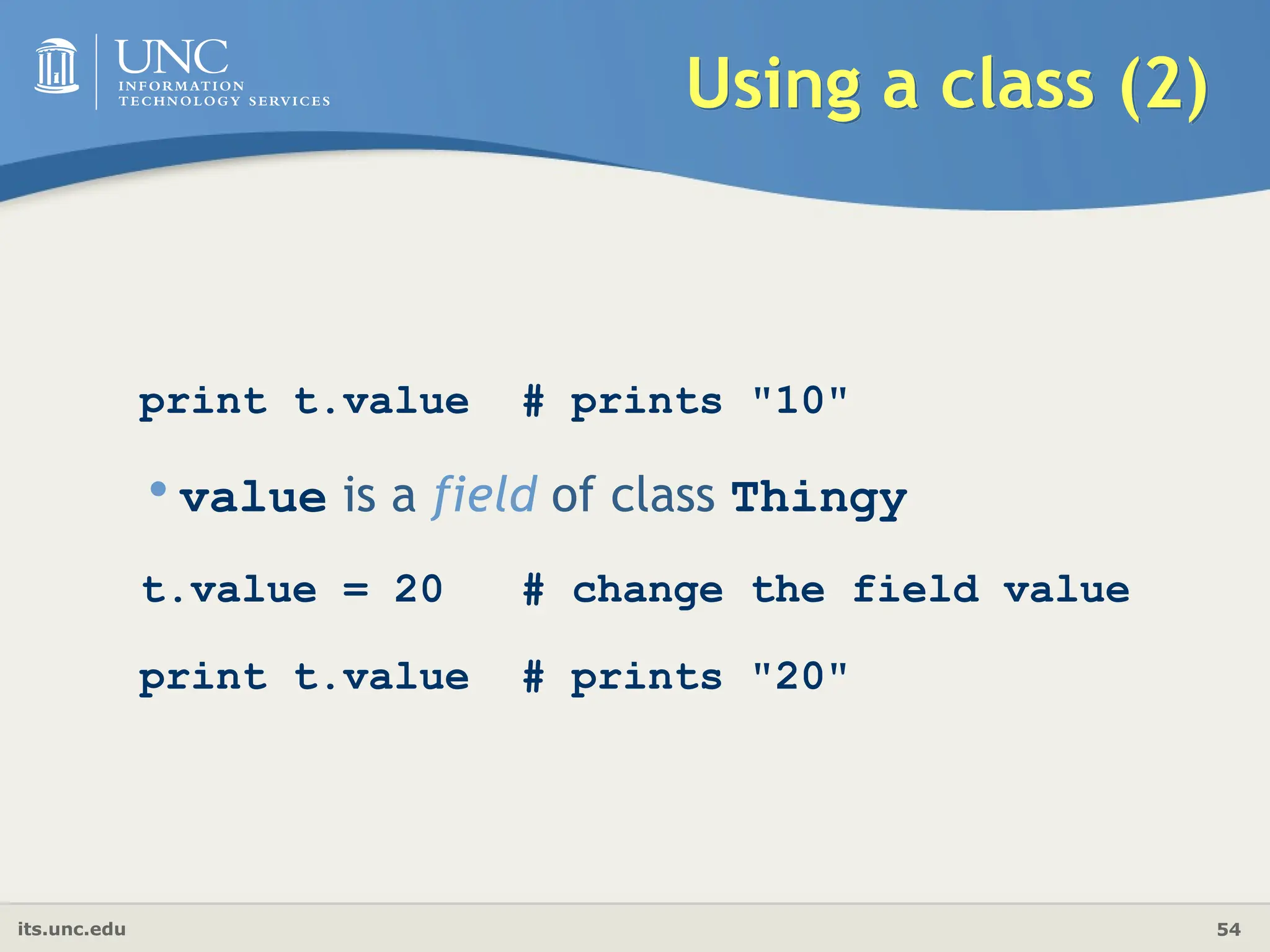
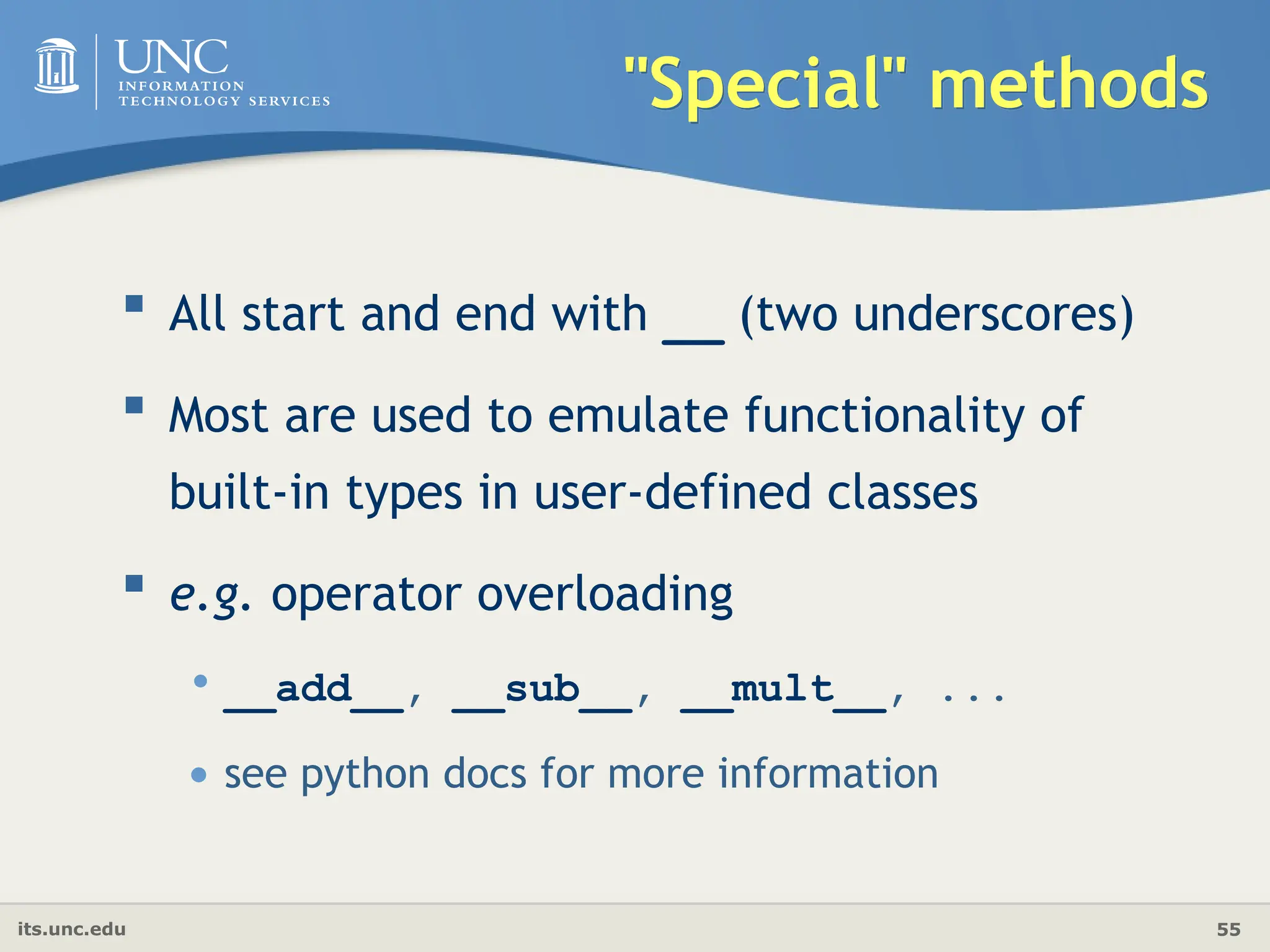
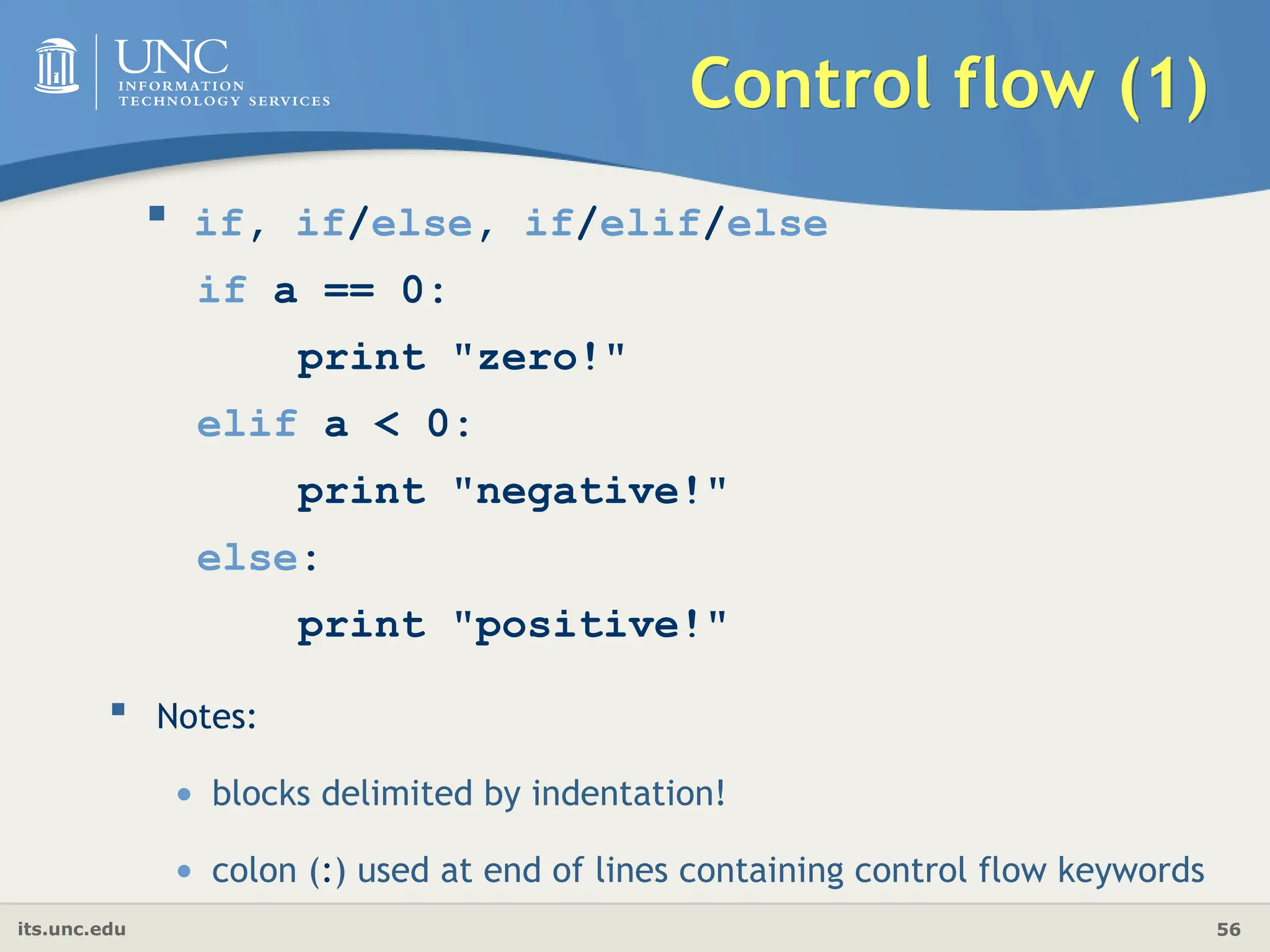
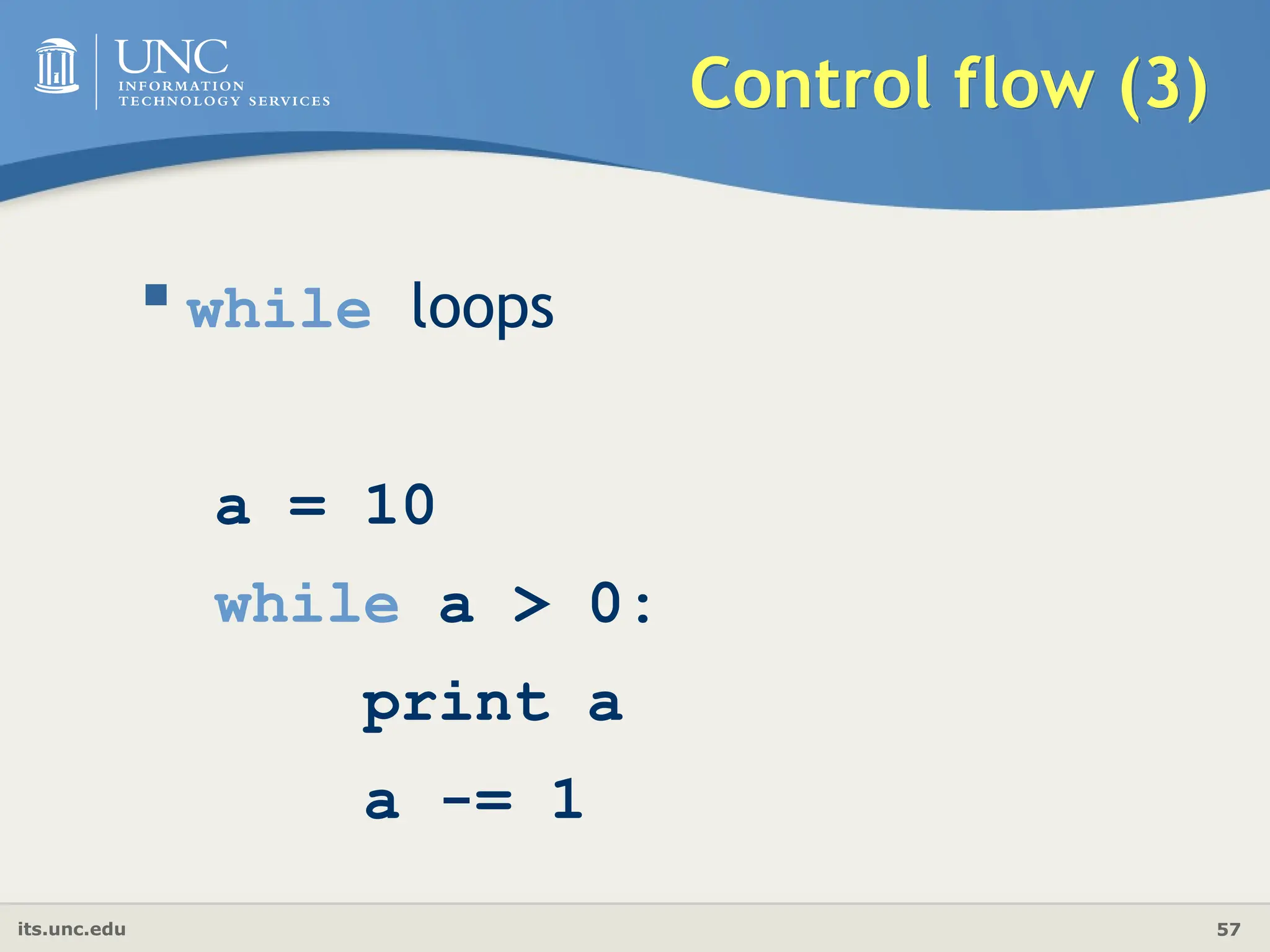
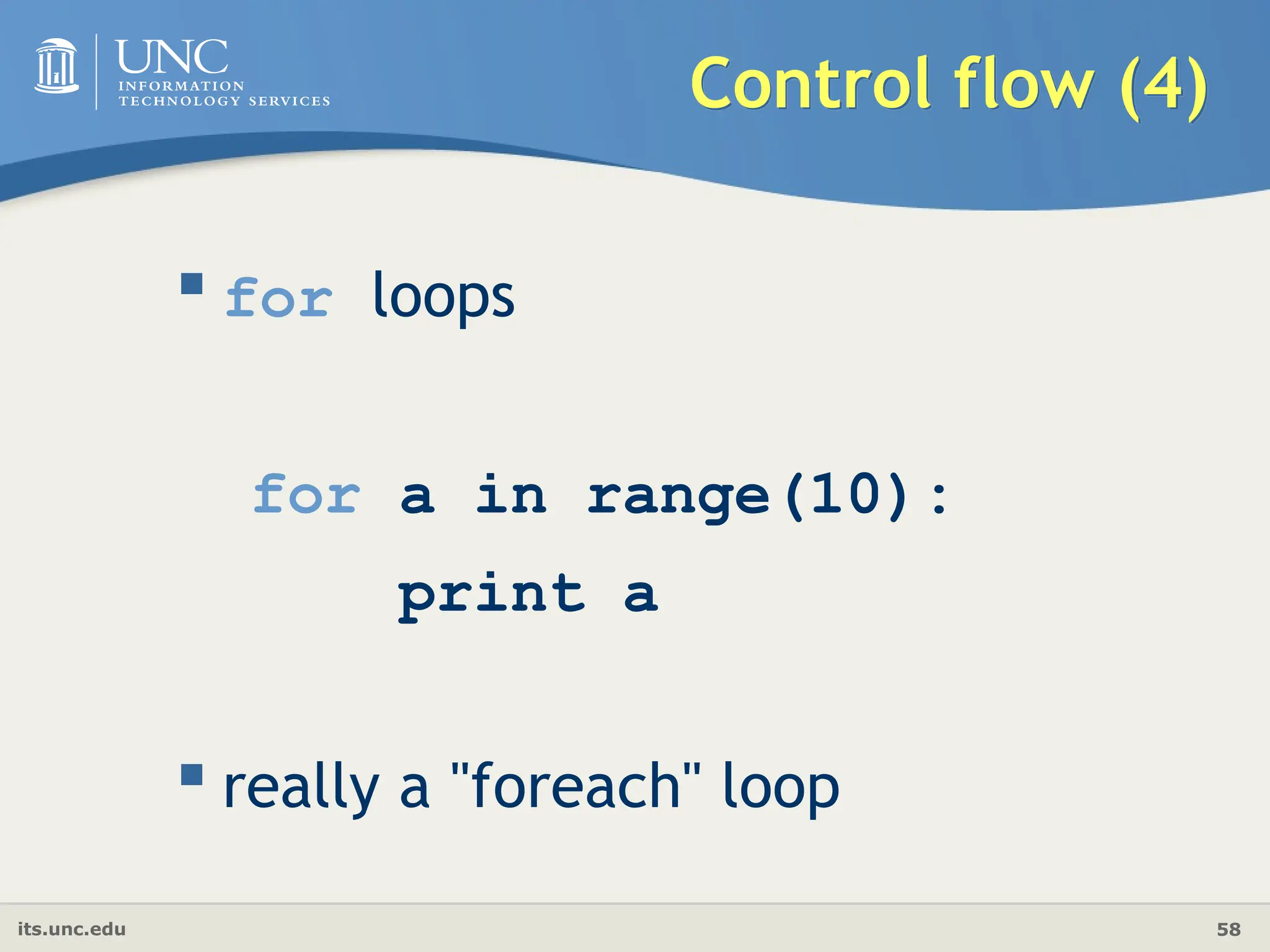
![its.unc.edu 59 Control flow (5) Common for loop idiom: a = [3, 1, 4, 1, 5, 9] for i in range(len(a)): print a[i]](https://image.slidesharecdn.com/pythonintro-250114132024-05f30ce6/75/iNTRODUCATION-TO-PYTHON-IN-PROGRAMMING-LANGUAGE-59-2048.jpg)
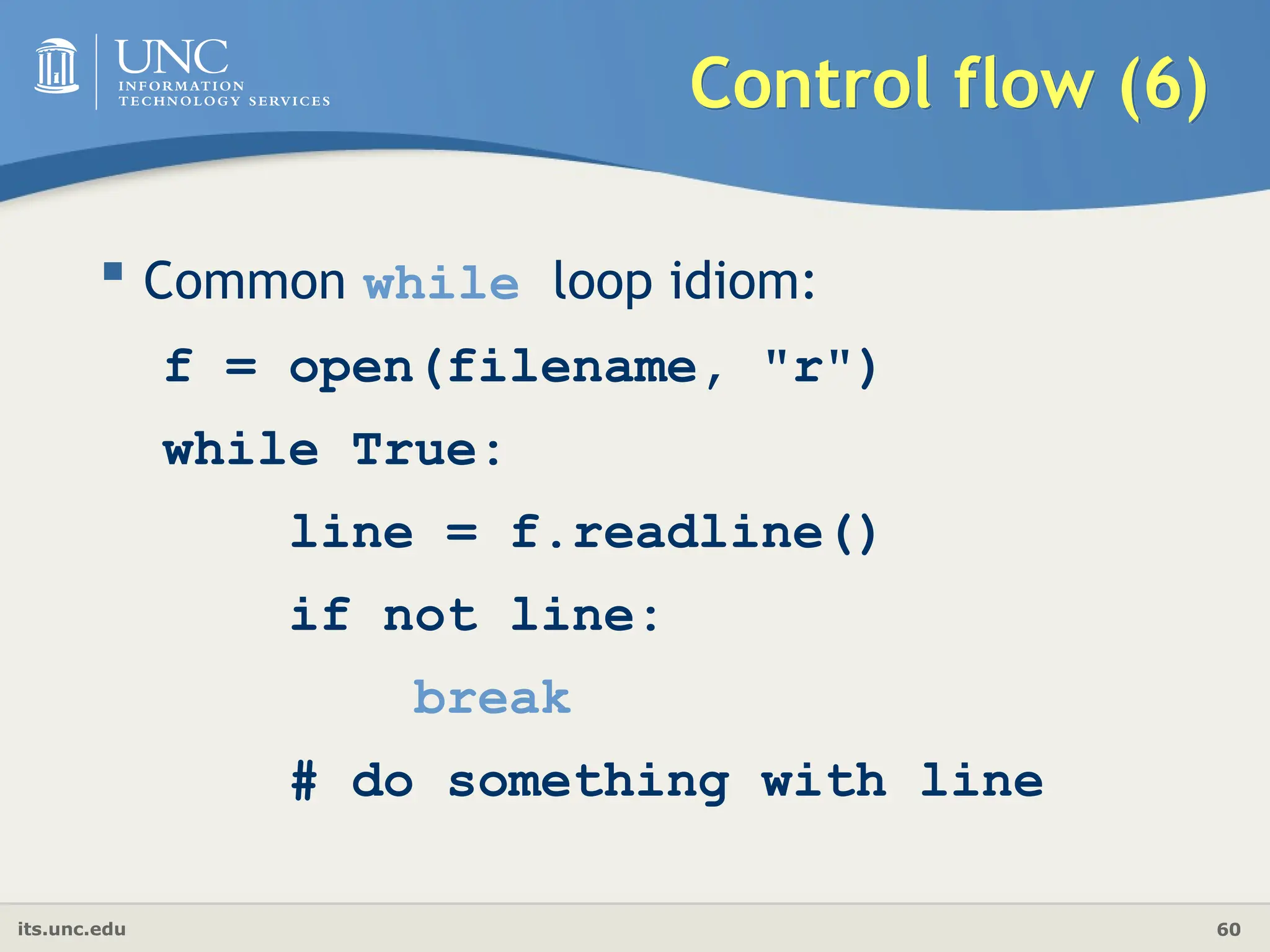
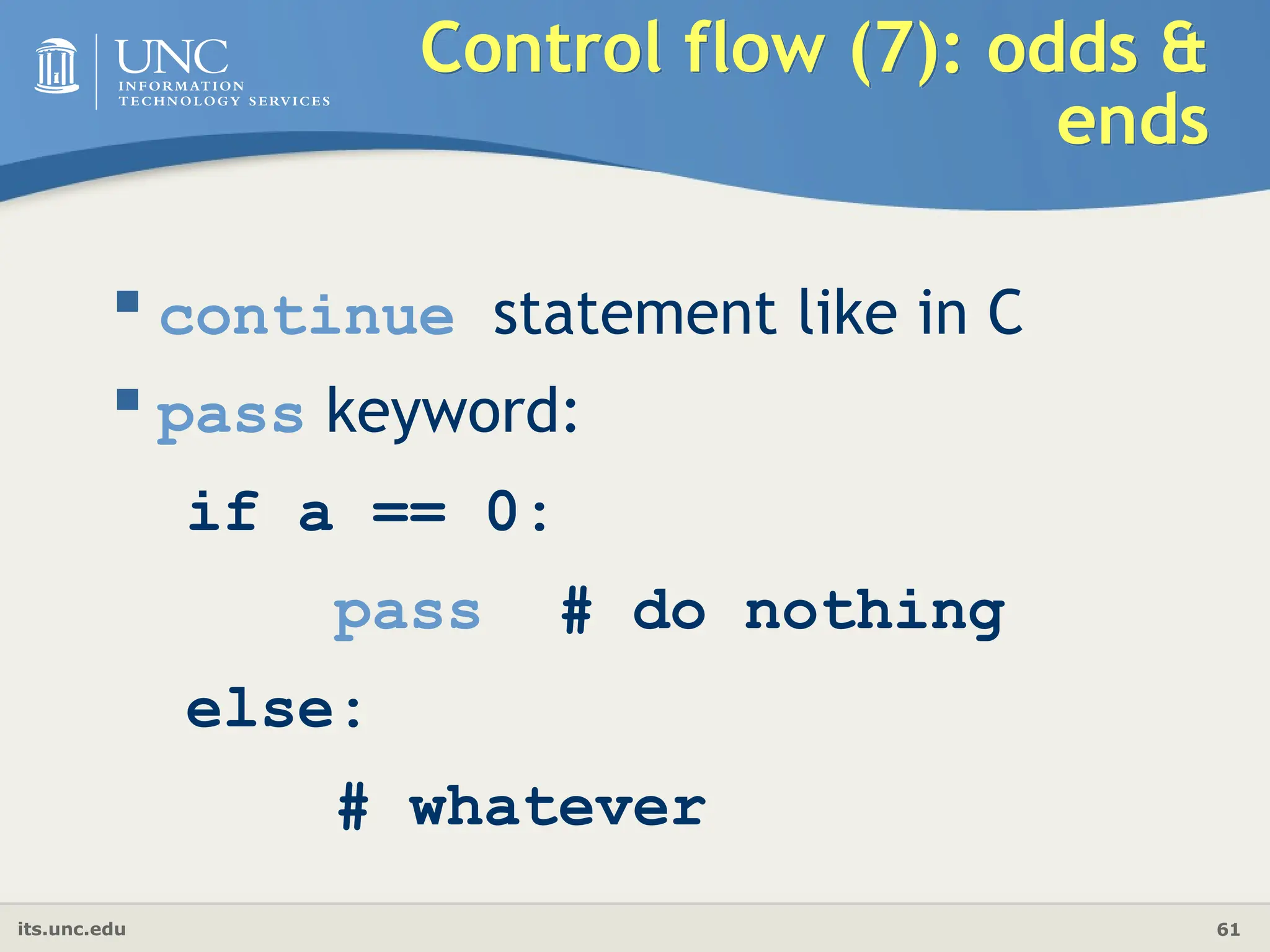
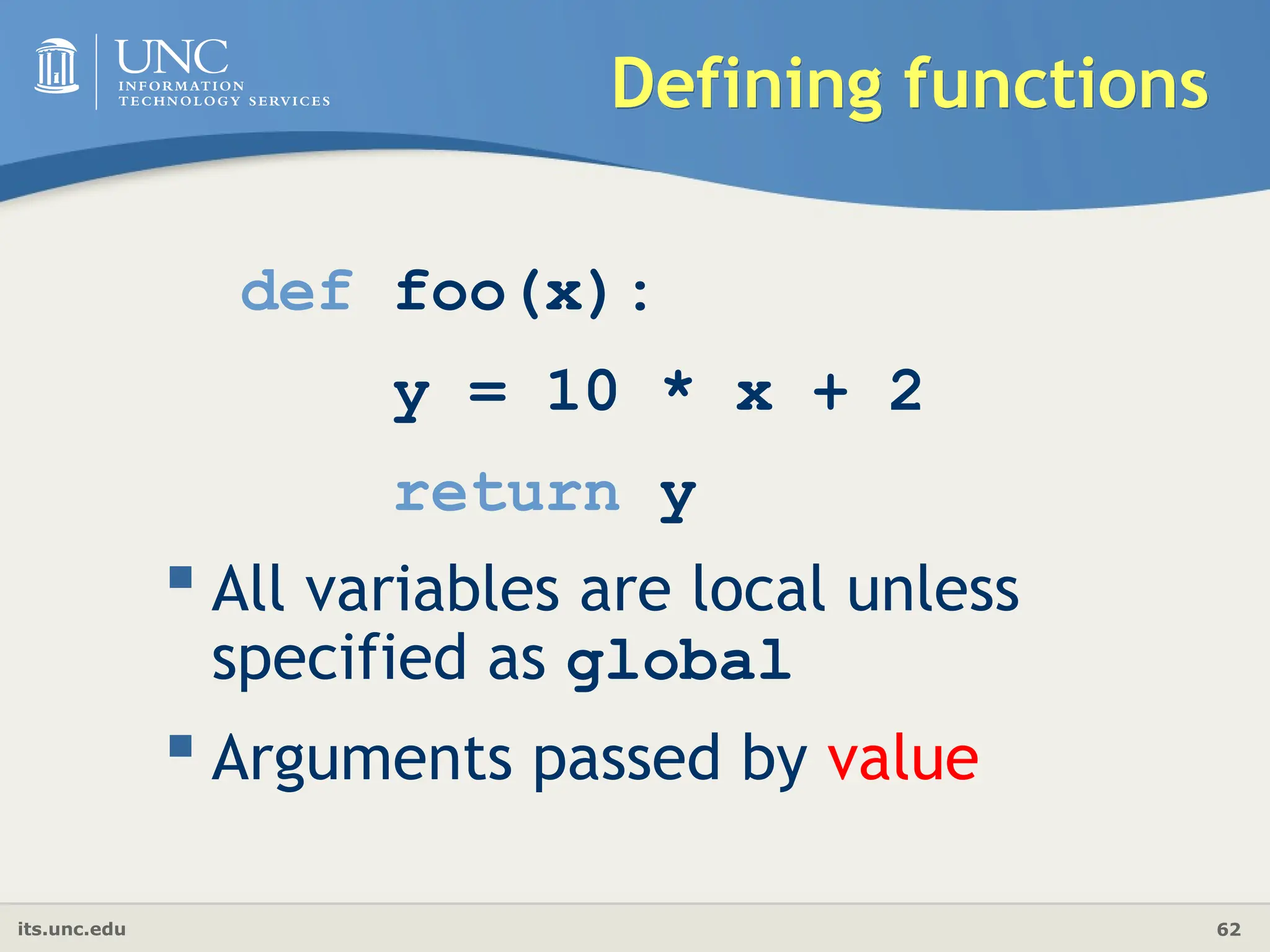
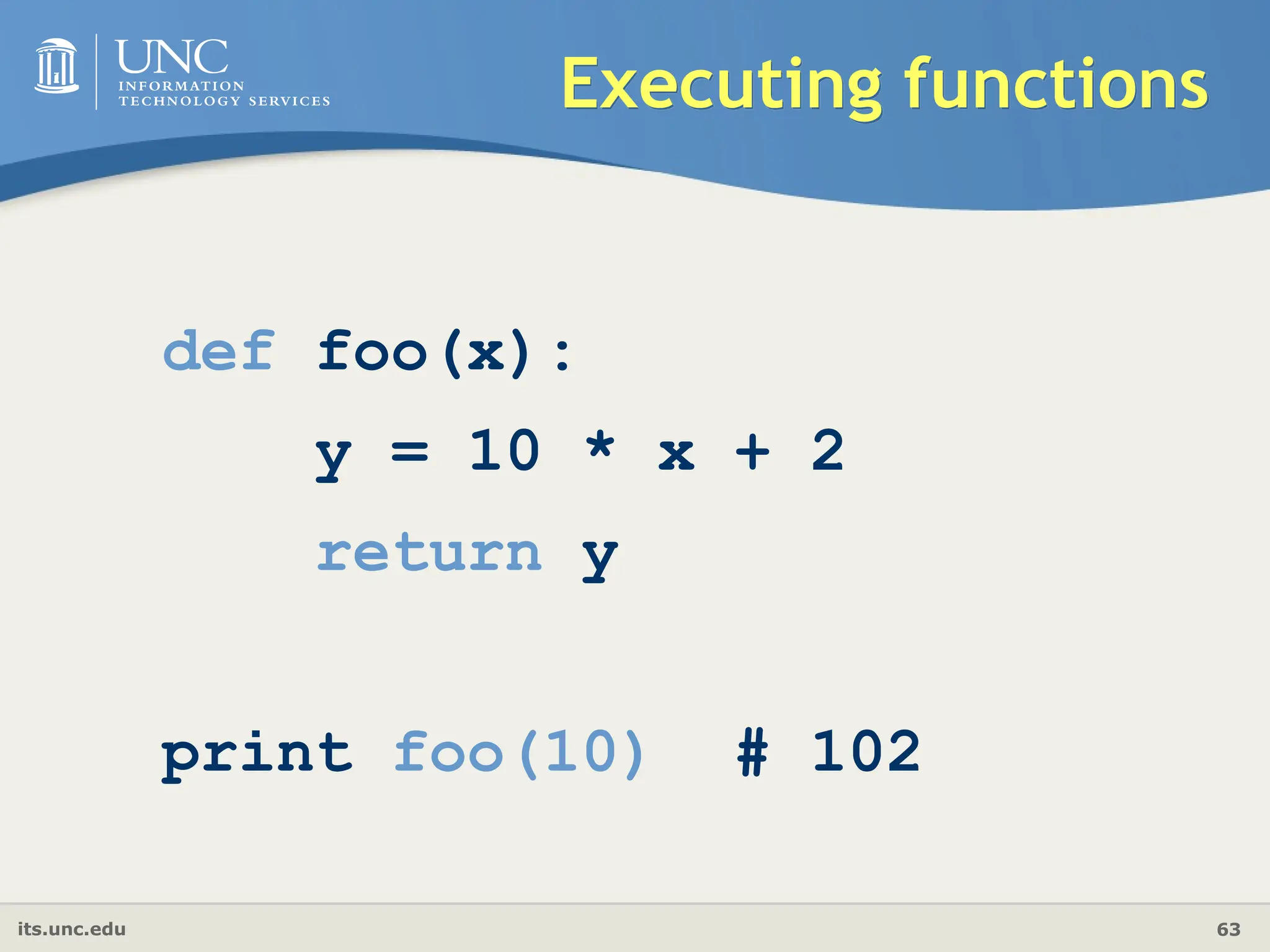
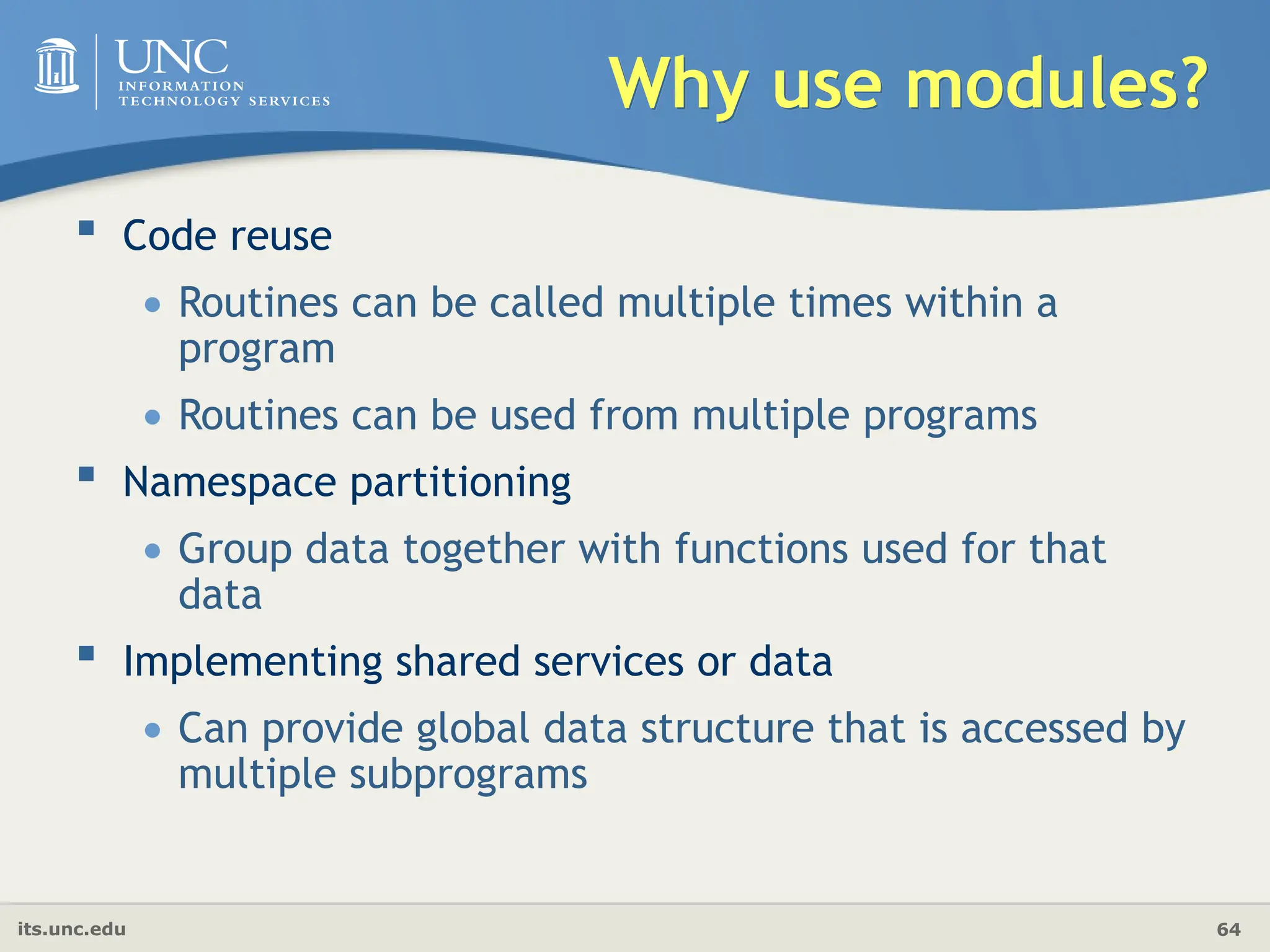
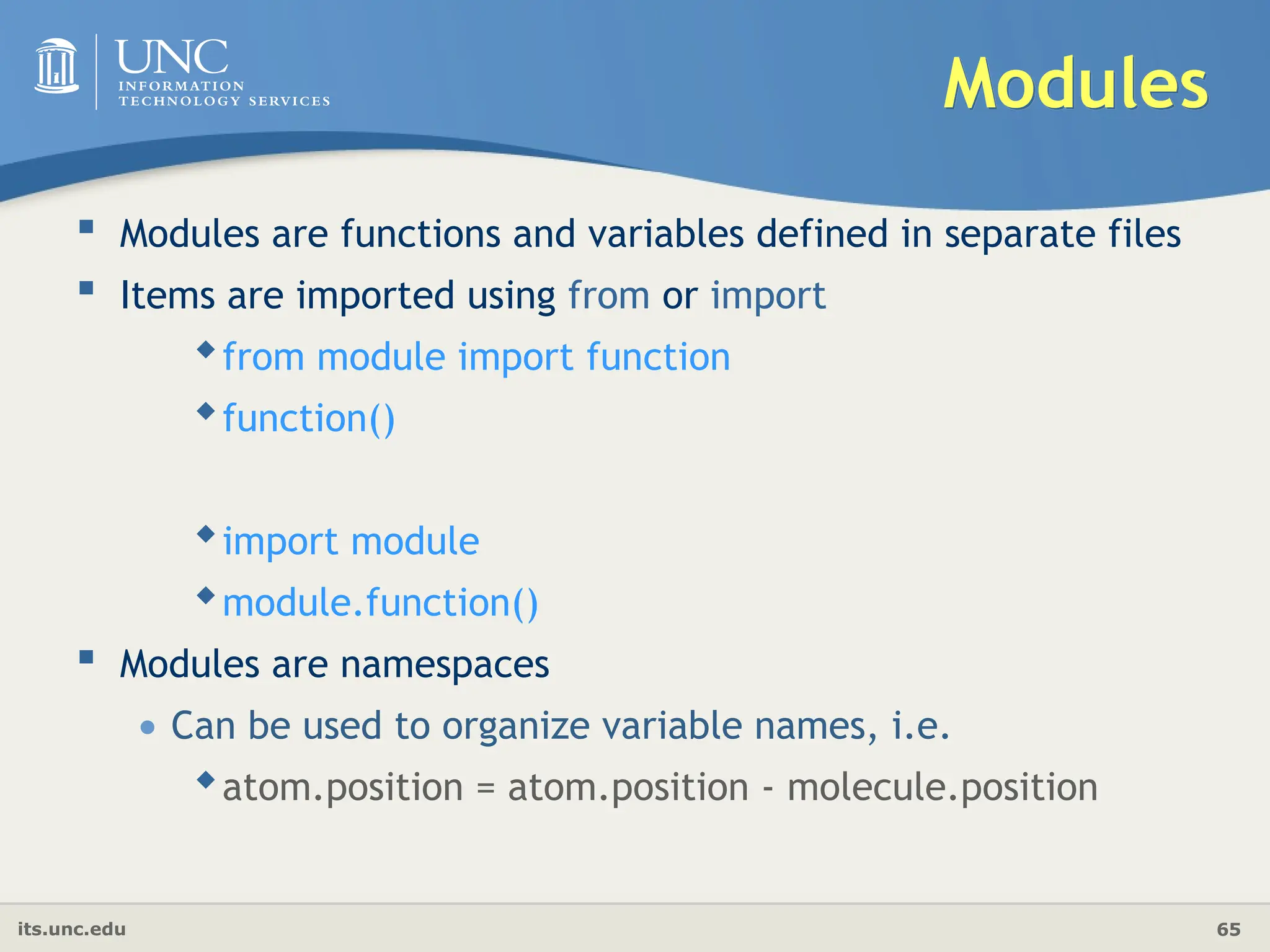
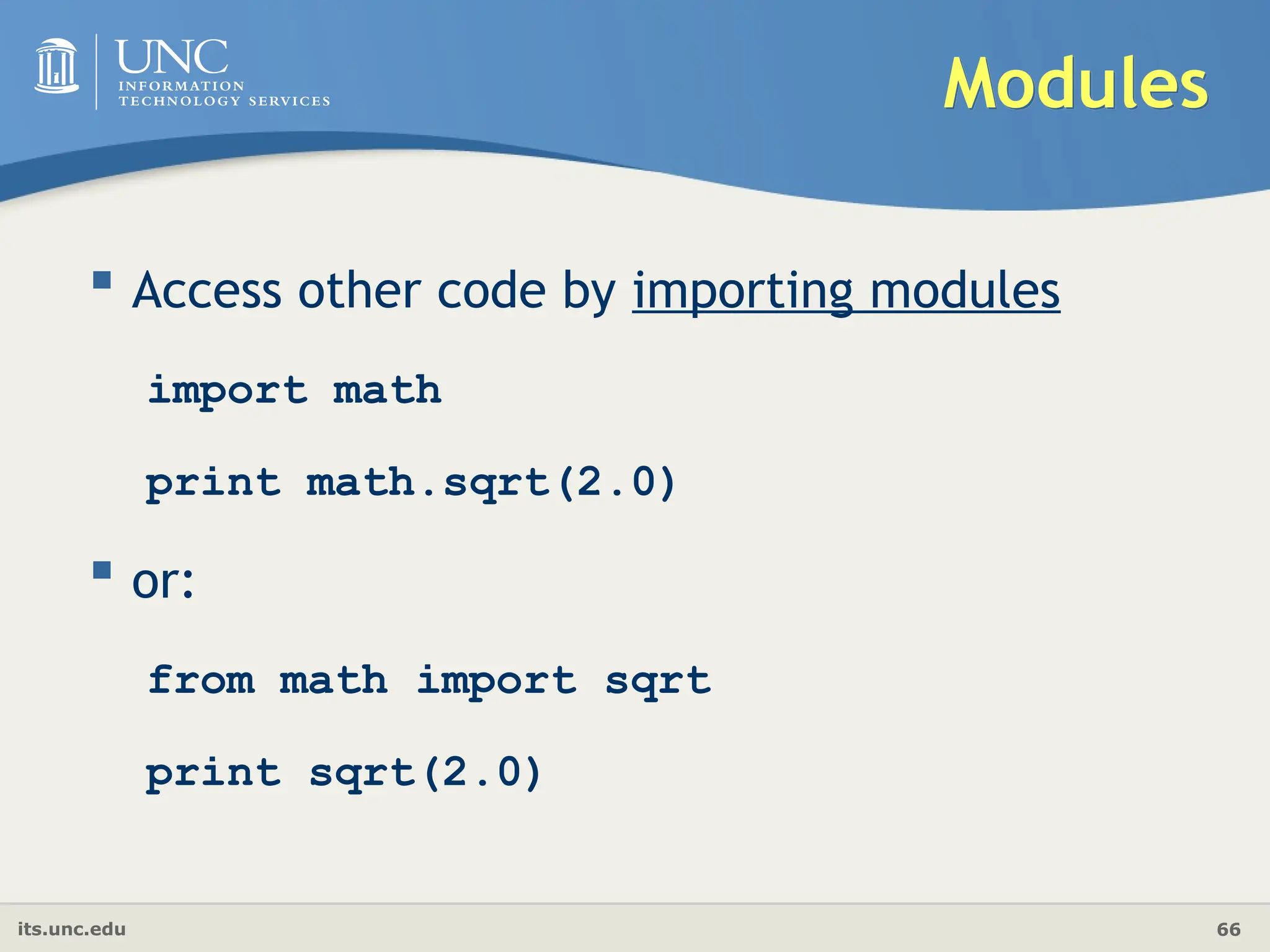
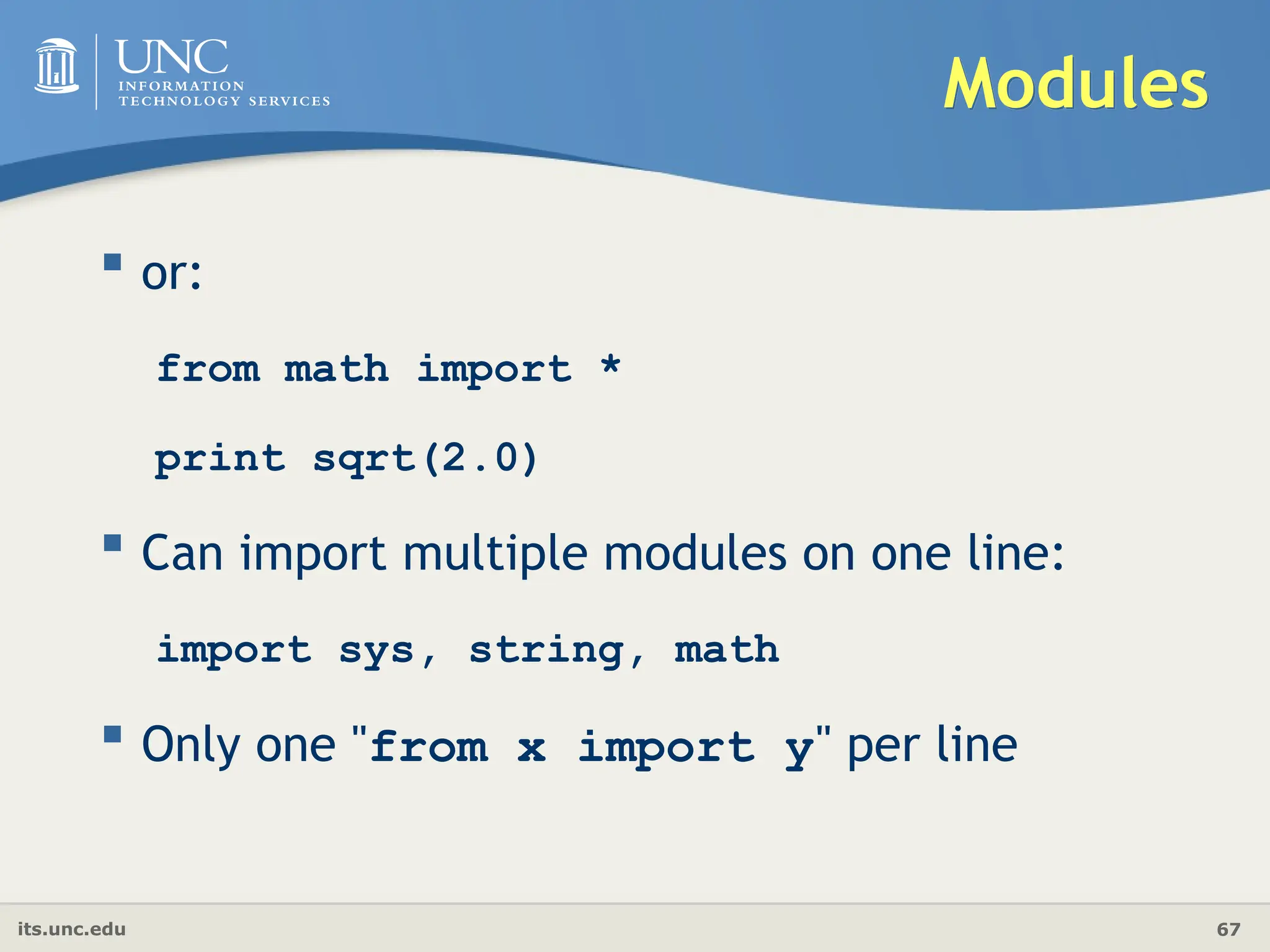
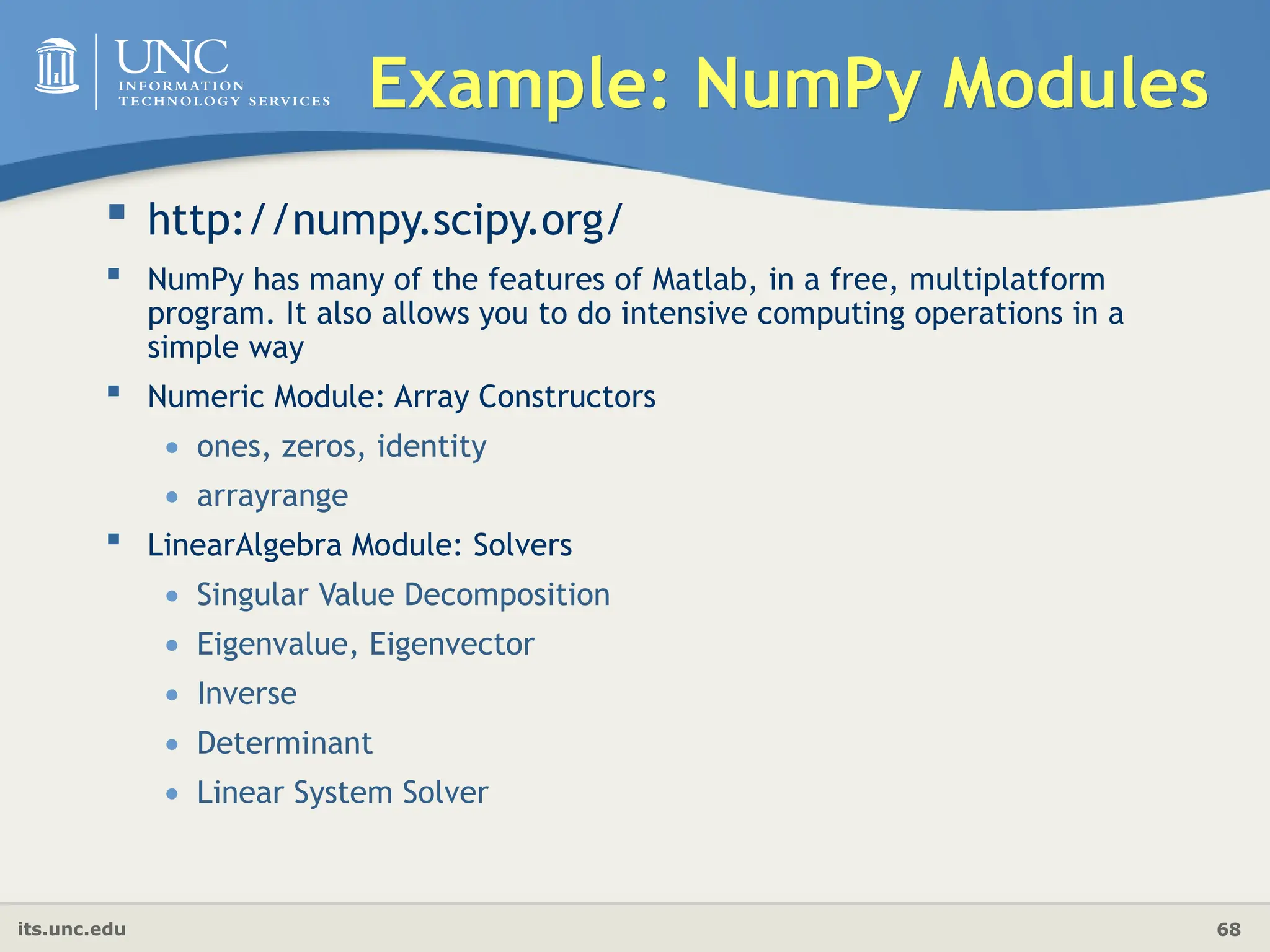
![its.unc.edu 69 Arrays and Constructors >>> a = ones((3,3),float) >>> print a [[1., 1., 1.], [1., 1., 1.], [1., 1., 1.]] >>> b = zeros((3,3),float) >>> b = b + 2.*identity(3) #"+" is overloaded >>> c = a + b >>> print c [[3., 1., 1.], [1., 3., 1.], [1., 1., 3.]]](https://image.slidesharecdn.com/pythonintro-250114132024-05f30ce6/75/iNTRODUCATION-TO-PYTHON-IN-PROGRAMMING-LANGUAGE-69-2048.jpg)
![its.unc.edu 70 Overloaded operators >>> b = 2.*ones((2,2),float) #overloaded >>> print b [[2.,2.], [2.,2.]] >>> b = b+1 # Addition of a scalar is >>> print b # element-by-element [[3.,3.], [3.,3.]] >>> c = 2.*b # Multiplication by a scalar is >>> print c # element-by-element [[6.,6.], [6.,6.]]](https://image.slidesharecdn.com/pythonintro-250114132024-05f30ce6/75/iNTRODUCATION-TO-PYTHON-IN-PROGRAMMING-LANGUAGE-70-2048.jpg)
![its.unc.edu 71 Array functions >>> from LinearAlgebra import * >>> a = zeros((3,3),float) + 2.*identity(3) >>> print inverse(a) [[0.5, 0., 0.], [0., 0.5, 0.], [0., 0., 0.5]] >>> print determinant(inverse(a)) 0.125 >>> print diagonal(a) [0.5,0.5,0.5] >>> print diagonal(a,1) [0.,0.] • transpose(a), argsort(), dot()](https://image.slidesharecdn.com/pythonintro-250114132024-05f30ce6/75/iNTRODUCATION-TO-PYTHON-IN-PROGRAMMING-LANGUAGE-71-2048.jpg)
![its.unc.edu 72 Eigenvalues >>> from LinearAlgebra import * >>> val = eigenvalues(c) >>> val, vec = eigenvectors(c) >>> print val [1., 4., 1.] >>> print vec [[0.816, -0.408, -0.408], [0.575, 0.577, 0.577], [-0.324, -0.487, 0.811]] • also solve_linear_equations, singular_value_decomposition, etc.](https://image.slidesharecdn.com/pythonintro-250114132024-05f30ce6/75/iNTRODUCATION-TO-PYTHON-IN-PROGRAMMING-LANGUAGE-72-2048.jpg)
![its.unc.edu 73 Least Squares Fitting Part of Hinsen's Scientific Python module >>> from LeastSquares import * >>> def func(params,x): # y=ax^2+bx+c return params[0]*x*x + params[1]*x + params[2] >>> data = [] >>> for i in range(10): data.append((i,i*i)) >>> guess = (3,2,1) >>> fit_params, fit_error = leastSquaresFit(func,guess,data) >>> print fit_params [1.00,0.000,0.00]](https://image.slidesharecdn.com/pythonintro-250114132024-05f30ce6/75/iNTRODUCATION-TO-PYTHON-IN-PROGRAMMING-LANGUAGE-73-2048.jpg)
![its.unc.edu 74 FFT >>> from FFT import * >>> data = array((1,0,1,0,1,0,1,0)) >>> print fft(data).real [4., 0., 0., 0., 4., 0., 0., 0.]] Also note that the FFTW package ("fastest Fourier transform in the West") has a python wrapper. See notes at the end Python Standard Libraries/Modules: • http://docs.python.org/library/ • http://its2.unc.edu/dci/dci_components/shared_apps/packages /python_packages.html • http://pypi.python.org/pypi/](https://image.slidesharecdn.com/pythonintro-250114132024-05f30ce6/75/iNTRODUCATION-TO-PYTHON-IN-PROGRAMMING-LANGUAGE-74-2048.jpg)
![its.unc.edu 75 Command-line arguments import sys print len(sys.argv) # NOT argc # Print all arguments: print sys.argv # Print all arguments but the program # or module name: print sys.argv[1:] # "array slice"](https://image.slidesharecdn.com/pythonintro-250114132024-05f30ce6/75/iNTRODUCATION-TO-PYTHON-IN-PROGRAMMING-LANGUAGE-75-2048.jpg)
